代人问个问题,安培检测器和电导检测器不同吧?有没有版友的离子色谱配的是安培检测器?离子色谱的检测器有几种类型啊?
离子色谱安培检测器能检测哪些离子?
各位老师,[url=https://insevent.instrument.com.cn/t/3p][color=#3333ff]离子色谱[/color][/url]脉冲安培检测器基线不稳定是什么原因?
想了解下配脉冲安培检测器的[url=https://insevent.instrument.com.cn/t/3p][color=#3333ff]离子色谱[/color][/url]多吗?北京地区有哪家不错的可对外使用?因为在糖测定上有优势,一直在关注中.
[url=https://insevent.instrument.com.cn/t/3p][color=#3333ff]离子色谱[/color][/url]安培检测器的单位中文名称是啥?
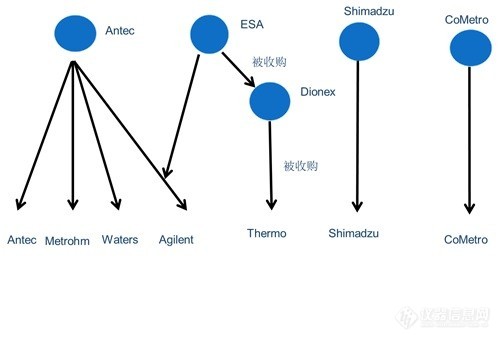
[align=left][font='Times New Roman','serif']5.3 [/font][font=宋体]安培检测器[/font][/align][align=left][font='Times New Roman','serif']5.3.1 [/font][font=宋体]安培检测器的发展历史[/font][/align][font='Times New Roman','serif']5.3.2 [/font][font=宋体]国内外主要安培检测器厂家[/font][align=left][font='Times New Roman','serif']5.3.3 [/font][font=宋体]安培检测器的原理[/font][/align][font='Times New Roman','serif']5.3.3.1 [/font][font=宋体]伏安法[/font][font='Times New Roman','serif']5.3.3.2 [/font][font=宋体]直流安培法([/font][font='Times New Roman','serif']Direct amperometric detection[/font][font=宋体],[/font][font='Times New Roman','serif']DC[/font][font=宋体])[/font][b]5.3.3.3 [font=宋体]脉冲安培法([/font]Pulsedamperometric detection, PAD[font=宋体])[/font]5.3.3.4 [font=宋体]积分安培法([/font]Integratedpulsed amperometric detection, IPAD[font=宋体])[/font]5.3.3.5 [font=宋体]迟滞时间[/font]5.3.3.6 [font=宋体]电位极限[/font][/b][font='Times New Roman','serif']5.3.4 [/font][font=宋体]安培检测器各组成的结构[/font][b]5.3.4.1 [font=宋体]安培池的结构[/font]5.3.4.2 [font=宋体]热电(戴安)安培检测器(池)的结构[/font][/b][font='Times New Roman','serif']5.3.4.3 [/font][font=宋体]万通安培检测器(池)的结构[/font][font='Times New Roman','serif']5.3.4.4 Antec [/font][font=宋体]安培检测器(池)的结构[/font][font='Times New Roman','serif']5.3.4.5 [/font][font=宋体]工作电极[/font][font='Times New Roman','serif']5.3.4.6 [/font][font=宋体]参比电极[/font][font='Times New Roman','serif']5.3.4.7 [/font][font=宋体]膜片[/font][font='Times New Roman','serif']5.3.5 [/font][font=宋体]薄层式安培池检测响应的关系[/font][font='Times New Roman','serif']5.3.6[/font][font=宋体]安培检测器的应用[/font][b]5.3.6.1 [font=宋体][url=https://insevent.instrument.com.cn/t/3p][color=#3333ff]离子色谱[/color][/url][/font]-[font=宋体]直流安培检测技术([/font]IC-CP[font=宋体])[/font]5.3.6.2 [font=宋体][url=https://insevent.instrument.com.cn/t/3p][color=#3333ff]离子色谱[/color][/url][/font]-[font=宋体]脉冲安培检测技术([/font]IC-PAD[font=宋体])[/font]5.3.6.3[font=宋体][url=https://insevent.instrument.com.cn/t/3p][color=#3333ff]离子色谱[/color][/url][/font]-[font=宋体]积分脉冲安培检测技术([/font]IC-IPAD[font=宋体])[/font]5.3.7 [font=宋体]安培检测器各部件的使用和维护[/font]5.3.7.1 [font=宋体]热电安培检测器的使用和维护[/font]5.3.7.2 [font=宋体]万通安培检测器的使用和维护[/font]5.3.8 [font=宋体]安培检测器的故障判断和注意事项[/font][font=宋体][/font][font=宋体][/font][/b][align=left][font='Times New Roman','serif']5.3.1 [/font][font=宋体]安培检测器的发展历史[/font][/align][font=宋体]电化学检测的起源可追溯到[/font][font='Times New Roman','serif']20[/font][font=宋体]世纪初,当时为了发展碳氢燃料,研究了对污染的贵金属电极的再活化。[/font][font='Times New Roman','serif']1924[/font][font=宋体]年,[/font][font='Times New Roman','serif']Hammett[/font][font=宋体]等[/font][sup][font='Times New Roman','serif'][15][/font][/sup][font=宋体]首先对[/font][font='Times New Roman','serif']Pt[/font][font=宋体]电极施加脉冲电势对其进行清洗。[/font][font='Times New Roman','serif']Armstrong[sup][16][/sup][/font][font=宋体]在[/font][font='Times New Roman','serif']1934[/font][font=宋体]年分别将脉冲电位用于[/font][font='Times New Roman','serif']H[sub]2[/sub][/font][font=宋体]的阳极氧化和[/font][font='Times New Roman','serif']O[sub]2[/sub][/font][font=宋体]的阴极还原。[/font][font='Times New Roman','serif']Kolthoff[/font][font=宋体]和[/font][font='Times New Roman','serif']Tanaka[sup][17][/sup][/font][font=宋体]研究了在多种支持电解质作用下的[/font][font='Times New Roman','serif']Pt[/font][font=宋体]电极的极化曲线,为以后通过电位氧化和还原脉冲对电极进行再活化的研究工作奠定了基础。随着[/font][font='Times New Roman','serif']IC[/font][font=宋体]在上世纪七十年代的发展,刺激了贵金属电极表面脉冲电位再活化的发展。[/font][font='Times New Roman','serif']1981[/font][font=宋体]年,爱荷华州立大学的[/font][font='Times New Roman','serif']Johnson[/font][font=宋体]和他的同事以及学生们引入了脉冲安培检测([/font][font='Times New Roman','serif']PAD[/font][font=宋体]),用于测定流动注射系统中[/font][font='Times New Roman','serif']Pt[/font][font=宋体]电极上的简单醇和糖类[/font][sup][font='Times New Roman','serif'][18][/font][/sup][font=宋体]。在[/font][font='Times New Roman','serif']Johnson[/font][font=宋体]和[/font][font='Times New Roman','serif'] Dionex[/font][font=宋体]公司(现为[/font][font='Times New Roman','serif']Thermo Scientific[/font][font=宋体])的共同努力下,研制出了第一台能够进行脉冲电化学检测([/font][font='Times New Roman','serif']pulsed electrochemicaldetection, PED[/font][font=宋体])的电化学检测器[/font][sup][font='Times New Roman','serif'][19][/font][/sup][font=宋体]。[/font][font='Times New Roman','serif']1983[/font][font=宋体]年,[/font][font='Times New Roman','serif']Polta[/font][font=宋体]等[/font][sup][font='Times New Roman','serif'][21][/font][/sup][font=宋体]采用脉冲安培检测器,[/font][font='Times New Roman','serif']Pt[/font][font=宋体]电极作为工作电极,[/font][font='Times New Roman','serif']NaOH[/font][font=宋体]为淋洗液,成功检测了三种氨基酸,并且灵敏度良好,甘氨酸、苯胺和羟基脯氨酸的检测限分别为[/font][font='Times New Roman','serif']13ng[/font][font=宋体]、[/font][font='Times New Roman','serif']7ng[/font][font=宋体]和[/font][font='Times New Roman','serif']23ng[/font][font=宋体]。[/font][font='Times New Roman','serif']1998[/font][font=宋体]年,[/font][font='Times New Roman','serif']Rocklin[/font][font=宋体]等[/font][sup][font='Times New Roman','serif'][22][/font][/sup][font=宋体]开发了一种采用四电位波形的脉冲安培法检测糖类,与常用的三电位波形相比,四电位波形能使工作电极即金电极由于金氧化物形成和溶解而导致的表面损耗最小化,从而提高了检测的信噪比,并且大大提高了测样的长期重现性。[/font][font='Times New Roman','serif']1989[/font][font=宋体]年,[/font][font='Times New Roman','serif']Welch[/font][font=宋体]等[/font][sup][font='Times New Roman','serif'][23][/font][/sup][font=宋体]提出了积分脉冲安培检测法([/font][font='Times New Roman','serif']IPAD[/font][font=宋体]),并将其成功应用于氨基酸的检测,[/font][font=宋体]积分安培检测可解决含[/font]N[font=宋体]、[/font]S[font=宋体]等化合物在检测过程中致使电极钝化的问题[/font][font=宋体]。[/font][font='Times New Roman','serif']Clarke[/font][font=宋体]等[/font][sup][font='Times New Roman','serif'][24][/font][/sup][font=宋体]在[/font][font='Times New Roman','serif']1999[/font][font=宋体]年通过对施加电位波形的优化,开发了一种新的不用衍生化的六电位波形检测方法检测氨基酸和氨基糖,基线非常稳定,信噪比和测样重现性都有了很大提高,并且降低了工作电极的损耗,该方法对于大多数分析物的检出限小于[/font][font='Times New Roman','serif']1 pmol[/font][font=宋体]。[/font][font=宋体]就国内而言,最早是在[/font][font='Times New Roman','serif']1985[/font][font=宋体]年南京分析仪器研究所的蒋孝忠等[/font][sup][font='Times New Roman','serif'][25][/font][/sup][font=宋体]制作了薄层流动式安培检测器,其性能良好,并且灵敏度高,成功应用于大白鼠脑组织中的儿茶酚胺类及其代谢物,检测限为[/font][font='Times New Roman','serif']10[sup]-12[/sup] g[/font][font=宋体]。[/font][font='Times New Roman','serif']1987[/font][font=宋体]年,纪华民等[/font][sup][font='Times New Roman','serif'][26][/font][/sup][font=宋体]制造了多工作电极的薄层流通式安培检测器,并且将其与液相色谱结合成功检测了五种儿茶酚胺化合物,检出限达到[/font][font='Times New Roman','serif']10 pg[/font][font=宋体]。[/font][font='Times New Roman','serif']1993[/font][font=宋体]年,吴守国等[/font][sup][font='Times New Roman','serif'][27][/font][/sup][font=宋体]研制了一种多功能安培检测器,具有壁面射流型、薄层型和工作电极串行或并行四种模式。[/font][font='Times New Roman','serif']1996[/font][font=宋体]年,上海分析仪器厂项目组金成等[/font][sup][font='Times New Roman','serif'][28][/font][/sup][font=宋体]成功研制了商品化的脉冲安培检测器[/font][font='Times New Roman','serif']XP-206PAD[/font][font=宋体],并且经过了严格的测试与试用,其性能优异,推动了我国[url=https://insevent.instrument.com.cn/t/3p][color=#3333ff]离子色谱[/color][/url]领域的发展。随后国内的科研工作者继续研制了一些新型安培检测器,如毛细管电泳柱端[/font][font='Times New Roman','serif']/[/font][font=宋体]柱上安培检测器、微安培检测器等[/font][sup][font='Times New Roman','serif'][29-32][/font][/sup][font=宋体]。[/font][font=宋体]在2010年前其中上海天美与华东师范大学合作曾成功研制一款脉冲和直流集一体的安培检测器,但后期这款安培检测器并未商品化。[/font][font=宋体]但是这些研制的安培检测器并没有得到良好的实际应用。国内商品化的安培检测器基本仍处于空白。国内[url=https://insevent.instrument.com.cn/t/3p][color=#3333ff]离子色谱[/color][/url]厂家目前能见到的是青岛普仁的伏安检测器,盛瀚的直流安培检测器,但并没有相应的使用论文发表。华东理工大学的施超欧,成功研发了脉冲安培检测器,,发表了国内第一篇全国产的脉冲安培检测器的论文[/font][font='Times New Roman','serif'][][/font][font=宋体],安徽皖仪,近日也推出了带脉冲安培检测器的高端[url=https://insevent.instrument.com.cn/t/3p][color=#3333ff]离子色谱[/color][/url],目前还有更多的厂家在研发脉冲安培检测器。[/font][b][font=宋体][font=宋体][font='Times New Roman','serif']5.3.2 [/font][font=宋体]国内外主要安培检测器厂家[/font][font=宋体]目前商品化的安培检测器厂家不多,国外主要有荷兰的[/font][font='Times New Roman','serif']Antec[/font][font=宋体]、美国的[/font][font='Times New Roman','serif']Thermo[/font][font=宋体],瑞士[/font][font='Times New Roman','serif']Metrohm[/font][font=宋体]、美国[/font][font='Times New Roman','serif']Agilent[/font][font=宋体]、美国[/font][font='Times New Roman','serif']Waters[/font][font=宋体](其中[/font][font='Times New Roman','serif']Metrohm[/font][font=宋体]、[/font][font='Times New Roman','serif']Agilent[/font][font=宋体]、[/font][font='Times New Roman','serif']Waters OEM Antec[/font][font=宋体]的电化学检测器)、[/font][font=宋体]以及日本的[/font][font='Times New Roman','serif']Shimadzu[/font][font=宋体]等。其中荷兰的[/font][font='Times New Roman','serif']Antec[/font][font=宋体]在电化学检测器上整体实力最强,是国际著名的专业电化学检测器厂家。[/font][/font][/font][font=宋体][font=宋体][font=宋体][img=,502,341]https://ng1.17img.cn/bbsfiles/images/2021/11/202111231033388876_7732_1617661_3.jpg!w502x341.jpg[/img][/font][/font][/font][font=宋体][font=宋体][font=宋体]国外主要安培检测器厂家之间的关系[/font][font='Times New Roman','serif'] [/font][font=宋体]国内[url=https://insevent.instrument.com.cn/t/3p][color=#3333ff]离子色谱[/color][/url]厂家还是以电导检测器为主,青岛盛瀚有直流安培检测器,普仁有伏安检测器,可运行脉冲电位,但不能用于糖的分析,安徽皖仪和深圳通用成功开发了脉冲安培检测器,可用于糖的检测,除此外历元等也在研究安培检测器。[/font][/font][/font][font=宋体][font=宋体][/font][/font][/b]
一直有一个疑问困扰很久了,希望在此能够找到答案,[url=https://insevent.instrument.com.cn/t/3p][color=#3333ff]离子色谱[/color][/url]中,常规阴离子使用阴离子交换色谱柱+电导检测器测定,糖类用阴离子交换色谱柱+安培检测器测定,那么这两种阴[url=https://insevent.instrument.com.cn/t/3p][color=#3333ff]离子色谱[/color][/url]柱有什么不同呢?从官方资料来看,基质都是聚合物基质,功能基也都是季铵基,pH耐受也基本都是0-14,那为什么还要分成两种不同的色谱柱呢?能不能用常规的阴离子柱,使用糖类检测的色谱条件进行检测?

国产离子色谱-脉冲安培检测器测定饮料中常见的糖类化合物郎 蕾1,刘格林1,2,施超欧3*(华东理工大学化学与分子工程学院 分析测试中心,上海 200237)摘要:使用国产离子色谱系统检测饮料中常见的葡萄糖、果糖、乳糖、蔗糖和麦芽糖,并进行方法学验证。结果表明,5种糖类化合物在各自线性范围内R2不小于0.9990,对葡萄糖、果糖、乳糖、蔗糖和麦芽糖的检出限(RSN=3)分别为3.42 μgL-1、11.4 μgL-1;6.76 μgL-1、22.5 μgL-1;10.1 μgL-1。5种糖类化合物的相对标准偏差均小于2.47%,样品的加标回收率范围在94.13% ~ 114.2%之间,均符合相关检测标准要求,能应用于日常实验室的常规糖分析。为考察国产仪器分析的准确性和评价主要模块的性能,与Thermo ICS-5000+离子色谱安培检测系统和Dionex Ultimate 3000-液相色谱示差检测器系统进行比较,对比结果表明,三者的分析结果一致性良好,其中国产脉冲安培离子色谱系统的检出限和定量限比Thermo仪器高3~4倍,除此之外,国产离子色谱仪器各个模块性能稳定,可满足常规糖类化合物含量的测定,填补国产离子色谱在糖类化合物检测领域的空白。关键词:国产离子色谱仪;国产脉冲安培检测器;饮料;糖类化合物中文分类号:O657.7+5 文献标志码:A Determination of Common Carbohydrate Compounds in Beverages by Ion Chromatography with Pulsed Amperometric Detector Made by MyselfLANG Lei1,LIU Gelin1,2,SHI Chaoou3*(Analysis and Research Center,East China University of Science and Technology,Shanghai 200237)Abstract: Using the self-developed pulse amperometric detector, it is assembled with other domestic instrument components to form a complete set of domestic ion chromatography instruments, and applied to the analysis of glucose, fructose, lactose, sucrose and maltose commonly found in beverages, and methodological verification. The results showed that the R2 of the five carbohydrate compounds was not less than 0.9990 in their respective linear ranges, and the detection limits (RSN=3) for glucose, fructose, lactose, sucrose and maltose were 3.42 μgL-1 and 11.4 μgL-1, respectively. 6.76 μgL-1、22.5 μgL-1;10.1 μgL-1。 The relative standard deviation of the five carbohydrates was less than 2.47%, and the spiked recovery of the samples ranged from 94.13% to 114.2%. All meet the requirements of relevant testing standards and can be applied to daily laboratory testing. And in the full import Thermo ICS-5000+ ion chromatography system and Dionex Ultimate 3000 liquid chromatography difference detector repeated the same experimental process, the comparison results show that the analysis results are consistent, but the domestic amperometer detection limit and quantitative limit is 3 to 4 times higher than the imported instrument, the reason for the exploration is that there is a certain gap between the domestic pump and the inlet pump in the stable output mobile phase. The performance of each module and machine of domestic ion chromatography instrument is stable.Keywords:Domestic ion chromatography Domestic pulse amperometric detector Soft drinks Carbohydrate compounds 糖类是植物和动物的主要能量来源,对生理活动等有着极大影响。食品中常见中的糖主要包括葡萄糖、果糖、乳糖、蔗糖和麦芽糖。目前检测食品中糖的测定方法主要有化学法、酶比色法、酶电极法、高效液相色谱法、气相色谱法,毛细管电泳法和高效阴离子交换色谱法等。其中高效液相色谱法测糖主要包括高效液相色谱-示差折光法、高效液相-蒸发光散射法和高效液相质谱法等。高效液相色谱-示差折光检测法只适用于等度洗脱的测试,且只适用于高浓度含量糖样品的分析,在进行多组分分析时效果不好。高效液相色谱-蒸发光散射法对不挥发的溶质具有较高的检测灵敏度,蒸发发光法不受溶剂成分及温度的影响,能够进行梯度洗脱的测试,适于低聚糖的分析。近年来,该方法主要应用于中药材、烟草、食品中糖含量的测定。高效阴离子交换色谱-脉冲安培(high performance anion exchange chromatography with pulsed amperometric detection,HPAEC-PAD)法采用NaOH为流动相,并添加NaAc。能实现糖醇、单糖、双糖、寡糖、低聚糖、多糖以及糖衍生物的分析。其在检测糖时主要使用金电极的脉冲安培检测器,可检测ugL-1级的糖,不需要进行衍生反应和复杂的样品纯化处理,基体干扰少,有着较好的方法重复性和稳定性。但是,目前国内所有文献安培法测糖的报道都使用进口检测器,未见国产安培检测器的应用报道。目前带脉冲安培检测器的进口离子色谱仪器价格昂贵,维护费用高。因此,开发国产带脉冲安培检测器的离子色谱仪十分必要。本实验使用GI5000离子色谱系统包含脉冲安培检测器,对饮料中常见的葡萄糖、果糖、乳糖、蔗糖和麦芽糖的分析,进行了相关的方法学实验,并选取了三种市面上常见的含糖饮料进行了检测。与Thermo ICS-5000+离子色谱安培检测系统和Dionex Ultimate 3000液相色谱示差检测器系统进行比较,以此来验证GI5000离子色谱系统在检测糖类化合物方面的性能,从而填补了国产离子色谱仪器对糖类化合物检测的空白,同时考察了国产自研安培检测器和国产泵与进口仪器的性能差距。 1 试验部分 1.1 仪器与试剂GI5000离子色谱系统:包括GI3000软件、四元梯度泵、自动进样器和GI5250安培检测器(包括自研安培检测池、自研参比电极和自研Au工作电极); Thermo ICS 5000+离子色谱系统,包括变色龙7.2软件、SP-DP单元四元梯度泵、AS-AP自动进样器、DC模块(带安培检测器)。Dionex Ultimate 3000液相色谱系统,包括变色龙6.8软件、四元梯度泵、自动进样器、柱温箱和RI-101型示差折光检测器Millipore-Q A10超纯水系统,AL204电子分析天平。5种糖混合标准储备溶液:1.000 gL-1,称取葡萄糖51.0 mg、果糖50.5 mg、乳糖50.5 mg、蔗糖51.0 mg、麦芽糖51.0 mg于50 mL容量瓶中,加入超纯水充分溶解后定容至刻度,储存于于4 ℃冰箱中冷藏保存,可放置半个月。使用时用超纯水稀释到所需质量浓度。可口可乐溶液:先将可口可乐溶液进行超声处理,用0.22 μm的滤膜进行过滤,称取可乐样品126 mg,加入超纯水稀释50倍。样品溶液:将样品1(脉动饮料)和2(茶π饮料)用0.22μm的滤膜进行过滤,再分别称取496 mg和507 mg于50 ml容量瓶中,加入超纯水定容至刻度,得到浓度为9920 mgL-1和10140mgL-1的两份实际样品溶液。使用时用超纯水稀释到所需质量浓度。50% NaOH(W/W)(电子级) 德国Merck公司;D-无水葡萄糖( D-Glucose anhydrous,≥98%) 上海笛柏化学品有限公司;D-果糖(D-Fructose,≥99%)、蔗糖(sucrose,≥99.5%)、麦芽糖(maltose,≥98%) 上海阿拉丁生化科技股份有限公司;无水乳糖(lactose,≥98%) 上海麦克林生化科技有限公司;可口可乐、实际样品1(脉动)和实际样品2(茶π),均为超市购买;实验用水均采用电阻率不低于18.2 MΩcm的超纯水。所有试剂使用前均使用0.22 μm的滤膜过滤。1.2 色谱条件GI5000离子色谱系统和Thermo ICS-5000+离子色谱系统:Dionex CarboPac PA1色谱柱(250 mm×4 mm),Dionex CarboPac PA1保护柱(50 mm×4 mm);柱温为30℃;流量为1 mlmin-1;进样量为25 μL;流动相为200 mmolNaOH溶液;安培检测器电位波形为糖标准四电位。图1为5 mgL-1 5种糖类化合物混合标准溶液在GI5000离子色谱系统中的色谱图。Dionex Ultimate 3000液相色谱系统:Shodex-SP0810色谱柱(8.0 mm×300 mm);柱温70 ℃;流量为1mlmin-1;进样量为25μL;流动相为超纯水。 https://ng1.17img.cn/bbsfiles/images/2022/12/202212151708218665_5415_3389662_3.jpg!w310x240.jpg 图1 5种糖类混合标准溶液色谱图Fig.1 Chromatogram of mixed solution of 5 sugar standards 2 结果与讨论2.1 GI5000离子色谱系统与Thermo ICS-5000+离子色谱系统灵敏度对比实验显示GI5000离子色谱仪器的噪音稳定在0.12 nC,而Thermo ICS-5000+离子色谱仪器的噪音稳定在0.02 nC,探索了造成这种现象的原因,首先将与检测器相连接的安培池体部件进行了拆卸,对自研Au工作电极进行打磨维护,冲洗了自研参比电极,重新组装后安装在Thermo安培检测器上,用Thermo DP泵进行测试,观察Au工作电极噪音的变化,结果发现噪音值稳定在0.02 nC,与进口安培池体噪音一致,排除了自研安培池体部件对噪音的影响。又将自研安培池体转移至GI5250安培检测器上并与Thermo DP泵串联起来进行测试,噪音值稳定在0.06 nC,说明GI5250安培检测器自身和国产泵较进口仪器存在一定差距,但已符合日常的检测灵敏度的要求。2.2 方法学验证1)标准曲线分别配置质量浓度为0.2、0.5、1.0、2.0、5.0 mgL-1的5种糖类化合物混合标准溶液,以质量浓度(x,mgL-1)为横坐标,以峰面积(y)为纵坐标,绘制标准曲线。各组分的线性范围、线性方程、相关系数、检出限(RSN=3)和定量限(RSN=10)见表1,5种糖类化合物在各自线性范围内线性关系R2不小于0.9990,满足分析方法的要求。Thermo ICS-5000+离子色谱系统对葡萄糖、果糖、乳糖蔗糖和麦芽糖的检出限和定量限分别为1.200 μgL-1、4.010 μgL-1;1.830 μgL-1、6.100 μgL-1;2.960 μgL-1、9.860 μgL-1;6.230 μgL-1、20.78 μgL-1;10.15 μgL-1、33.82 μgL-1。 表1 GI5000离子色谱仪测定5种糖类化合物的线性数据和检出限Table 1 The GI5000 ion chromatograph determines linear data and detection limits for five carbohydrate compounds糖类化合物线性范围/(mgL-1)线性方程相关系数检出限/(μgL-1)定量限/(μgL-1)葡萄糖0.2~5y = 621.5x + 24.910.99983.42011.40果糖0.2~5y = 366.7x + 23.920.99966.75922.53乳糖0.2~5y = 328.0x + 39.460.999010.1233.72蔗糖0.2~5y = 218.1x + 21.340.999320.4368.09麦芽糖0.2~5y = 272.5x + 14.950.999031.37104.6 2)进样重复性取适量的浓度为5 mgL-1的5种糖类化合物混合标准溶液于进样瓶中,分两批分别在GI5000离子色谱系统和Thermo ICS-5000+离子色谱系统上重复进样8次,记录所测得的峰高和峰面积,计算RSD实验结果如表2所示,表明葡萄糖、果糖、乳糖、蔗糖和麦芽糖的峰高和峰面积RSD≤2.47%,结果稳定,与Thermo ICS-5000+离子色谱系统检测结果的RSD几乎一致,说明了GI5000离子色谱系统在重复性方面与进口仪器保持一致,性能良好,实验结果稳定可靠。 表2 5种糖类化合物进样重复性考察结果Table 2 Results of repeated sampling of five sugars糖类化合物GI5000Thermo ICS-5000+峰高RSD/(%)峰面积RSD/(%)峰高RSD/(%)峰面积RSD/(%)葡萄糖0.570.481.411.56果糖0.560.481.982.19果糖0.720.912.172.54蔗糖0.932.471.251.40麦芽糖0.841.780.460.51 3)5种糖类化合物加标回收率测定对可口可乐样品进行加标回收率实验,对于样品中含有的糖类化合物,以其质量分数的80%、100%和120%进行加标,重复进样5次,计算峰面积的RSD,检测结果如表3所示,样品的加标回收率范围在94.13%~114.2%之间,相对标准偏差在0.22%~4.14%。经计算得,可口可乐中葡萄糖质量浓度为41.6 gL-1,果糖质量浓度为54.4 gL-1、乳糖质量浓度为1.5 gL-1、蔗糖质量浓度为4.1 gL-1、麦芽糖质量浓度为1.8 gL-1,总含糖量为103.4 gL-1,可口可乐厂家标注碳水化合物总量为104.6 gL-1,误差1.14%,说明检测结果可靠。图2为可口可乐样品色谱图。 表3 5种糖类化合物加标回收率测定结果Table 3 Determination of the recovery rate of five sugars糖类化合物本底/(mgL-1)加标量/(mgL-1)测得量/(mgL-1)回收率/%相对标准偏差/%葡萄糖1.9551.6003.55399.881.802.0003.89997.200.382.4004.21494.130.22果糖2.1401.6003.69397.803.832.0004.07396.650.252.4004.629103.74.14乳糖1.010.8001.885109.40.191.0002.151114.20.231.2002.353111.90.8蔗糖0.7740.8001.54496.250.971.0001.847107.40.171.2002.043105.80.15麦芽糖0.8920.8001.755107.92.721.0001.915102.30.451.2002.128103.00.75https://ng1.17img.cn/bbsfiles/images/2022/12/202212151708335940_9325_3389662_3.png!w424x327.jpg 图2 可口可乐样品色谱图Fig.2 Coca-Cola sample chromatography 2.3 三种仪器检测结果对比离子色谱法中两种实际样品稀释100倍,液相色谱法中两种实际样品稀释10倍。分别在全进口仪器Thermo ICS 5000+离子色谱系统、GI5000离子色谱系统以及Dionex Ultimate 3000液相色谱仪器上重复进样5针,测试结果如表4所示。 表4 实际样品1和样品2中含糖量测定结果Table 4 Measurement results of sugar content in actual sample 1 and sample 2糖类化合物离子色谱法-Thermo安培离子色谱法-GI5000安培液相色谱法-Dionex示差样品1样品2样品1样品2样品1样品2含糖量/(gL-1)含糖量/(gL-1)含糖量/(gL-1)含糖量/(gL-1)含糖量/(gL-1)含糖量/(gL-1)葡萄糖15.8723.1016.6222.1816.3322.08果糖19.7131.1919.9029.5021.5730.86乳糖------------蔗糖12.8523.5512.2823.0911.7223.72麦芽糖------------总含糖量/g/L48.4377.8448.8074.7749.6276.66样品1和样品2厂家标注的总含糖量分别为49 gL-1和75 gL-1。如表4所示,全进口仪器Thermo ICS 5000+测得两种样品的总含糖量分别为48.43 gL-1和77.84 gL-1,GI5000离子色谱系统测得两种样品的总含糖量分别为48.80 gL-1和74.77 gL-1。Dionex Ultimate-3000液相色谱示差法测得两种样品的总含糖量分别为49.62 gL-1和76.66 gL-1。三种仪器的所测得的两种实际样品中糖类化合物总量相差5%以内,结果均较为准确,同时也证明了国产离子色谱仪器性能稳定可靠。三台仪器对两种实际样品的分离色谱图如图3和4所示。https://ng1.17img.cn/bbsfiles/images/2022/12/202212151708443314_437_3389662_3.png!w273x210.jpghttps://ng1.17img.cn/bbsfiles/images/2022/12/202212151708496041_6974_3389662_3.png!w273x210.jpg 图3 样品1和样品2中糖分离色谱图Thermo离子色谱仪(左)、国产离子色谱仪(右)Fig.3 Separation chromatograms of sugars in samples 1 and 2 Thermo ion chromatograph (left), domestic ion chromatograph (right)https://ng1.17img.cn/bbsfiles/images/2022/12/202212151708552407_2039_3389662_3.png!w273x210.jpg 图4 液相-示差法测得样品1和样品2中糖分离色谱图Fig.4 Separation chromatogram of sugar in sample 1 and sample 2 by liquid-differential method 3 讨论与结论 通过将GI5250安培检测器和进口仪器相互串联等实验得到GI5000离子色谱系统的检出限和定量限约为全进口仪器的3~4倍,其原因是GI5250安培检测器自身性能与进口检测器存在差距,并且进口泵在稳定输出流动相上优于国产泵。后续需要针对国产安培检测器和泵性能进一步优化。使用GI5000离子色谱系统检测饮料中糖类化合物,进行了方法学测试,对比了全进口Thermo ICS 5000+仪器的检测结果,验证了GI5000离子色谱系统在检测糖类化合物方面的性能。结果显示,5种糖类化合物在0.2~5 mgL-1范围内线性关系良好,检测的线性相关系数均在0.9990以上,重复性RSD≤2.47%,除麦芽糖外,其余四种糖检出限均在0.1 mg L-1以内,麦芽糖检出限为0.105 mgL-1。NY/T 3902-2021标准中葡萄糖的检出限为0.4 mg L-1、果糖和麦芽糖的检出限为1.2 mgL-1、蔗糖的检出限为0.6 mgL-1,表明GI5000离子色谱系统所测得的结果,均能够满足上述相关标准的要求,可满足日常实验室检测需求。以市面上售卖的可口可乐为样品,对5种糖类化合物进行加标回收实验,5种糖类化合物的加标回收率范围为94.13%~114.2%。相对标准偏差在0.22%~4.14%。测得可口可乐中的5种糖类化合物总量为10.34 g/100 g。分别使用全进口仪器Thermo ICS-5000+、GI5000离子色谱系统以及Dionex Ultimate 3000液相色谱仪检测了脉动和茶π饮料中糖类化合物的含量,三种方法检测的结果几乎一致,证明了GI5000离子色谱系统性能的可靠。 参考文献 佚名. 碳水化合物—化学结构. 淀粉与淀粉糖, 2010(2): 36-44. ZHANG Z, KHAN N M, NUNEZ K M, et al. Complete monosaccharide analysis by high-performance anion-exchange chromatography with pulsed amperometric detection. Analytical Chemistry, 2012, 84(9): 4104-4110.DOI:10.1021/ac300176z. 岳虹, 赵贞, 刘丽君, 李翠枝, 邵建波.高效液相色谱法测定发酵乳饮料中果糖、葡萄糖、蔗糖、麦芽糖及乳糖含量.乳业科学与技术, 2017, 040(002): 23-26. 樊宏, 陈强. 乳制品中乳糖直接比色测定方法探讨. 中国卫生检验杂志, 2006, 16(3): 296-297. 钟宁, 侯彩云. 三种乳糖检测方法的比较. 食品科技, 2011, 36(7): 263-265. 中华人民共和国卫生部. GB/T 5009.7—2003 食品中还原糖的测定. 北京: 中国标准出版社, 2003. Zhang J L, Dai X, Song Z L, Han R, Ma L Z, Fan G C, Luo X L,One-pot enzyme- and indicator-free colorimetric sensing of glucose based on MnO2 nano-oxidizer, Sensors and Actuators B: Chemical, 2020, 304. ZIELINSKI A A F, BRAGA C M, DEMIATE M I, et al. Development and optimization of a HPLC-RI method for the determination of major sugars in apple juice and evaluation of the effect of the ripening stag. Food Science and Technology, 2013, 34(1): 38-43. DOI:10.1590/S0101-20612014005000003. SHANMUGAVELAN P, KIM S Y, KIM J B, et al. Evaluation of sugar content and composition in commonly consumed Korean vegetables, fruits, cereals, seed plants, and leaves by HPLC-ELSD. Carbohydrate Research, 2013, 380(20): 112-117. DOI:10.1016/j.carres.2013.06.024. MA C M, SUN Z, CHEN C B, et al. Simultaneous separation and determination of fructose, sorbitol, glucose and sucrose in fruits by HPLC-ELSD. Food Chemistry, 2014, 145: 784-788. DOI:10.1016/j.foodchem.2013.08.135. WU X D, JIANG W, LU J J, et al. Analysis of the monosaccharide composition of water-soluble polysaccharides from Sargassum fusiforme by high performance liquid chromatography/electrospray ionisation mass spectrometry. Food Chemistry, 2014, 145: 976-983. DOI:10.1016/j.foodchem.2013.09.019. BAI W D, FANG X D, ZHAO W H, et al. Determination of oligosaccharides and monosaccharides in Hakka rice wine by precolumn derivation high-performance liquid chromatography.Journal of Food Drug Analysis, 2015, 23: 645-651. DOI:10.1016/j.jfda.2015.04.011. HE J Z, XU Y Y, CHEN H B, et al. Extraction, structural characterization, and potential antioxidant activity of the polysaccharides from four seaweeds. International Journal of Molecular Medicine, 2016, 17(12): 1-17. DOI:10.3390/ijms17121988. DANIEL D, LOPES F S, SANTOS V B D, et al. Detection of coffee adulteration with soybean and corn by capillary electrophoresistandem mass spectrometry. Food Chemistry, 2018, 243: 305-310. DOI:10.1016/j.foodchem.2017.09.140. 张欢欢, 李疆, 赵珊, 等. 毛细管区带电泳-间接紫外检测法快速测定食品中乳糖、蔗糖、葡萄糖和果糖. 色谱, 2015, 33(8): 816-821. 马海宁, 华玉娟, 屠春燕, 等. 毛细管电泳法分析藏红花植物细胞多糖中单糖组成. 色谱, 2012, 30(3): 304-308. DOI:10.3724/SP.J.1123.2011.11015. LV X Y, GUO Y X, ZHUANG Y P, et al. Optimization and validation of an extraction method and HPAEC-PAD for determination of residual sugar composition in L-lactic acid industrial fermentation broth with a high salt content. Analytical Methods, 2015, 7: 9076-9083. DOI:10.1039/c5ay01703c. WANG X, XU Y, LIAN Z N, et al. A one-step method for the simultaneous determination of five wood monosaccharides and the corresponding aldonic acids in fermentation broth using highperformance anion-exchange chromatography coupled with a pulsed amperometric detector. Journal of Wood Chemistry and Technology, 2013, 34(1): 67-76. DOI:10.1080/02773813.2013.838268. ZHANG Y, WU J R, NI Q H, et al. Multicomponent quantification of astragalus residue fermentation liquor using ion chromatographyintegrated pulsed amperometric detection. Experimental and Therapeutic Medicine, 2017, 14: 1526-1530. DOI:10.3892/.2017.4673. Young C S . Evaporative light scattering detection methodology for carbohydrate analysis by HPLC.. Cereal Foods World, 2002, 47(1):14-16. 梁亚丽, 张彦玲, 何颖娜. 糖类化合物分离分析方法进展. 河北化工, 2006, (06): 42-44. 梁智安, 王成龙, 龙飞. 液相色谱示差折光法测定酒中的总糖和还原糖.食品安全质量检测学报, 2018, 9(09): 2188-2194. 陈琴呜, 刘文英. HPLC—ELSD在中药糖类分析中的应用. 中草药, 2008, 39(6): 955-957. BAI W D, FANG X D, ZHAO W H, et al. Determination of oligosaccharides and monosaccharides in Hakka rice wine by precolumn derivation high-performance liquid chromatography.Journal of Food Drug Analysis, 2015, 23: 645-651. DOI:10.1016/j.jfda.2015.04.011. HE J Z, XU Y Y, CHEN H B, et al. Extraction, structural characterization, and potential antioxidant activity of the polysaccharides from four seaweeds. International Journal of Molecular Medicine, 2016, 17(12): 1-17. DOI:10.3390/ijms17121988. INDORF C, BODé S, BOECKX P, et al. Comparison of HPLC methods for the determination of amino sugars in soil hydrolysates. Analytical Letters, 2013, 46: 2145-2164. DOI:10.1080/00032719.2013.796558. 水果、蔬菜及其制品中阿拉伯糖、半乳糖、葡萄糖、果糖、麦芽糖和蔗糖的测定 离子色谱法:NY/T 3902-2021. 2021.
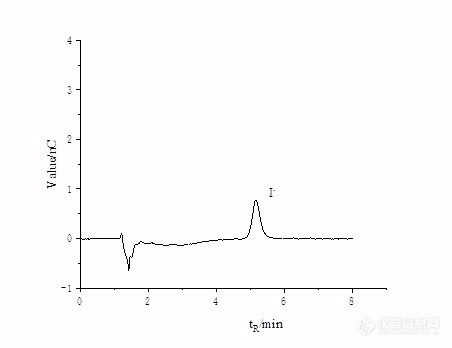
[align=left][font=times new roman][size=24px][color=#ff0000]本论文是国内第一篇采用全国产设备和色谱柱的,使用脉冲安培器的研究论文。[/color][/size][/font][/align][align=left][font='times new roman'][size=16px][/size][/font][/align][align=left][font='times new roman'][size=16px]国产[url=https://insevent.instrument.com.cn/t/3p][color=#3333ff]离子色谱[/color][/url]安培检测器快速测定废水中碘离子含量[/size][/font][/align][align=left][font='times new roman'][size=16px]施超欧[/size][/font][font='times new roman'][size=16px]1[/size][/font][font='times new roman'][size=16px]*[/size][/font][font='times new roman'][size=16px] 赵晓含[/size][/font][font='times new roman'][size=16px]1[/size][/font][font='times new roman'][size=16px] 李泳谊[/size][/font][font='times new roman'][size=16px]1[/size][/font][font='times new roman'][size=16px] 李晓[/size][/font][font='times new roman'][size=16px]1[/size][/font][font='times new roman'][size=16px] [/size][/font][font='times new roman'][size=16px]张业平[/size][/font][font='times new roman'][size=16px]2[/size][/font][font='times new roman'][size=16px] [/size][/font][/align][align=left][font='times new roman'][size=16px]([/size][/font][font='times new roman'][size=16px]1[/size][/font][font='times new roman'][size=16px].[/size][/font][font='times new roman'][size=16px] [/size][/font][font='times new roman'][size=16px]华东理工大学 化学与分子工程学院[/size][/font][font='times new roman'][size=16px] [/size][/font][font='times new roman'][size=16px]分析测试中心[/size][/font][font='times new roman'][size=16px] 上海 200237[/size][/font][font='times new roman'][size=16px] [/size][/font][font='times new roman'][size=16px] [/size][/font][font='times new roman'][size=16px]2[/size][/font][font='times new roman'][size=16px].[/size][/font][font='times new roman'][size=16px] [/size][/font][font='times new roman'][size=16px]通用(深圳)仪器有限公司 深圳 [/size][/font][font='times new roman'][size=16px][color=#333333]518038[/color][/size][/font][font='times new roman'][size=16px][color=#333333])[/color][/size][/font][/align][align=left][b][font=宋体]摘[/font][font=宋体]要:[/font][/b][font=宋体]目前国内利用[url=https://insevent.instrument.com.cn/t/3p][color=#3333ff]离子色谱[/color][/url]法测定水中碘离子含量的多数报道是利用进口仪器如[/font]Thermo[font=宋体]和[/font]Metrohm[font=宋体],鲜有利用全套国产仪器进行水中碘离子含量的测定,特别是国产脉冲安培检测器并没有相关报道。将在[/font]Thermo ICS5000+ [font=宋体][url=https://insevent.instrument.com.cn/t/3p][color=#3333ff]离子色谱仪[/color][/url]上开发的快速测定水中碘[url=https://insevent.instrument.com.cn/t/3p][color=#3333ff]离子色谱[/color][/url]条件应用到全套国产[url=https://insevent.instrument.com.cn/t/3p][color=#3333ff]离子色谱仪[/color][/url][/font]-[font=宋体]安培检测器上进行方法学验证实验。结果表明:[/font]I[sup]-[/sup] [font=宋体]在[/font]5 μg/L~100 μg/L[font=宋体]的浓度范围内线性关系良好,相关系数达到[/font]0.9998[font=宋体]以上,进样量[/font]100 μl[font=宋体]时检出限为[/font]1.03 μg/L[font=宋体],定量限为[/font]3.42 μg/L[font=宋体]([/font]3S/N[font=宋体]),进样重复性良好,加标回收率在[/font]93 %~99.4 %[font=宋体]之间。检出限和测定下限仅为国标抑制[/font]-[font=宋体]电导法的[/font]1/5[font=宋体]左右,符合国家标准,能够满足[/font]I[sup]-[/sup] [font=宋体]的低浓度检测,为国产仪器的推广应用提供一个可行的方案。[/font][b][font=宋体]关键词:[/font][/b][font=宋体]国产[url=https://insevent.instrument.com.cn/t/3p][color=#3333ff]离子色谱仪[/color][/url] 脉冲安培检测碘离子 快速柱[/font][/align][align=left][font=宋体][font=宋体][url=https://insevent.instrument.com.cn/t/3p][color=#3333ff]离子色谱[/color][/url]是液相色谱的一个分支,因其前处理简单,检测灵敏度高,已成为分析无机阴离子的首选方法[/font][sup][1][/sup][font=宋体]。碘离子在天然水体中含量很低,而[url=https://insevent.instrument.com.cn/t/3p][color=#3333ff]离子色谱[/color][/url]法对低含量的无机阴离子检测灵敏度极高,常见阴离子在电导检测器中检出限[/font]≤10 μg/L[font=宋体],安培检测器基于电活性物质在给定电位下发生氧化或还原反应产生的相应电流为响应,检出限相比电导检测器更低。因此近年来应用[url=https://insevent.instrument.com.cn/t/3p][color=#3333ff]离子色谱[/color][/url]法安培法测定水中碘离子含量愈加广泛。[/font][font=宋体][url=https://insevent.instrument.com.cn/t/3p][color=#3333ff]离子色谱[/color][/url]法测定水中碘离子的检测方法主要有抑制[/font]-[font=宋体]电导法、紫外和安培法,淋洗液通常选用碳酸盐体系或氢氧根体系,碳酸盐体系洗脱能力强且[/font]pH[font=宋体]较低,氢氧根体系洗脱能力弱于碳酸盐体系,但在抑制[/font]-[font=宋体]电导法中检测背景较碳酸盐体系小。张俊华[/font][sup][2][/sup][font=宋体]和李叙柏[/font][sup][3][/sup][font=宋体]利用抑制[/font]-[font=宋体]电导法在氢氧根体系检测水中碘化物,两篇报道的方法检出限小于[/font]0.35 μg/L[font=宋体](进样量[/font]500 μL[font=宋体]),碘离子保留时间为[/font]10 min[font=宋体]左右;宋冰冰等人[/font][sup][4][/sup][font=宋体]利用抑制[/font]-[font=宋体]电导法在碳酸盐体系快速检测水中碘离子,方法检出限为[/font]2 μg/L[font=宋体](进样量[/font]250 μL[font=宋体]),碘离子在[/font]12 min[font=宋体]内出峰;刘克纳等人[/font][sup][5][/sup][font=宋体]在氢氧根体系分别使用电导、直流安培和紫外检测器建立痕量碘离子的快速检测方法,碘离子保留时间分别为[/font]5.97[font=宋体]、[/font]4.43[font=宋体]和[/font]4.46 min[font=宋体],[/font]50 μL[font=宋体]进样量检出限分别为[/font]30[font=宋体]、[/font]1[font=宋体]和[/font]25 μg/L[font=宋体]。蒋园园等人[/font][sup][6][/sup][font=宋体]在碳酸盐体系分别用电导和直流安培检测器测定清洁水样中碘离子含量,进样量[/font]250 μL[font=宋体]时电导检测器检出限为[/font]2 μg/L[font=宋体],直流安培检测器检出限为[/font]0.03 μg/L[font=宋体],碘离子在[/font]22.5 min[font=宋体]出峰。在氢氧根体系使用脉冲安培检测器测定高浓度氯离子存在下的痕量碘离子,佘小林等人[/font][sup][7][/sup][font=宋体]建立的方法检出限为[/font]0.2 μg/L[font=宋体],碘离子在[/font]7 min[font=宋体]内出峰;而韩静等人[/font][sup][8][/sup][font=宋体]使用浓缩柱对饱和卤水中的痕量碘离子进行富集,进样量[/font]50 μL[font=宋体]时检出限低至[/font]0.07 μg/L[font=宋体]。[/font][font=宋体]可以看出,抑制[/font]-[font=宋体]电导法灵敏度较安培法低,因此需要大体积进样才能获得较低的检出限,直流安培法是在固定电位下检测,银工作电极表面容易中毒导致检测重复性和灵敏度稍差,而脉冲安培法具备清洗电位,检测灵敏度和稳定性较直流安培法更优,另外在实际操作中发现,高[/font]pH[font=宋体]条件下[/font]Ag[font=宋体]电极稳定性较差,不超过[/font]2[font=宋体]天就要抛光打磨,而碳酸盐体系下[/font]Ag[font=宋体]电极稳定性较好,可以连续使用一个星期以上。[/font][font=宋体]目前国内利用[url=https://insevent.instrument.com.cn/t/3p][color=#3333ff]离子色谱[/color][/url]法测定水中碘离子含量的多数报道是利用进口仪器如[/font]Thermo[font=宋体]和[/font]Metrohm[font=宋体],少有利用全套国产仪器进行水中碘离子含量的测定,郭芳芳等人[/font][sup][9][/sup][font=宋体]用青岛盛瀚的[/font]CIC300[font=宋体][url=https://insevent.instrument.com.cn/t/3p][color=#3333ff]离子色谱仪[/color][/url],抑制[/font]-[font=宋体]电导法检测水中碘离子含量,方法检出限为[/font]2 μg/L[font=宋体],但利用国产安培检测器测定碘离子并没有报道。本文基于针对定制尺寸的碘离子快速分析柱在[/font]Thermo ICS5000+[font=宋体][url=https://insevent.instrument.com.cn/t/3p][color=#3333ff]离子色谱仪[/color][/url]上开发的快速测定水中碘离子方法,基于碳酸盐体系下,安培检测器的稳定性和重复性优于氢氧根体系,选定了碳酸钠作为淋洗液,脉冲安培法具备更优的检测灵敏度和稳定性。将最佳色谱条件应用到自行研制的全套国产[url=https://insevent.instrument.com.cn/t/3p][color=#3333ff]离子色谱仪[/color][/url]上,包括自动进样器、四元梯度泵、安培检测器(脉冲电位)、安培检测池、参比电极、[/font]Ag[font=宋体]工作电极([/font]1 mm[font=宋体])和膜片,进行方法学验证实验,由此评价国产[url=https://insevent.instrument.com.cn/t/3p][color=#3333ff]离子色谱仪[/color][/url]器整机的性能。[/font][b]1 [font=宋体]仪器和材料[/font][/b][font=宋体]国产[/font]GI 5000 [font=宋体][url=https://insevent.instrument.com.cn/t/3p][color=#3333ff]离子色谱仪[/color][/url],包括自动进样器,四元梯度泵,[/font]Eclipse[font=宋体]色谱工作站,国产安培检测器[/font]GI-5250[font=宋体],含国产安培检测池、国产参比电极、国产自制银电极([/font]1 mm[font=宋体])、自制膜片([/font]25 μm[font=宋体]),通用(深圳)仪器有限公司;色谱柱为[/font]I[sup]- [/sup][font=宋体]快速分析柱([/font]3*150 mm[font=宋体]),自主定制;[/font]Millipore-QA10[font=宋体]超纯水机,美国[/font]Millipore[font=宋体]公司。[/font][font=宋体]无水[/font]Na[sub]2[/sub]CO[sub]3[/sub][font=宋体],优级纯,纯度[/font]≥99.8%[font=宋体],上海阿拉丁生化科技公司;水中碘,[/font]100 μg/mL[font=宋体],国家有色金属及电子材料分析测试中心。[/font][b]2 [font=宋体]溶液的配制[/font][/b]2.1 [font=宋体]淋洗液的配制[/font][font=宋体]精确称取[/font]4.24 g[font=宋体]无水[/font]Na[sub]2[/sub]CO[sub]3[/sub][font=宋体]于淋洗液瓶中,使用超纯水溶解并超声,定容至[/font]2 L[font=宋体],得到[/font]20 mmol/L[font=宋体]的[/font]Na[sub]2[/sub]CO[sub]3[/sub][font=宋体]溶液作为淋洗液[/font]B[font=宋体]路。[/font]2.2 [font=宋体]标准溶液的配制[/font][font=宋体]移取上述碘标准溶液[/font]1 mL[font=宋体],使用超纯水逐级稀释得到[/font]1 mg/L[font=宋体]的[/font]I[sup]- [/sup][font=宋体]标准溶液,现配现用。[/font]2.3 [font=宋体]样品溶液的配制[/font][font=宋体]采集华东理工大学不同河道排污废水样,使用[/font]0.45 μm[font=宋体]水系微孔滤膜进行过滤,弃去初滤液[/font]3mL[font=宋体]后,将后续废水滤液收集至离心管中,作为待测废水样,冷藏待用。[/font]2.4 [font=宋体]色谱条件[/font][font=宋体]色谱柱:定制尺寸的碘离子快速分析柱[/font]3*150 mm[font=宋体];流速:[/font]0.4 mL/min[font=宋体]。[/font][font=宋体]淋洗液:[/font]A[font=宋体]路[/font][font=宋体]超纯水:[/font]B[font=宋体]路[/font] 20 mmol/L Na[sub]2[/sub]CO[sub]3[/sub]=60:40[font=宋体];[/font][font=宋体]柱温:[/font]30 ℃[font=宋体];进样量:[/font]100 μL[font=宋体];检测器:安培检测器(脉冲电位)。[/font][font=宋体]脉冲电位如表[/font]1[font=宋体]。[/font][/font][/align][align=left][font=宋体][font=宋体][/font][/font][/align][align=center][font=宋体]表[/font]1 [font=宋体]脉冲安培检测电位[/font][/align][align=center]Table 1 Pulse ampere detection potential[/align] [table=304][tr][td] [align=center][font=宋体]时间[/font]/s[/align] [align=center]Time/s[/align] [/td][td] [align=center][font=宋体]电位[/font]/V[/align] [align=center]Potential/V[/align] [/td][/tr][tr][td] [align=center]0.00[/align] [/td][td] [align=center]-0.10[/align] [/td][/tr][tr][td] [align=center]0.20[/align] [/td][td] [align=center]-0.10[/align] [/td][/tr][tr][td] [align=center]0.90[/align] [/td][td] [align=center]-0.10[/align] [/td][/tr][tr][td] [align=center]0.91[/align] [/td][td] [align=center]-1.00[/align] [/td][/tr][tr][td] [align=center]0.93[/align] [/td][td] [align=center]-0.30[/align] [/td][/tr][tr][td] [align=center]1.00[/align] [/td][td] [align=center]-0.30[/align] [/td][/tr][/table][align=left][font=宋体][b]3 [font=宋体]实验结果与讨论[/font][/b]3.1[font=宋体]色谱条件的选择[/font][font=宋体]基于定制柱的尺寸(直径[/font]3 mm[font=宋体])选定流速为[/font]0.4 mL/min[font=宋体];选取[/font]303.13 K[font=宋体]([/font]30 [font=宋体]℃)保证方法普适性与检测灵敏度;[/font]Ag[font=宋体]工作电极在高[/font]pH[font=宋体]环境下稳定性较差,使检测背景逐渐升高,而碳酸钠体系,[/font]pH[font=宋体]较低,[/font]Ag[font=宋体]电极稳定性较好,同时考虑可兼容电导,因此最终选择[/font]8.0 mmol/L[font=宋体]的[/font]Na[sub]2[/sub]CO[sub]3[/sub][font=宋体]。[/font]3.2 [font=宋体]干扰实验[/font][font=宋体]为验证该体系下其他阴离子对于[/font]I[sup]-[/sup] [font=宋体]的测定无影响,以在安培检测器上有响应的[/font]Br[sup] -[/sup][font=宋体]、[/font]CN[sup]-[/sup][font=宋体]、[/font]S[sup]2-[/sup][font=宋体]、[/font]SCN[sup]- [/sup][font=宋体]共[/font]4[font=宋体]种常见阴离子进行干扰实验,在安培检测器上[/font]Br[sup] -[/sup][font=宋体]、[/font]CN[sup]-[/sup][font=宋体]、[/font]S[sup]2-[/sup][font=宋体]、[/font]SCN[sup]-[/sup] [font=宋体]均不会对[/font]I[sup]-[/sup] [font=宋体]在该定制柱上的保留时间和相应峰高、峰面积产生影响,该体系适用于实际样品中[/font]I[sup]-[/sup] [font=宋体]的测定。[/font]3.3 [font=宋体]线性关系和检出限[/font][font=宋体]在最佳色谱条件下,对配制好的一系列的线性标准溶液在国产[url=https://insevent.instrument.com.cn/t/3p][color=#3333ff]离子色谱仪[/color][/url]器上进行测定,采用[/font]100 μL[font=宋体]定量环。每个浓度的[/font]I[sup]-[/sup] [font=宋体]标准溶液平行测定[/font]3[font=宋体]次,检测结果如下表。[/font][/font][/align][align=left][font=宋体][font=宋体][/font][/font][/align][align=center][font=宋体]表[/font]2 [font=宋体]不同浓度的[/font]I- [font=宋体]标准样品的安培检测结果[/font][/align][align=center]Table 2 Amperometric detection results of I- standard samples with different concentrations [/align] [table=479][tr][td] [align=center][font=宋体]浓度[/font][/align] [/td][td] [align=center][font=宋体]峰面积[/font][/align] [/td][td] [align=center]RSD%[/align] [/td][td] [align=center][font=宋体]峰高[/font][/align] [/td][td] [align=center]RSD%[/align] [/td][td] [align=center][font=宋体]噪音[/font][/align] [/td][td] [align=center][font=宋体]背景[/font][/align] [/td][/tr][tr][td] [align=center]/(μg/L[font=宋体])[/font][/align] [/td][td] [align=center]/(nC*s)[/align] [/td][td] [align=center][font=宋体]([/font]n=3[font=宋体])[/font][/align] [/td][td] [align=center]/nC[/align] [/td][td] [align=center][font=宋体]([/font]n=3[font=宋体])[/font][/align] [/td][td] [align=center]/nC[/align] [/td][td] [align=center]/nC[/align] [/td][/tr][tr][td] [align=center]5[/align] [/td][td] [align=center]3.970[/align] [/td][td] [align=center]2.4[/align] [/td][td] [align=center]0.2267[/align] [/td][td] [align=center]2.5[/align] [/td][td] [align=center]0.014[/align] [/td][td] [align=center]2.850[/align] [/td][/tr][tr][td] [align=center]10[/align] [/td][td] [align=center]8.640[/align] [/td][td] [align=center]1.9[/align] [/td][td] [align=center]0.4533[/align] [/td][td] [align=center]1.3[/align] [/td][td] [align=center]0.016[/align] [/td][td] [align=center]2.860[/align] [/td][/tr][tr][td] [align=center]25[/align] [/td][td] [align=center]20.04[/align] [/td][td] [align=center]0.32[/align] [/td][td] [align=center]1.083[/align] [/td][td] [align=center]0.53[/align] [/td][td] [align=center]0.013[/align] [/td][td] [align=center]2.860[/align] [/td][/tr][tr][td] [align=center]50[/align] [/td][td] [align=center]40.44[/align] [/td][td] [align=center]0.38[/align] [/td][td] [align=center]2.117[/align] [/td][td] [align=center]0.98[/align] [/td][td] [align=center]0.016[/align] [/td][td] [align=center]2.870[/align] [/td][/tr][tr][td] [align=center]100[/align] [/td][td] [align=center]81.22[/align] [/td][td] [align=center]1.4[/align] [/td][td] [align=center]4.100[/align] [/td][td] [align=center]0.98[/align] [/td][td] [align=center]0.012[/align] [/td][td] [align=center]2.860[/align] [/td][/tr][tr][td] [align=center][font=宋体]线性关系[/font][/align] [/td][td=2,1] [align=center]y = 0.8105x + 0.062[/align] [/td][td=2,1] [align=center]y = 0.0407x + 0.0498[/align] [/td][/tr][tr][td] [align=center]R2[/align] [/td][td=2,1] [align=center]0.9999[/align] [/td][td=2,1] [align=center]0.9998[/align] [/td][/tr][/table][align=left][font=宋体][font=宋体]如表[/font]2[font=宋体]所示,在国产[url=https://insevent.instrument.com.cn/t/3p][color=#3333ff]离子色谱仪[/color][/url]器上进行[/font]I[sup]- [/sup][font=宋体]测定时,每个浓度的[/font]I[sup]- [/sup][font=宋体]标准溶液平行测定的[/font]RSD[font=宋体]值≤[/font]2.5 %[font=宋体],说明国产[url=https://insevent.instrument.com.cn/t/3p][color=#3333ff]离子色谱仪[/color][/url]器状态较为稳定。工作电极打磨后,背景值较低,稳定在[/font]2.860 nC[font=宋体]附近,噪音则≤[/font]0.016 nC[font=宋体]。[/font][font=宋体]使用国产[url=https://insevent.instrument.com.cn/t/3p][color=#3333ff]离子色谱仪[/color][/url]测定[/font]I[sup]- [/sup][font=宋体]时,在[/font]5 μg/L~100 μg/L[font=宋体]的浓度范围内线性关系良好,峰面积相关系数达到[/font]0.9999[font=宋体]以上。经计算可得,检出限为[/font]1.03 μg/L[font=宋体],定量限为[/font]3.42 μg/L[font=宋体]([/font]3[font=宋体]倍信噪比)。[/font]3.4 [font=宋体]重复性[/font][font=宋体]为考察该国产[url=https://insevent.instrument.com.cn/t/3p][color=#3333ff]离子色谱仪[/color][/url][/font]-[font=宋体]安培检测器是否符合实际检测应用需求,需进一步考察其稳定性。分别取高中低浓度的标准样品溶液:[/font]10 μg/L[font=宋体]、[/font]50 μg/L[font=宋体]、[/font]250 μg/L[font=宋体]的[/font] I[sup]- [/sup][font=宋体]标准溶液连续进样,每个标准浓度重复测定[/font]8[font=宋体]次,结果如下表[/font]3[font=宋体]。[/font][/font][/align][align=center][font=宋体]表[/font]3 [font=宋体]国产[url=https://insevent.instrument.com.cn/t/3p][color=#3333ff]离子色谱仪[/color][/url]上不同浓度的[/font]I[sup]-[/sup] [font=宋体]标准样品的重复性考察结果([/font]n=8[font=宋体])[/font][/align][align=left][font=宋体][font=宋体] [/font][/font][table=628][tr][td=1,2] [align=center][font=宋体]序号[/font][/align] [/td][td=4,1] [align=center]10 μg/L[/align] [/td][td=3,1] [align=center]50 μg/L[/align] [/td][td=4,1] [align=center]250 μg/L[/align] [/td][/tr][tr][td] [align=center]t[sub]R[/sub][/align] [align=center]/min[/align] [/td][td] [align=center][font=宋体]峰面积[/font][/align] [align=center]/(nC*s)[/align] [/td][td] [align=center][font=宋体]峰高[/font][/align] [align=center]/nC[/align] [/td][td=2,1] [align=center]t[sub]R[/sub][/align] [align=center]/min[/align] [/td][td] [align=center][font=宋体]峰面积[/font][/align] [align=center]/(nC*s)[/align] [/td][td=2,1] [align=center][font=宋体]峰高[/font][/align] [align=center]/nC[/align] [/td][td] [align=center]t[sub]R[/sub][/align] [align=center]/min[/align] [/td][td] [align=center][font=宋体]峰面积[/font][/align] [align=center]/(nC*s)[/align] [/td][td] [align=center][font=宋体]峰高[/font][/align] [align=center]/nC[/align] [/td][/tr][tr][td] [align=center]1[/align] [/td][td] [align=center]5.36[/align] [/td][td] [align=center]8.340[/align] [/td][td] [align=center]0.46[/align] [/td][td=2,1] [align=center]5.34[/align] [/td][td] [align=center]41.02[/align] [/td][td=2,1] [align=center]2.16[/align] [/td][td] [align=center]5.29[/align] [/td][td] [align=center]190.9[/align] [/td][td] [align=center]9.38[/align] [/td][/tr][tr][td] [align=center]2[/align] [/td][td] [align=center]5.36[/align] [/td][td] [align=center]8.240[/align] [/td][td] [align=center]0.48[/align] [/td][td=2,1] [align=center]5.33[/align] [/td][td] [align=center]41.06[/align] [/td][td=2,1] [align=center]2.18[/align] [/td][td] [align=center]5.29[/align] [/td][td] [align=center]188.4[/align] [/td][td] [align=center]9.31[/align] [/td][/tr][tr][td] [align=center]3[/align] [/td][td] [align=center]5.36[/align] [/td][td] [align=center]8.680[/align] [/td][td] [align=center]0.46[/align] [/td][td=2,1] [align=center]5.33[/align] [/td][td] [align=center]42.25[/align] [/td][td=2,1] [align=center]2.20[/align] [/td][td] [align=center]5.30[/align] [/td][td] [align=center]187.0[/align] [/td][td] [align=center]9.23[/align] [/td][/tr][tr][td] [align=center]4[/align] [/td][td] [align=center]5.36[/align] [/td][td] [align=center]8.530[/align] [/td][td] [align=center]0.46[/align] [/td][td=2,1] [align=center]5.33[/align] [/td][td] [align=center]41.11[/align] [/td][td=2,1] [align=center]2.16[/align] [/td][td] [align=center]5.30[/align] [/td][td] [align=center]187.0[/align] [/td][td] [align=center]9.33[/align] [/td][/tr][tr][td] [align=center]5[/align] [/td][td] [align=center]5.36[/align] [/td][td] [align=center]8.260[/align] [/td][td] [align=center]0.45[/align] [/td][td=2,1] [align=center]5.33[/align] [/td][td] [align=center]40.58[/align] [/td][td=2,1] [align=center]2.16[/align] [/td][td] [align=center]5.29[/align] [/td][td] [align=center]190.3[/align] [/td][td] [align=center]9.34[/align] [/td][/tr][tr][td] [align=center]6[/align] [/td][td] [align=center]5.35[/align] [/td][td] [align=center]8.370[/align] [/td][td] [align=center]0.46[/align] [/td][td=2,1] [align=center]5.32[/align] [/td][td] [align=center]40.55[/align] [/td][td=2,1] [align=center]2.16[/align] [/td][td] [align=center]5.30[/align] [/td][td] [align=center]186.2[/align] [/td][td] [align=center]9.27[/align] [/td][/tr][tr][td] [align=center]7[/align] [/td][td] [align=center]5.35[/align] [/td][td] [align=center]8.480[/align] [/td][td] [align=center]0.46[/align] [/td][td=2,1] [align=center]5.33[/align] [/td][td] [align=center]42.52[/align] [/td][td=2,1] [align=center]2.20[/align] [/td][td] [align=center]5.29[/align] [/td][td] [align=center]188.2[/align] [/td][td] [align=center]9.44[/align] [/td][/tr][tr][td] [align=center]8[/align] [/td][td] [align=center]5.36[/align] [/td][td] [align=center]8.040[/align] [/td][td] [align=center]0.45[/align] [/td][td=2,1] [align=center]5.33[/align] [/td][td] [align=center]41.43[/align] [/td][td=2,1] [align=center]2.20[/align] [/td][td] [align=center]5.29[/align] [/td][td] [align=center]192.0[/align] [/td][td] [align=center]9.34[/align] [/td][/tr][tr][td] [align=center]RSD%[/align] [/td][td] [align=center]0.086[/align] [/td][td] [align=center]2.4[/align] [/td][td] [align=center]2.0[/align] [/td][td=2,1] [align=center]0.10[/align] [/td][td] [align=center]1.7[/align] [/td][td=2,1] [align=center]0.91[/align] [/td][td] [align=center]0.10[/align] [/td][td] [align=center]1.1[/align] [/td][td] [align=center]0.69[/align] [/td][/tr][/table][/align][align=left][font=宋体]从表中可得,保留时间的重复性最佳,[/font]RSD[font=宋体]值均≤[/font]0.10%[font=宋体],峰高的[/font]RSD[font=宋体]值≤[/font]2.0%[font=宋体],峰面积的[/font]RSD[font=宋体]值在[/font]2.4%[font=宋体]以下,以上结果表明该国产[url=https://insevent.instrument.com.cn/t/3p][color=#3333ff]离子色谱仪[/color][/url][/font]-[font=宋体]安培检测器的检测重复性良好,可满足检测需求。[/font]3.5 [font=宋体]实际样品的测定和加标回收率[/font]I[sup]-[/sup] [font=宋体]标样色谱图如图[/font]1[font=宋体],使用相同的色谱条件,将待测废水样品在国产[url=https://insevent.instrument.com.cn/t/3p][color=#3333ff]离子色谱仪[/color][/url]器上直接进样进行分析,未检测出碘离子。加标废水样品色谱图如图[/font]2[font=宋体]。[/font][img=,452,348]https://ng1.17img.cn/bbsfiles/images/2021/09/202109211739586401_7706_1617661_3.jpg!w452x348.jpg[/img][img=,452,348]https://ng1.17img.cn/bbsfiles/images/2021/09/202109211740039838_3464_1617661_3.jpg!w452x348.jpg[/img][/align][align=center][font=宋体]图[/font]1 I[sup]- [/sup][font=宋体]标样色谱图 [/font][font=宋体]图[/font][font=宋体]2 [/font][font=宋体]加标废水样品的检测图谱[/font][/align][align=center][font=宋体][font=宋体]进行高低两个水平的加标回收测定,平行测定[/font]6[font=宋体]次。检测结果如表[/font]4[font=宋体]所示。[/font][/font][/align][align=center][font=宋体]表[/font]4 [font=宋体]废水样品检测结果、加标量以及回收率测定[/font][/align][align=center]Table 4 The detection results, standard addition and recovery rate determinationof wastewater samples [/align] [table=505][tr][td] [align=center][font=宋体]测定次数[/font][/align] [/td][td] [align=center][font=宋体]加标量[/font]1[font=宋体]([/font]15μg/L[font=宋体])[/font][/align] [align=center][font=宋体]测定值[/font]μg/L[/align] [/td][td] [align=center][font=宋体]加标量[/font]2[font=宋体]([/font]25μg/L[font=宋体])[/font][/align] [align=center][font=宋体]测定值[/font]μg/L[/align] [/td][td] [align=center][font=宋体]加标回收率[/font]1[/align] [align=center]%[/align] [/td][td] [align=center][font=宋体]加标回收率[/font]2[/align] [align=center]%[/align] [/td][/tr][tr][td] [align=center]1[/align] [/td][td] [align=center]14.34[/align] [/td][td] [align=center]23.25[/align] [/td][td] [align=center]95.6[/align] [/td][td] [align=center]93.0[/align] [/td][/tr][tr][td] [align=center]2[/align] [/td][td] [align=center]14.62[/align] [/td][td] [align=center]23.40[/align] [/td][td] [align=center]97.5[/align] [/td][td] [align=center]93.6[/align] [/td][/tr][tr][td] [align=center]3[/align] [/td][td] [align=center]14.62[/align] [/td][td] [align=center]24.21[/align] [/td][td] [align=center]97.5[/align] [/td][td] [align=center]96.8[/align] [/td][/tr][tr][td] [align=center]4[/align] [/td][td] [align=center]14.65[/align] [/td][td] [align=center]24.24[/align] [/td][td] [align=center]97.7[/align] [/td][td] [align=center]97.0[/align] [/td][/tr][tr][td] [align=center]5[/align] [/td][td] [align=center]14.73[/align] [/td][td] [align=center]24.60[/align] [/td][td] [align=center]98.2[/align] [/td][td] [align=center]98.4[/align] [/td][/tr][tr][td] [align=center]6[/align] [/td][td] [align=center]14.77[/align] [/td][td] [align=center]24.85[/align] [/td][td] [align=center]98.5[/align] [/td][td] [align=center]99.4[/align] [/td][/tr][/table][font=宋体]总的来看,加标回收率集中在[/font]93.0%~99.4%[font=宋体]之间,符合国家标准。以上数据表明,国产[url=https://insevent.instrument.com.cn/t/3p][color=#3333ff]离子色谱仪[/color][/url][/font]-[font=宋体]安培检测器的开发已经较为成熟,可满足实际样品的分析测定。[/font]3.6 [font=宋体]与国标方法对比[/font][font=宋体]将采用全套国产[url=https://insevent.instrument.com.cn/t/3p][color=#3333ff]离子色谱仪[/color][/url]器([/font]GI-5000[font=宋体])测定结果的检出限和定量限,与进口仪器测定结果和国标方法规定值进行对比。[/font][align=center][font=宋体]表[/font]5 [font=宋体]国产仪器检测灵敏度与国标方法对比[/font][/align][align=center]Table 5 Comparison of detection sensitivity of domestic instruments withnational standard methods[font=宋体]([/font]3S/N[font=宋体])[/font][/align] [table=693][tr][td] [align=center][font=宋体]仪器设备[/font][/align] [/td][td] [align=center][font=宋体]方法[/font][/align] [/td][td] [align=center][font=宋体]进样量[/font]/μL[/align] [/td][td] [align=center][font=宋体]检出限[/font]/(μg/L)[/align] [/td][td] [align=center][font=宋体]定量限[/font]/(μg/L)[/align] [/td][/tr][tr][td] [align=center][font=宋体]进口仪器[/font][/align] [/td][td] [align=center][font=宋体]常规阴离子交换柱[/font]-[font=宋体]抑制电导法[/font][sup][10][/sup][/align] [/td][td] [align=center]250[/align] [/td][td] [align=center]2.00[/align] [/td][td] [align=center]8.00[/align] [/td][/tr][tr][td] [align=center]GI 5000[/align] [/td][td] [align=center][font=宋体]定制[/font]I[sup]- [/sup][font=宋体]快速分析柱[/font]-[font=宋体]安培检测器[/font][/align] [/td][td] [align=center]100[/align] [/td][td] [align=center]1.03[/align] [/td][td] [align=center]3.42[/align] [/td][/tr][/table][font=宋体]如表[/font]5[font=宋体]所示,采用全套国产[url=https://insevent.instrument.com.cn/t/3p][color=#3333ff]离子色谱仪[/color][/url]器设备,并采用定制柱开发的方法测定[/font]I[sup]- [/sup][font=宋体],灵敏度高,检出限低,仅为国标方法检出限和测定下限的[/font]1/5[font=宋体]左右(按照相同的进样量换算),符合国家标准,能够满足[/font]I[sup]- [/sup][font=宋体]的低浓度快速检测。根据众多用户的反馈,在很多情况下即使根据国标法采用进口设备进行检测,很多情况下也难以达到[/font]2 μg/L[font=宋体]的检出限,而采用本文的全套国产安培系统,在常规的条件下,检出限优于国标中的抑制[/font]-[font=宋体]电导法,实际操作难度更低,可为实验提供更为可靠简单的方案。[/font][b]4 [font=宋体]结论[/font][/b][font=宋体]利用全套国产[url=https://insevent.instrument.com.cn/t/3p][color=#3333ff]离子色谱仪[/color][/url][/font]-[font=宋体]安培检测器对已开发方法进行方法学验证实验,结果表明:国产[url=https://insevent.instrument.com.cn/t/3p][color=#3333ff]离子色谱仪[/color][/url][/font]-[font=宋体]安培检测器测定[/font]I[sup]- [/sup][font=宋体]时,在[/font]5 μg/L~100 μg/L[font=宋体]的浓度范围内线性关系及进样重复性良好,加标回收率在[/font]93%~99.4%[font=宋体]之间,在[/font]250 μL[font=宋体](换算后)进样量时检出限和定量限为国标方法的[/font]1/5[font=宋体]左右,能够实现[/font]I[sup]- [/sup][font=宋体]的低浓度快速检测,这填补了国产[url=https://insevent.instrument.com.cn/t/3p][color=#3333ff]离子色谱[/color][/url]尤其是安培检测器应用的空白。[/font][align=center][font=宋体][font=宋体][/font][/font][/align][align=center][font=宋体]参考文献[/font][1][font='Times New Roman'] [/font]MouS F, Liu K N, Ding X J. Ion Chromatography Method and Application (2[sup]nd[/sup]Edition) [M].Beijing: Chemical IndustryPress, 2005: 1.[font=宋体]牟世芬[/font],[font=宋体]刘克纳[/font], [font=宋体]丁晓静[/font]. [font=宋体][url=https://insevent.instrument.com.cn/t/3p][color=#3333ff]离子色谱[/color][/url]方法及应用[/font]. [font=宋体]第[/font]2[font=宋体]版[/font][M]. [font=宋体]北京[/font]: [font=宋体]化学工业出版社[/font], 2005: 1.[2][font='Times New Roman'] [/font]ZhangJ H. Shanxi Science and Technology[J], 2020,35(2): 94-96.[font=宋体]张俊华[/font].[font=宋体]山西科技[/font][J], 2020,35(2): 94-96.[3][font='Times New Roman'] [/font]LiX B, Zhang Y, Jiang W W. Water Purification Technology[J], 2017,36(4): 84-86.[font=宋体]李叙柏[/font],[font=宋体]张琰[/font],[font=宋体]姜巍巍[/font]. [font=宋体]净水技术[/font][J], 2017,36(4): 84-86.[4][font='Times New Roman'] [/font]SongB B, Tian Y, Li R Y, Qin D L, Lin H L, Guo Q, Zhu Y, Luo Y P. TheAdministration and Technique of Environmental Monitoring[J], 2017,29(4): 50-52,56.[font=宋体]宋冰冰[/font],[font=宋体]田耘[/font], [font=宋体]李仁勇[/font], [font=宋体]秦迪岚[/font], [font=宋体]林海兰[/font], [font=宋体]郭倩[/font], [font=宋体]朱颖[/font], [font=宋体]罗岳平[/font]. [font=宋体]环境监测管理与技术[/font][J], 2017,29(4):50-52,56.[5][font='Times New Roman'] [/font]LiuK N, Mou S F, Chai C W. PTCA (PART B: CHEMICAL ANALYSIS) [J], 2001,37(8): 337-338,342.[font=宋体]刘克纳[/font],[font=宋体]牟世芬[/font], [font=宋体]柴成文[/font]. [font=宋体]理化检验[/font] ([font=宋体]化学分册[/font]) [J],2001,37(8):337-338,342.[6][font='Times New Roman'] [/font]JinagY Y, Cheng H, Xu L. Environmental Monitoring and Forewarning[J], 2020,12(2): 31-35.[font=宋体]蒋园园[/font],[font=宋体]程海[/font], [font=宋体]徐蕾[/font]. [font=宋体]环境监控与预警[/font][J], 2020,12(2): 31-35.[7][font='Times New Roman'] [/font]SheX L, Li R Y, Chen Y Y, Hu L. Modern Scientific Instruments[J], 2010(6): 139-140.[font=宋体]佘小林[/font],[font=宋体]李仁勇[/font], [font=宋体]陈园园[/font], [font=宋体]胡兰[/font]. [font=宋体]现代科学仪器[/font][J], 2010(6):139-140.[8][font='Times New Roman'] [/font]HanJ, Liang L N, Mou S F, Cai Y Q, Lu Y Q. Chinese Journal of Analytical Chemistry[J],2008,36(2):187-191.[font=宋体]韩静[/font],[font=宋体]梁立娜[/font], [font=宋体]牟世芬[/font], [font=宋体]蔡亚岐[/font], [font=宋体]鲁毅强[/font]. [font=宋体]分析化学[/font][J],2008,36(2): 187-191.[9][font='Times New Roman'] [/font]GuoF F, Dai C, Zhang S Y. Chemical Enterprise Management[J],2017(35): 192.[font=宋体]郭芳芳[/font],[font=宋体]戴超[/font], [font=宋体]张书玉[/font]. [font=宋体]化工管理[/font][J],2017(35): 192.[10][font='Times New Roman'] [/font]HJ 778-2015 Waterquality-Determination of iodide-Ion chromatiography[s].HJ 778-2015 [font=宋体]水质[/font][font=宋体]碘化物的测定[/font][font=宋体][url=https://insevent.instrument.com.cn/t/3p][color=#3333ff]离子色谱[/color][/url]法[/font][s]. [/s][/s][/align][align=left][font=宋体][b][font='Times New Roman','serif'][/font][/b][/font][/align]
没怎么用过离子色谱,之前就用过几次电导的,没做过安培,现在想做安培,忙了半天不出峰,仪器用的是戴安5000,请教有什么使用注意事项
摘 要:电导检测器在离子色谱中占有主导地位,其构造直接影响它的一些性能和应用。笔者对两种不同构造的电导检测器在某些弱酸阴离子、碱金属和碱土金属阳离子、过渡金属阳离子以及某些两性物质的检测方面进行比较,并简单的探讨了构造与应用之间的关系。关键词:离子色谱;电导检测器;构造;应用;噪声离子色谱常用的检测器有电导检测器、紫外检测器和安培检测器,其中电导检测器因通用性好、灵敏度高、价格相对低廉等优点占据主导地位。虞雄华在2008年曾经就国产离子色谱的现状进行过综述并对国产离子色谱与进口离子色谱的性能进行比较,认为在电导检测器的性能指标方面,国产的五电极电导检测器与进口仪器的双电极脉冲电导检测器相当。笔者认为,在抑制电导检测方面,国产的五电极电导检测器(碳酸盐淋洗液)与进口的双电极脉冲电导检测器(氢氧根淋洗液)性能相当;但在某些非抑制电导检测方面,国产的五电极电导检测器与进口仪器的双电极脉冲电导检测器在高背景电导情况下出现一些差异,具体表现在某些弱酸阴离子、碱金属和碱土金属阳离子、过渡金属阳离子以及某些两性离子的检测,下面将逐一进行介绍。(一) 弱酸阴离子对于pKa7的阴离子来说(如CO32-、SiO32-、S2-、酚类等),抑制电导检测亦会将待测离子转化为相应的弱酸,其在电导检测器中响应值较弱或几乎不响应。为提高弱酸阴离子的响应值,一种方法是用强酸的阴离子为淋洗液,间接抑制电导检测;另外一种方法是用氢氧根淋洗液,非抑制间接电导检测。这两种方法均具有高的背景电导,此时进口的双电极脉冲电导检测器将出现很大的噪声,待测离子的线性范围仅为101;而国产的五电极电导检测器具有背景电导调零功能,可适当选择放大倍数,避免了高背景电导带来的噪声同时提高了待测离子的响应值和线性范围(102)。(二) 碱金属和碱土金属阳离子根据H+、OH-和碱金属、碱土金属的极限摩尔电导值计算,碱金属和碱土金属使用抑制电导检测和非抑制电导检测在灵敏度方面基本一致,而且进口的双电极脉冲电导器(淋洗液抑制产物为水)和国产的五电极电导检测器(非抑制电导检测,适当调节放大倍数)均可获得较低的噪声。但在实际情况中,样品中除了含有碱金属、碱土金属,还可能含有过渡金属阳离子,此类阳离子经过抑制后会形成氢氧化物沉淀,长期使用可能堵塞抑制器。国产的五电极电导检测器检测碱金属和碱土金属很少有采用抑制电导检测的报导,既避免了堵塞抑制器的风险,又降低了用户的使用成本。此外,NH4OH在较高浓度时部分以分子形式存在,使用抑制电导检测NH4+将呈现非线性;使用非抑制电导检测则线性关系良好。(三) 过渡金属阳离子某些过渡金属和重金属阳离子,如Zn2+、Cd2+、Pb2+、Cu2+、Ni2+、Co2+、Mn2+、Cr3+等带有较多的电荷数,对阳离子交换树脂亲和力较强。因此分离这类阳离子通常选用配位羧酸(如酒石酸、柠檬酸、草酸和吡啶-2,6-二羧酸等)为淋洗液,在阳离子交换平衡之外建立一个配位-解离的二级平衡。进口的双电极脉冲电导器在高背景电导条件下噪声比较大,因此该公司开发的方法是柱后衍生-紫外可见光检测,该方法选择性与灵敏度俱佳但紫外检测器比电导检测器价格昂贵。(四) 两性离子 两性离子如氨基酸、甜菜碱等在电导检测时只能使用非抑制电导检测方式。进口仪器厂家开发的检测氨基酸方法为氢氧根梯度淋洗,积分脉冲安培方式检测;国家标准方法中甜菜碱的检测使用阳离子交换色谱非抑制电导检测,因此国产的五电极电导检测器非常适合而进口的双电极脉冲电导检测器在这一方面就笔者所知,尚未有已面世的文献报道。(五) 结语国产的五电极电导检测器与进口的双电极脉冲电导检测器在抑制电导检测方面性能相当。但由于二者构造不同,在高背景电导情况下表现出一些不同。参考文献虞雄华,费栋.国产离子色谱仪的现状.第十二届全国离子色谱学术报告会,(2008):20-21.福建,厦门牟世芬,刘克纳,丁晓静.离子色谱方法及应用.第二版.化学工业出版社,第六章:离子色谱常用的检测器:134朱岩.离子色谱原理及其应用.浙江大学出版社,第二篇:离子色谱的应用;第五章:离子色谱在环境监测中的应用:134 James S. Fritz, DouglasT. Gjerde. Ion Chromatography Forth,Completely Revised and Enlarged Edition. Section 6: Anion Chromatography: 152 James S. Fritz, DouglasT. Gjerde. Ion Chromatography Forth,Completely Revised and Enlarged Edition. Section 7: Cation Chromatography: 187牟世芬,刘克纳,丁晓静.离子色谱方法及应用.第二版.[f
万通881的离子色谱,SUPP4 10MMOL的NAOH淋洗液 直流模式安培检测器 测氰化物,淋洗液配了几次了,也抽滤了,应该不是淋洗液的问题,Ag电极也打磨了几次,就是基线做不稳,做低浓度的时候,就明显看到波动和杂峰,峰也拖得厉害。想请救一下做安培检测器的老师,这个氰化物有这么难测吗?你们做的时候是不是每次要打磨电极,基线跑得怎么样?
[font=宋体][color=#3333ff][b][url=https://insevent.instrument.com.cn/t/3p][color=#3333ff]离子色谱[/color][/url]常用检测器[/b][/color][/font]包括电导检测器、安培检测器、紫外检测器等其中电导检测器应用最广泛,这是一种电化学检测器,同时也是一款通用性检测器,可用于检测阴阳离子和有机酸、有机胺等离子安培检测器是一种电化学检测器,同时也是一款选择性检测器,用于检测在电极表面可以发生氧化还原反应的物质,比如碘、硫、氨基酸、糖等。[color=#3333ff][b]检测器量程[/b][/color]根据量程分类可以分为动态量程检测器和固定量程检测器。以电导检测器为例,可以分为动态量程电导检测器和固定量程电导检测器,区别在于量程是否固定,基于此前提决定了检测范围是否是分段的,动态量程电导检测器范围更宽,固定量程电导检测器检测范围相对较小。[color=#3333ff][b]二极电导池与五极电导池的区别[/b][/color]二极电导池,指电导池由两个电极组成,目前市场上的[url=https://insevent.instrument.com.cn/t/3p][color=#3333ff]离子色谱仪[/color][/url]大多采用这种类型电导池,比如赛默飞、万通、睿谱、盛瀚等。适合所以应用于各种场合,死体积小,耐压高,适用于抑制法和非抑制法两种检测方式。五极电导池,指电导池由5个电极叠压组成,起主要测量作用的是四个电极 ,两个电极为激励电极,另两个电极为测量电极,整个池内体积分布于四个电极间,因此池内死体积更大,目前国内这种类型的电导池公布的池体积是测量电极间体积,这是不正确的。[b][color=#3333ff][/color][color=#3333ff]理性分辨电导检测范围[/color][/b]1. 电导检测范围超过2000微西意义不大,因为色谱柱容量有限,这么大的峰,色谱柱无法正常的分离,峰形很宽,无法定量。2. 有的检测器范围很宽,资料标称0-35000uS,0-46000uS,0-64000uS等,但一定要注意,这个范围是分段的,即分量程的,有挡位的,在进样前要设置量程,选择了高灵敏度量程,则高浓度离子出平头峰,选择低灵敏度量程,可以测高浓度离子但低浓度离子无法检测。另一种检测器,资料标称检测范围为0-15000uS,一定要注意这是一段无量程的检测范围,可以同时兼顾高低浓度离子检测。使用此技术的有赛默飞、万通、睿谱、盛瀚等公司的产品。
离子色谱仪配置的是安培检测器,一年前仪器正常使用,然后把参比电极拆下来保存在1M的KCl中;这两天重新使用,发现背景信号很高,一直在400nC,不接柱子进样只出现负峰;已对工作电极打磨,也换了新的垫片还是不行~请问是什么原因啊?是参比电极太久没用坏了吗?
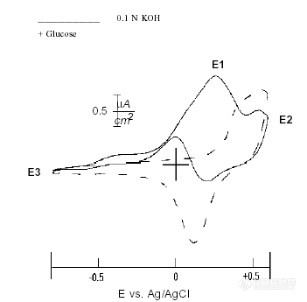
[align=left][font=宋体][font=Times New Roman]5.3.3 [/font][font=宋体]安培检测器的原理[/font][/font][font='Times New Roman'][font=宋体]安培检测器属于电化学检测器中的一种[/font][/font][font=宋体],[/font][font='Times New Roman'][font=宋体]是在外加电压的作用下[/font][/font][font=宋体],[/font][font='Times New Roman'][font=宋体]待测物质[/font][/font][font=宋体](具有电活性)[/font][font='Times New Roman'][font=宋体]会在[/font][/font][font=宋体]工作[/font][font='Times New Roman'][font=宋体]电极表面上发生氧化还原反应[/font][/font][font=宋体]。在氧化反应过程中,电活性被测化合物的电子从工作电极转移到安培池;反之,在还原过程中,电子从被测化合物转移到工作电极。这些[/font][font='Times New Roman'][font=宋体]电流的变化[/font][/font][font=宋体],该电流[/font][font='Times New Roman'][font=宋体]符合法拉第定律[/font][/font][font=宋体][font=宋体],通过对电流的检测可以推算出待测物质的浓度。其主要用于易于发生氧化还原反应的物质分析,[/font] 如果有些干扰物无法发生氧化还原反应,就没有检测信号,不被检测到。[/font][font=宋体]在[url=https://insevent.instrument.com.cn/t/3p][color=#3333ff]离子色谱[/color][/url]应用中安培检测主要包括恒电位(直流安培)、脉冲安培以及积分脉冲安培三种方式。[/font][font=宋体][font=Times New Roman]5.3.3.1 [/font][font=宋体]伏安法[/font][/font][font=宋体] [font=宋体]在现成的[url=https://insevent.instrument.com.cn/t/3p][color=#3333ff]离子色谱[/color][/url]中,基本所有的被测化合物的分析方法已经固定,但作为未知化合物的分析,需要采用伏安法,其是确定安培检测器最佳工作电位的一种电化学技术。[/font][/font][font=宋体]其方法是工作电极表面不断通过含有被测化合物组分的溶液和支持流动相介质,测量其氧化和还原反应过程中产生的电流。并以此电流对指定范围内扫描的工作电极作图,得到伏安波形图。[/font][font=宋体][font=宋体]扫描时,先以正向对电流进行扫描,然后反向进行扫描,从起始点开始,到起始点结束,起点电位等于终点电位,此法称为[/font]“循环伏安法”。[/font][font=宋体][font=宋体]下图是葡萄糖在[/font][font=Times New Roman]0.1mol/L KOH[/font][font=宋体]条件下,在金电极和[/font][font=Times New Roman]Ag/AgCl[/font][font=宋体]参比电极上的循环伏安图[/font][/font][img=,307,302]https://ng1.17img.cn/bbsfiles/images/2021/11/202111241058091910_5585_3237657_3.jpg!w307x302.jpg[/img][font=宋体] [/font][font=宋体][font=宋体]图中虚线是[/font][font=Times New Roman]0.1mol/L KOH[/font][font=宋体]溶液在没有葡萄糖时所引起的电流,即为背景电流。从[/font][font=Times New Roman]-0.8V[/font][font=宋体]开始正向扫描到[/font][font=Times New Roman]0.25V[/font][font=宋体]还是平坦的,再升高电压后,金电极开始表面氧化。接着从[/font][font=Times New Roman]0.6V[/font][font=宋体]开始反向扫描,金氧化物还原成金,负峰电流在[/font][font=Times New Roman]0.1V[/font][font=宋体]。[/font][/font][font=宋体][font=宋体]在溶液中加入葡萄糖,从[/font][font=Times New Roman]-0.8V[/font][font=宋体]开始正向扫描,电流略有变化,但不太明显,从[/font][font=Times New Roman]-0.15V[/font][font=宋体]开始变化明显,电流升高,到[/font][font=Times New Roman]0.25V[/font][font=宋体]为峰值,然后电流减少,其原因是表面的大部分葡萄糖已经被氧化,另一个因素是金氧化物的生成阻止了葡萄糖的进一步氧化。当反向扫描时,金氧化物开始被还原成金,葡萄糖也一样,负峰电流在[/font][font=Times New Roman]0.15V[/font][font=宋体]左右。[/font][/font][font=宋体]在下述电化学反应中:[/font][img=,76,26]https://ng1.17img.cn/bbsfiles/images/2021/11/202111241058264178_4191_3237657_3.jpg!w76x26.jpg[/img][font=宋体][font=宋体]当反应正向进行时,[/font][font=Times New Roman]A[/font][font=宋体]将[/font][font=Times New Roman]n[/font][font=宋体]个电子转移至工作电极,并被氧化成[/font][font=Times New Roman]B[/font][font=宋体],反向进行时,[/font][font=Times New Roman]B[/font][font=宋体]被还原成[/font][font=Times New Roman]A[/font][font=宋体],用[/font][font=Times New Roman]Nerst[/font][font=宋体]方程表示为:[/font][/font][font=宋体] [/font][font='Cambria Math'][/font][img=,143,41]https://ng1.17img.cn/bbsfiles/images/2021/11/202111241058385867_7954_3237657_3.jpg!w143x41.jpg[/img][font=宋体][font=宋体]公式:均有特定的[/font][font=Times New Roman]E[/font][/font][sup][font=宋体][font=Times New Roman]0[/font][/font][/sup][font=宋体],[/font][font=宋体][font=宋体]式中,[/font][font=Times New Roman]Eapp[/font][font=宋体]为工作电极,[/font][font=Times New Roman]E[/font][/font][sup][font=宋体][font=Times New Roman]0[/font][/font][/sup][font=宋体][font=宋体]为[/font][font=Times New Roman][A]=[b][/b][/font][b][font=宋体]时的电位,[/font][font=Times New Roman][A][/font][font=宋体]、[/font][font=Times New Roman][b][/b][/font][b][font=宋体]分别为电极表面[/font][font=Times New Roman]A[/font][font=宋体]与[/font][font=Times New Roman]B[/font][font=宋体]浓度,[/font][font=Times New Roman]mmol/L[/font][font=宋体]。[/font][/b][/b][/font][b][b][font=宋体][font=宋体]在实际的每个氧化还原反应中,都有一特征[/font][font=Times New Roman]E[/font][/font][sup][font=宋体][font=Times New Roman]0[/font][/font][/sup][font=宋体]值[/font][font='Times New Roman'][font=宋体],[/font][/font][font=宋体][font=宋体]在[/font][font=Times New Roman]Eapp=E[/font][/font][sup][font=宋体][font=Times New Roman]0[/font][/font][/sup][font=宋体][font=Times New Roman],[/font][/font][font='Times New Roman'] lg [b]/[A][/b][/font][b][font=宋体][font=宋体]为零;因此[/font][font=Times New Roman][b]=[A][/b][/font][b][font=宋体]。如果[/font][font=Times New Roman]Eapp[/font][font=宋体]设定为大于[/font][font=Times New Roman]E[/font][/b][/font][b][sup][font=宋体][font=Times New Roman]0[/font][/font][/sup][font=宋体][font=宋体],[/font] 因此,[font=Times New Roman][b][A][/b][/font][b][font=宋体]。反应向右进行,这一反应过程代表[/font][font=Times New Roman]A[/font][font=宋体]物质氧化成为[/font][font=Times New Roman]B[/font][font=宋体]物质,产生阳极电流,相反,设定[/font][font=Times New Roman]Eapp[/font][font=宋体]小于[/font][font=Times New Roman]E[/font][/b][/font][b][sup][font=宋体][font=Times New Roman]0[/font][/font][/sup][font=宋体][font=宋体],导致[/font][font=Times New Roman]B[/font][font=宋体]还原成[/font][font=Times New Roman]A[/font][font=宋体],产生阴极电流。[/font][/font][font=宋体][font=宋体]考虑仅有[/font][font=Times New Roman]A[/font][font=宋体]物质存在于溶液中,而[/font][font=Times New Roman]E[/font][/font][sup][font=宋体][font=Times New Roman]0[/font][/font][/sup][font=宋体][font=宋体]为+[/font][font=Times New Roman]0.4V[/font][font=宋体],对[/font][font=Times New Roman]Ag/AgCl[/font][font=宋体]参比电极,图[/font][font=Times New Roman]3-7[/font][font=宋体]所示为电流与施加电位函数的伏安图。[/font][/font][font=宋体][font=宋体]从伏安图可见,当外加电压为[/font][font=Times New Roman]0.2V[/font][font=宋体]时,[/font][font=Times New Roman]Eapp[/font][font=宋体]小于[/font][font=Times New Roman]E[/font][/font][sup][font=宋体][font=Times New Roman]0[/font][/font][/sup][font=宋体][font=宋体],[/font][font=Times New Roman]B[/font][font=宋体]更易还原成[/font][font=Times New Roman]A[/font][font=宋体],因此溶液仅含有物质[/font][font=Times New Roman]A[/font][font=宋体],没有反应发生。随着电位的增加,[/font][font=Times New Roman]A[/font][font=宋体]被氧化[/font][font=Times New Roman]B[/font][font=宋体],并且[/font][font=Times New Roman][b][/b][/font][b][font=宋体]与[/font][font=Times New Roman][A][/font][font=宋体]的比值随之增加。在更高的电位下([/font][font=Times New Roman]0.6V[/font][font=宋体]),到达工作电极表面的[/font][font=Times New Roman]A[/font][font=宋体]被[/font][font=Times New Roman]100%[/font][font=宋体]氧化成[/font][font=Times New Roman]B[/font][font=宋体],而电流不再随着电位的增加而增大。[/font][/b][/font][b][img=,390,203]https://ng1.17img.cn/bbsfiles/images/2021/11/202111241058533092_653_3237657_3.jpg!w390x203.jpg[/img][font=宋体]施加电位与电流的关系曲线[/font][b][font=宋体] [font=宋体]安培检测器根据所施加的电位的方式不同,可分为直流安培法,施加固定的单电位;以及脉冲安培法和积分安培法,施加多重顺序的电位。[/font][/font][/b][font=Calibri] [/font][font=Calibri]5.3.3.2 [/font][font=宋体]直流安培法([/font][font='Times New Roman']Direct[/font][font=宋体] [/font][font='Times New Roman']amperometric detection[/font][font=宋体],[/font][font='Times New Roman']DC[/font][font=宋体])[/font][font=宋体][font=宋体]直流安培法又称恒电位安培法,在液相色谱中直流安培检测器是使用最广泛的电化学检测器,直流安培中施加到工作电极上的是一个恒定的直流电位,当待测物发生氧化还原反应时会产生电流信号,但电极本身为惰性,不参与氧化反应,或者电极可以与待测物形成沉淀[/font][font=Times New Roman]/[/font][font=宋体]络合物参与氧化反应。[/font][/font][font=宋体]选择最佳的工作电位对于直流安培的检测非常关键,选择合适的工作电位是为了使电化学活性分子处于扩散的控制平台区,取得最佳的信噪比。最佳的工作电位是极限扩散电流最小时的电位。[/font][font=宋体]若选择的电位高于最佳电位(待测物可以产生极限扩散电流的最小电位)时,会使其他不需要检测的物质响应从而降低了选择性,并且噪声增加[/font][sup][font=宋体][font=Times New Roman][33][/font][/font][/sup][font=宋体][font=宋体]。低于最佳电位,虽然噪声下降,但检测灵敏度也下降,从图上可以看到,对于[/font][font=Times New Roman]5-[/font][font=宋体]羟色胺最佳的施加电位约在[/font][font=Times New Roman]0.7V[/font][font=宋体]左右。[/font][/font][/b][/b][/b][/b][/b][/b][/align][align=center][img=,355,206]https://ng1.17img.cn/bbsfiles/images/2021/11/202111241059093350_8509_3237657_3.jpg!w355x206.jpg[/img][font='Times New Roman'] [/font][/align][font=宋体][font=宋体]图[/font][font=Calibri]3-10[/font][font=宋体]为施加电位与色谱峰信号的关系图([/font][font=Calibri]5-[/font][font=宋体]羟色胺)[/font][/font][font=宋体][font=宋体]直流安培具有很高的灵敏度,可以测定[/font][font=Times New Roman]ug/L[/font][font=宋体]的无机物和有机物,主要用于测定那些被氧化还原反应对工作电极不易产生污染的化合物。例如含有酚或儿茶酚功能基的化合物,许多药物或生物分子带有这类功能基,其中最重要的是儿茶酚胺类中的多巴胺、多巴及其它生物神经传递物质;止痛药醋氨酚也含有酚功能基并易于检测;氨基酸中的酪氨酸也含有酚功能基,不仅这个氨基酸可以被检测,而且任何含有酪氨酸多肽也可以用安培检测。[/font][/font][font=宋体]此外还有一些含芳香胺、硫醇和含硫的有机化合物也可以采用直流安培检测。除了这些有机分子,一些易于与银形成络合物的无机阴离子如氰、硫化物和碘可以用银电极以直流安培方式检测。[/font][font='Times New Roman'] [/font][b][font='Times New Roman']5.3.3.3 [/font][font=宋体][font=宋体]脉冲安培法([/font][font=Times New Roman]Pulsed amperometric detection, PAD[/font][font=宋体])[/font][/font][/b][font=宋体][font=宋体]脉冲安培检测器是起源于对糖检测的需要,绝大多数糖在低紫外区的灵敏度和选择性较差,示差检测器的灵敏度不够无法满足糖的检测需求,当时并没有[/font][font=Times New Roman]ELSD[/font][font=宋体]、[/font][font=Times New Roman]NQAD[/font][font=宋体]以及[/font][font=Times New Roman]CAD[/font][font=宋体]、[/font][font=Times New Roman]MS[/font][font=宋体]检测器,脉冲安培成为糖检测优先考虑的方法。[/font][/font][font=宋体][font=Times New Roman]20[/font][font=宋体]世纪[/font][font=Times New Roman]80[/font][font=宋体]年代中期,之前作为测糖的主要方法的光度法逐渐被[/font][font=Times New Roman]PAD[/font][font=宋体]取代。由于使用恒定电位进行检测时,在工作电极表面会富集氧化反应的产物,从而抑制了进一步的检测。为了解决工作电极表面被钝化的问题,[/font][font=Times New Roman]PAD[/font][font=宋体]中使用了[/font][font=Times New Roman]E[/font][/font][sub][font=宋体][font=Times New Roman]det[/font][/font][/sub][font=宋体][font=宋体]、[/font][font=Times New Roman]E[/font][/font][sub][font=宋体][font=Times New Roman]oxd[/font][/font][/sub][font=宋体][font=宋体]、[/font][font=Times New Roman]E[/font][/font][sub][font=宋体][font=Times New Roman]red[/font][/font][/sub][font=宋体][font=宋体]三阶电位,每个电位的持续时间分别为[/font][font=Times New Roman]t[/font][/font][sub][font=宋体][font=Times New Roman]det[/font][/font][/sub][font=宋体][font=宋体]、[/font][font=Times New Roman]t[/font][/font][sub][font=宋体][font=Times New Roman]oxd[/font][/font][/sub][font=宋体][font=宋体]、[/font][font=Times New Roman]t[/font][/font][sub][font=宋体][font=Times New Roman]red[/font][/font][/sub][font=宋体],如图[/font][font='Times New Roman']1.2[/font][font=宋体][font=宋体](左)所示。[/font][font=Times New Roman]E[/font][/font][sub][font=宋体][font=Times New Roman]det[/font][/font][/sub][font=宋体][font=宋体]用于检测时间段[/font][font=Times New Roman](t[/font][/font][sub][font=宋体][font=Times New Roman]det[/font][/font][/sub][font=宋体][font=Times New Roman])[/font][font=宋体],是工作电位,在该电位下测待测物的氧化电流,为了扣除电极表面的充电电流,其中包括一个延迟时间周期[/font][font=Times New Roman](t[/font][/font][sub][font=宋体][font=Times New Roman]del[/font][/font][/sub][font=宋体][font=Times New Roman])[/font][font=宋体];然后[/font][font=Times New Roman]E[/font][/font][sub][font=宋体][font=Times New Roman]oxd[/font][/font][/sub][font=宋体] [font=宋体]是比[/font][font=Times New Roman]E[/font][/font][sub][font=宋体][font=Times New Roman]det[/font][/font][/sub][font=宋体][font=宋体]高的氧化清洗电位,使得吸附在电极表面的反应产物能够脱离电极从而继续进行检测;[/font][font=Times New Roman]E[/font][/font][sub][font=宋体][font=Times New Roman]red[/font][/font][/sub][font=宋体][font=宋体]为比[/font][font=Times New Roman]E[/font][/font][sub][font=宋体][font=Times New Roman]det[/font][/font][/sub][font=宋体][font=宋体]负得多的还原清洗电位,使工作电极表面还原为金属本身,再回到电位[/font][font=Times New Roman]E[/font][/font][sub][font=宋体][font=Times New Roman]det[/font][/font][/sub][font=宋体],如此循环,这样保证了检测的重复性和灵敏度。[/font][font=宋体]脉冲安培检测的电位和时间参数的设置非常关键,在将脉冲安培法应用于糖类化合物检测时,要求糖类在检测电位处被氧化,工作电极的响应在清洗和调整脉冲期间恢复。检测、清洗和调节电位的选择应基于金工作电极的伏安特性和用于分离的移动相中要检测的糖类[/font][sup][font=宋体][font=Times New Roman][[/font][/font][/sup][sup][font='Times New Roman']34][/font][/sup][font=宋体]。[/font][font='Times New Roman']Rocklin[/font][font=宋体]等[/font][sup][font=宋体][font=Times New Roman][22][/font][/font][/sup][font=宋体][font=宋体]在[/font][font=Times New Roman]1998[/font][font=宋体]年提出了新的四电位波形,如图[/font][/font][font='Times New Roman']1.2[/font][font=宋体](右)所示。该波形能够降低工作电极的损耗,提高了测样的重复性,延长了工作电极的使用寿命。[/font][img=,566,273]https://ng1.17img.cn/bbsfiles/images/2021/11/202111241059243635_7421_3237657_3.png!w566x273.jpg[/img][align=center][b][font=宋体]图[/font][font='Times New Roman']1[/font][font=宋体][font=Times New Roman].[/font][/font][font='Times New Roman']2 [/font][font=宋体]脉冲安培检测的三电位(左)和四电位图(右)[/font][/b][/align][font=宋体]除了糖以外,脉冲安培可以用于检测含有醇、乙醛、胺以及含硫基团的化合物的检测。[/font][b][font='Times New Roman']5.3.3.4 [/font][font=宋体][font=宋体]积分安培法([/font][font=Times New Roman]Integrated [/font][/font][font='Times New Roman']pulsed amperometric detection, IPAD[/font][font=宋体])[/font][/b][font=宋体] [font=宋体]积分脉冲安培是另一种新形式的脉冲安培技术,[/font][font=Times New Roman]1989[/font][font=宋体]年由[/font][font=Times New Roman]D.Johnson[/font][font=宋体]等提出,并将其用于氨基酸的分析,早期积分脉冲安培被称为电位扫描脉冲库伦检测。[/font][/font][font=宋体]积分安培的电位也可以通过循环伏安法进行,下图是亮氨酸的脉冲和积分的伏安图。[/font][img=,299,275]https://ng1.17img.cn/bbsfiles/images/2021/11/202111241059464894_4756_3237657_3.jpg!w299x275.jpg[/img][font=宋体][font=宋体]图所示在[/font][font=Times New Roman]0.1mol/L NaOH[/font][font=宋体]溶液中,金电极分析亮氨酸时,脉冲和积分安培检测器的循环伏安图的比较。对于脉冲安培,在一个脉冲周期中,在单一电位下对电流积分。当用积分安培时,在一个循环电位下的正反向扫描得到的电流积分。[/font][/font][font=宋体][font=宋体]也就是说,脉冲安培([/font][font=Times New Roman]PAD[/font][font=宋体])对电流的测量是基于单次脉冲,所以需要一个短暂的间隙过程以便使充电电流衰减。而积分安培的检测由于其电流的检测是在一个循环过程中,正反向连续积分的,没有待测物存在时,净电荷为零,因此大大降低了氧化还原产物对电极的影响。其优点在于能消除由于在色谱中使用梯度而引起的[/font][font=Times New Roman]pH[/font][font=宋体]值和流动相组成的微小变化所带来的漂移和变化,使得检测基线稳定并且检测信号变强[/font][font=Times New Roman][[/font][/font][font='Times New Roman']35][/font][font=宋体]。[/font][font=宋体][font=宋体]积分安培检测,需要反应基团的原子至少有一对孤对电子的存在,使其在未氧化的电极表面吸附,鉴于其特点,非常适合那些具有未成键电子基团[/font][font=Times New Roman]N[/font][font=宋体],[/font][font=Times New Roman]S[/font][font=宋体]的胺和硫化合的检测。例如糖、氨基酸、蛋白质、抗生素等。[/font][/font][img=,320,199]https://ng1.17img.cn/bbsfiles/images/2021/11/202111241100164090_4457_3237657_3.jpg!w320x199.jpg[/img][align=center][img=,225,217]https://ng1.17img.cn/bbsfiles/images/2021/11/202111241100310782_2628_3237657_3.png!w225x217.jpg[/img][/align][align=center][b][font=宋体]图[/font][font='Times New Roman']1[/font][font=宋体][font=Times New Roman].[/font][/font][font='Times New Roman']3 [/font][font=宋体]积分安培检测的四电位图[/font][/b][/align][align=center][b][font='Times New Roman'] [/font][/b][/align][font=宋体][font=宋体]为了减少工作电极的溶解,[/font] 也就是解决金电极表面生成的金氧化物对电极重现性的负面影响,[font=Times New Roman]Clark[/font][font=宋体]等[/font][/font][sup][font=宋体][font=Times New Roman][[/font][/font][/sup][sup][font='Times New Roman']36][/font][/sup][font=宋体][font=宋体]对[/font][font=Times New Roman]IPAD[/font][font=宋体]的波形也做了改进,在无需衍生化的情况下使用了六电位波形来分析氨基酸和氨基糖。通过在波形积分之前加入更多的负电位,可以最大限度地减少由于过多的氧化物形成而导致的电极表面贵金属的损耗。此外,与传统的[/font][font=Times New Roman]IPAD[/font][font=宋体]波形相比,包含了更短的吸附步长,从而实现了更有效的循环,而不会限制氨基酸的线性范围。利用六电位波形进行检测结果显示,该工作电极干净且无明显的电极衰退和信号丢失,在连续一周的检测下,检测所有氨基酸的峰面积的[/font][font=Times New Roman]RSD[/font][font=宋体]小于[/font][font=Times New Roman]2%[/font][font=宋体]。[/font][/font][font=宋体]蔡亚琪等比较了三电位、四电位和六电位对氨基糖苷类抗生素测定的信号响应、信噪比、检测灵敏度和线性等参数的影响,六电位可以获得最好的结果,并用于氨基糖苷类抗生素的检测,见下图。[/font][img=,408,254]https://ng1.17img.cn/bbsfiles/images/2021/11/202111241100450571_310_3237657_3.jpg!w408x254.jpg[/img][table][tr][td][font=等线][font=等线]时间[/font]/s[/font][/td][td][font=等线][font=等线]电位[/font]/V [/font][/td][td][font=等线]积分[/font][/td][/tr][tr][td][align=right][font=等线]0[/font][/align][/td][td][align=right][font=等线]-0.25[/font][/align][/td][/tr][tr][td][align=right][font=等线]0.04[/font][/align][/td][td][align=right][font=等线]-0.25[/font][/align][/td][/tr][tr][td][align=right][font=等线]0.05[/font][/align][/td][td][align=right][font=等线]-0.05[/font][/align][/td][/tr][tr][td][align=right][font=等线]0.21[/font][/align][/td][td][align=right][font=等线]-0.05[/font][/align][/td][td][font=等线]开始[/font][/td][/tr][tr][td][align=right][font=等线]0.22[/font][/align][/td][td][align=right][font=等线]0.22[/font][/align][/td][/tr][tr][td][align=right][font=等线]0.46[/font][/align][/td][td][align=right][font=等线]0.22[/font][/align][/td][/tr][tr][td][align=right][font=等线]0.47[/font][/align][/td][td][align=right][font=等线]-0.05[/font][/align][/td][/tr][tr][td][align=right][font=等线]0.56[/font][/align][/td][td][align=right][font=等线]-0.05[/font][/align][/td][td][font=等线]终止[/font][/td][/tr][tr][td][align=right][font=等线]0.57[/font][/align][/td][td][align=right][font=等线]-2[/font][/align][/td][/tr][tr][td][align=right][font=等线]0.58[/font][/align][/td][td][align=right][font=等线]-2[/font][/align][/td][/tr][tr][td][align=right][font=等线]0.59[/font][/align][/td][td][align=right][font=等线]0.55[/font][/align][/td][/tr][tr][td][align=right][font=等线]0.6[/font][/align][/td][td][align=right][font=等线]-0.25[/font][/align][/td][/tr][/table][font=黑体]5.3.3.5迟滞时间[/font][font=宋体][font=宋体]采用脉冲安培和积分安培检测器,氧化电流积分迟滞允许电荷电流衰退。类似的三电位波形用于检测其它物质,特别是糖和醛。图[/font]3-15为金工作电极糖类测定时[/font][font=宋体],[/font][font=宋体]背景电流与迟滞时间的相关性。[/font][align=center][img=,284,271]https://ng1.17img.cn/bbsfiles/images/2021/11/202111241101010290_2295_3237657_3.jpg!w284x271.jpg[/img][/align][align=center][font=宋体][font=宋体]图[/font]3-15 金工作电极的迟滞时间与背景电流的关系图[/font][/align][font=宋体][font=宋体]图[/font][font=Calibri]3-16[/font][font=宋体]是通过改变积分时间后得到的结果。[/font][font=Calibri]0.2[/font][font=宋体]秒的迟滞时间是足够允许电荷电流迟滞并接近于零。[/font][/font][align=center][img=,318,231]https://ng1.17img.cn/bbsfiles/images/2021/11/202111241101154504_7297_3237657_3.jpg!w318x231.jpg[/img][/align][align=center][font=宋体][font=宋体]图[/font][font=Calibri]3-16 [/font][font=宋体]色谱峰面积与迟滞时间的相关性[/font][/font][/align][font=宋体][font=宋体]从[/font][font=Calibri]0[/font][font=宋体]到[/font][font=Calibri]0.2[/font][font=宋体]秒之间的响应值减少不多,但迟滞时间至少[/font][font=Calibri]0.2[/font][font=宋体]秒可提供最佳信号[/font][font=Calibri]-[/font][font=宋体]噪声比。[/font][/font][font=黑体] [/font][font=黑体]5.3.3.6电位极限[/font][font=宋体][font=宋体]负电位极限是流动相或支持电解质被还原的电位。正电位极限是流动相,支持电解质或电极本身能够被氧化的电位。因为这些反应产生的电流远远超过溶质氧化还原反应所产生的电流,因此用于检测被测物的电位必须限定在此范围内。在表[/font]3-2列出的4种电极材料在酸性或碱性条件下的电位极限[/font][font=宋体],[/font][font=宋体][font=宋体]这些电位极限受流动相的[/font]pH影响很大。在碱性条件下,负电位极限更负,而在酸性条件下,正电位极限更正。[/font][font=宋体]当施加电位接近于电位极限,噪声将随着背景电流的增加而增加。对于金属电极上,背景电流的快速增加就是电位极限的接近。而玻碳电极中,背景电流的增加更为平稳。电位极限值是根据所要求的信噪比测定得到的。[/font][font=宋体] [/font][align=center][font=宋体][font=宋体]表[/font][font=Calibri]3-4[/font][font=Calibri]Ag/AgCl[/font][font=宋体]参比电极下的电极电位[/font][/font][/align][table][tr][td][align=center][font=宋体]工作电极[/font][/align][/td][td][align=center][font=宋体][font=宋体]溶液([/font][font=Calibri]0.1mol/L[/font][font=宋体])[/font][/font][/align][/td][td][align=center][font=宋体][font=宋体]负电位极限([/font][font=Calibri]V[/font][font=宋体])[/font][/font][/align][/td][td][align=center][font=宋体][font=宋体]正电位极限([/font][font=Calibri]V[/font][font=宋体])[/font][/font][/align][/td][/tr][tr][td][align=center][font=宋体][font=宋体]玻碳([/font][font=Calibri]G.C.[/font][font=宋体])[/font][/font][/align][/td][td][align=center][font=宋体][font=Calibri]KOH[/font][/font][/align][align=center][font=宋体][font=Calibri]HClO[/font][/font][sub][font=宋体][font=Calibri]4[/font][/font][/sub][/align][/td][td][align=center][font=宋体][font=Calibri](-1.5)[/font][/font][/align][align=center][font=宋体][font=Calibri](-0.8)[/font][/font][/align][/td][td][align=center][font=宋体][font=Calibri](+0.6)[/font][/font][/align][align=center][font=宋体][font=Calibri](+1.3)[/font][/font][/align][/td][/tr][tr][td][align=center][font=宋体][font=宋体]金([/font][font=Calibri]Au[/font][font=宋体])[/font][/font][/align][/td][td][align=center][font=宋体][font=Calibri]KOH[/font][/font][/align][align=center][font=宋体][font=Calibri]HClO[/font][/font][sub][font=宋体][font=Calibri]4[/font][/font][/sub][/align][/td][td][align=center][font=宋体][font=Calibri]-1.25[/font][/font][/align][align=center][font=宋体][font=Calibri]-0.8[/font][/font][/align][/td][td][align=center][font=宋体][font=Calibri]+0.75[/font][/font][/align][align=center][font=宋体][font=Calibri]+1.50[/font][/font][/align][/td][/tr][tr][td][align=center][font=宋体][font=宋体]银([/font][font=Calibri]Ag[/font][font=宋体])[/font][/font][/align][/td][td][align=center][font=宋体][font=Calibri]KOH[/font][/font][/align][align=center][font=宋体][font=Calibri]HClO[/font][/font][sub][font=宋体][font=Calibri]4[/font][/font][/sub][/align][/td][td][align=center][font=宋体][font=Calibri]-1.20[/font][/font][/align][align=center][font=宋体][font=Calibri]-0.55[/font][/font][/align][/td][td][align=center][font=宋体][font=Calibri]+0.10[/font][/font][/align][align=center][font=宋体][font=Calibri]+0.40[/font][/font][/align][/td][/tr][tr][td][align=center][font=宋体][font=宋体]铂([/font][font=Calibri]Pt[/font][font=宋体])[/font][/font][/align][/td][td][align=center][font=宋体][font=Calibri]KOH[/font][/font][/align][align=center][font=宋体][font=Calibri]HClO[/font][/font][sub][font=宋体][font=Calibri]4[/font][/font][/sub][/align][/td][td][align=center][font=宋体][font=Calibri]-0.90[/font][/font][/align][align=center][font=宋体][font=Calibri]-0.20[/font][/font][/align][/td][td][align=center][font=宋体][font=Calibri]+0.65[/font][/font][/align][align=center][font=宋体][font=Calibri]+1.30[/font][/font][/align][/td][/tr][/table][font=宋体][font=Calibri]*[/font][font=宋体]不像金属电极,玻碳电极的电位极限不会明显出现。不同的应用其噪声和背景水平必须通过实验决定。[/font][/font]
各位老师,IC2500脉冲安培检测器基线不稳定是什么原因
分析者对待测离子应有一些一般信息,首先应了解待测化合物的分子结构和性质以及样品的基体情况,如无机还是有机离子,离子的电荷数,是酸还是碱,亲水还是疏水,是否为表面活性化合物等。待测离子的疏水性和水合能是决定选用何种分离方式的主要因素。水合能高和疏水性弱的离子,如Cl-或K+,最好用HPIC分离。水合能低和疏水性强的离子,如高氯酸(ClO4-)或四丁基铵,最好用亲水性强的离子交换分离柱或MPIC分离。有一定疏水性也有明显水合能的pKa值在1与7之间的离子,如乙酸盐或丙酸盐,最好用HPICE分离。有些离子,既可用阴离子交换分离,也可用阳离子交换分离,如氨基酸,生物碱和过渡金属等。很多离子可用多种检测方式。例如测定过渡金属时,可用单柱法直接用电导或脉冲安培检测器,也可用柱后衍生反应,使金属离子与PAR或其它显色剂作用,再用UV/VIS检测。一般的规律是:对无紫外或可见吸收以及强离解的酸和碱,最好用电导检测器;具有电化学活性和弱离解的离子,最好用安培检测器;对离子本身或通过柱后反应后生成的络合物在紫外可见有吸收或能产生荧光的离子和化合物,最好用UV/VIS或荧光检测器。若对所要解决的问题有几种方案可选择,分析方案的确定主要由基体的类型、选择性、过程的复杂程度以及是否经济来决定。表1和2总结了对各种类型离子可选用的分离方式和检测方式。 离子色谱柱填料的发展推动了离子色谱应用的快速发展,对多种离子分析方法的开发提供了多种可能性。特别应提出的是在pH 0-14的水溶液和100%有机溶剂(反相高效液相色谱用有机溶剂)中稳定的亲水性高效高容量柱填料的商品化,使得离子交换分离的应用范围更加扩大。常见的在水溶液中以离子形态存在的离子,包括无机和有机离子,以弱酸的盐(Na2CO3/NaHCO3, KOH、NaOH)或强酸(H2SO4、甲基磺酸、HNO3、HCl)为流动相,阴离子交换或阳离子交换分离,电导检测,已是成熟的方法,有成熟的色谱条件可参照。对近中性的水可溶的有机“大”分子(相对常见的小分子而言),若待测化合物为弱酸,则由于弱酸在强碱性溶液中会以阴离子形态存在,因此选用较强的碱为流动相,阴离子交换分离;若待测化合物为弱碱,则由于在强酸性溶液中会以阳离子形态存在,选用较强的酸作流动相,阳离子交换分离;若待测离子的疏水性较强,由于与固定相之间的吸附作用而使保留时间较长或峰拖尾,则可在流动相中加入适量有机溶剂,减弱吸附,缩短保留时间、改善峰形和选择性。对该类化合物的分离也可选用离子对色谱分离,但流动相中一般含有较复杂的离子对试剂。 此外,对弱保留离子可选用高容量柱和弱淋洗液以增强保留,对强保留离子则反之。表1,2列出了离子色谱中常用的两种主要检测器:电化学检测器(包括电导和安培)和光学检测器。在水溶液中以离子形态存在的离子,即较强的酸或碱,应选用电导检测。具有对紫外或可见光有吸收基团或经柱后衍生反应后(IC中较少用柱前衍生)生成有吸光基团的化合物,选用光学检测器。具有在外加电压下可发生氧化或还原反应基团的化合物,可选用直流安培或脉冲安培检测。对一些复杂样品,为了一次进样得到较多的信息,可将两种或三种检测器串联使用。
分析者对待测离子应有一些一般信息,首先应了解待测化合物的分子结构和性质以及样品的基体情况,如无机还是有机离子,离子的电荷数,是酸还是碱,亲水还是疏水,是否为表面活性化合物等。待测离子的疏水性和水合能是决定选用何种分离方式的主要因素。水合能高和疏水性弱的离子,如Cl-或K,最好用HPIC分离。水合能低和疏水性强的离子,如高氯酸(ClO4-)或四丁基铵,最好用亲水性强的离子交换分离柱或MPIC分离。有一定疏水性也有明显水合能的pKa值在1与7之间的离子,如乙酸盐或丙酸盐,最好用HPICE分离。有些离子,既可用阴离子交换分离,也可用阳离子交换分离,如氨基酸,生物碱和过渡金属等。 很多离子可用多种检测方式。例如测定过渡金属时,可用单柱法直接用电导或脉冲安培检测器,也可用柱后衍生反应,使金属离子与PAR或其它显色剂作用,再用UV/VIS检测。一般的规律是:对无紫外或可见吸收以及强离解的酸和碱,最好用电导检测器;具有电化学活性和弱离解的离子,最好用安培检测器;对离子本身或通过柱后反应后生成的络合物在紫外可见有吸收或能产生荧光的离子和化合物,最好用UV/VIS或荧光检测器。若对所要解决的问题有几种方案可选择,分析方案的确定主要由基体的类型、选择性、过程的复杂程度以及是否经济来决定。表1和2总结了对各种类型离子可选用的分离方式和检测方式。 离子色谱柱填料的发展推动了离子色谱应用的快速发展,对多种离子分析方法的开发提供了多种可能性。特别应提出的是在pH0-14的水溶液和100%有机溶剂(反相高效液相色谱用有机溶剂)中稳定的亲水性高效高容量柱填料的商品化,使得离子交换分离的应用范围更加扩大。常见的在水溶液中以离子形态存在的离子,包括无机和有机离子,以弱酸的盐(Na2CO3/NaHCO3,KOH、NaOH)或强酸(H2SO4、甲基磺酸、HNO3、HCl)为流动相,阴离子交换或阳离子交换分离,电导检测,已是成熟的方法,有成熟的色谱条件可参照。对近中性的水可溶的有机“大”分子(相对常见的小分子而言),若待测化合物为弱酸,则由于弱酸在强碱性溶液中会以阴离子形态存在,因此选用较强的碱为流动相,阴离子交换分离;若待测化合物为弱碱,则由于在强酸性溶液中会以阳离子形态存在,选用较强的酸作流动相,阳离子交换分离;若待测离子的疏水性较强,由于与固定相之间的吸附作用而使保留时间较长或峰拖尾,则可在流动相中加入适量有机溶剂,减弱吸附,缩短保留时间、改善峰形和选择性。对该类化合物的分离也可选用离子对色谱分离,但流动相中一般含有较复杂的离子对试剂。此外,对弱保留离子可选用高容量柱和弱淋洗液以增强保留,对强保留离子则反之。离子色谱中常用的两种主要检测器:电化学检测器(包括电导和安培)和光学检测器。在水溶液中以离子形态存在的离子,即较强的酸或碱,应选用电导检测。具有对紫外或可见光有吸收基团或经柱后衍生反应后(IC中较少用柱前衍生)生成有吸光基团的化合物,选用光学检测器。具有在外加电压下可发生氧化或还原反应基团的化合物,可选用直流安培或脉冲安培检测。对一些复杂样品,为了一次进样得到较多的信息,可将两种或三种检测器串联使用。(中国分析仪器网)
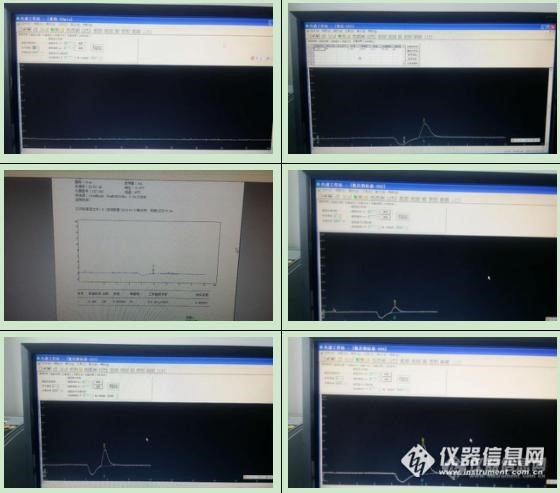
盛翰CIC300安培检测器进行氰化物检测方法研究 危险废物中的氰化物毒性较大,比较经典的化学方法有硝酸银滴定法、异烟酸-吡唑啉酮分光光度法和异烟酸-巴比妥酸分光光度法等。但其过程繁琐,本次运用盛翰CIC300离子色谱加国内较少的盛翰自产的安培检测器进行氰化物的检测研究。1 材料与方法1.1仪器及试剂 CIC300型离子色谱仪,淋洗液:100mmol/L氢氧化钠+50mmol/L醋酸钠+0.5%(体积比)乙二胺,氰化物标准物质。http://ng1.17img.cn/bbsfiles/images/2016/11/201611010814_615496_0_3.jpg1.2 色谱条件 分析柱为SI-52 4E日本柱,淋洗液流速0.7mL/min,安培检测器采用45度,直流安培,施加电位-0.07V。1.3 样品的前处理与分析 称取 5g(准确至 0.001g)过 180μm 筛且有代表性的固体废物于 250ml 烧杯中,加入 80ml 水,超声提取 30min。然后将其全部转移到 100ml 容量瓶中,用水定容。摇匀后,取部分溶液于3000rpm 速度离心 15min,取上清液。依次经过 0.22μm 尼龙滤膜和C18柱将提取液中的固体颗粒和有机物除去, 而后进样分析。 如果用于进样的溶液中氯离子含量超过 50mg/L, 则需要过C18柱将绝大部分氯离子去除。准确量取 50ml 浸出液,依次经过 0.22μm 尼龙滤膜和 C18 柱将提取液中的固体颗粒和有机物除去,而后进样分析。开启主机、电脑、显示器,主机预热10min。打开色谱工作站,将去离子水脱气:真空泵脱气3-5min。通淋洗液,在电位控制软件上设置电位-0.07V,在HW软件中采集信号,等待基线走稳。进样分析,方法如下: ①用去离子水将进样器、针头清洗干净。(注意:进样过程中手不要触及针头) ②用洗瓶将进样口清洗2-3次。 ③将阀打到“进样”位置,用注射器每次吸取2ml样品注入将进样口清洗3次。(注意:注射器中不能有气泡) ④注入1ml 样品。迅速将阀打至“分析”位置(注意动作要快,在1S内完成),点击“进样”按钮开始采集样品谱图。 ⑤样品谱图采集完毕,点击“停止”按钮,更改谱图文件名,将谱图保存。2 结果与讨论2.1精密度的测定 运用同一样品浓度进行处理,重复测量6次,计算其相对标准偏差,结果如表1http://ng1.17img.cn/bbsfiles/images/2016/11/201611010815_615498_0_3.jpghttp://ng1.17img.cn/bbsfiles/images/2016/11/201611010815_615497_0_3.jpghttp://ng1.17img.cn/bbsfiles/images/2016/11/201611010816_615499_0_3.jpg2.2准确度的测定对空白样品加标回收率可达70%-85%。2.3 注意事项1. 安培池使用完毕后需将参比电极旋转下来泡到饱和氯化钾溶液中。2. 安培池使用一段时间后需要将银电极拆下来使用打磨纸打磨。方法是将打磨纸上撒上打磨粉,滴上几滴去离子水,将电极放在上面画八字打磨。 实验证明盛翰CIC300配制自家安培检测可以对氰化物进行检测,可以满足日常需求,但是经我们测试,检出限的下限有待进一步优化,是我们后续的工作。
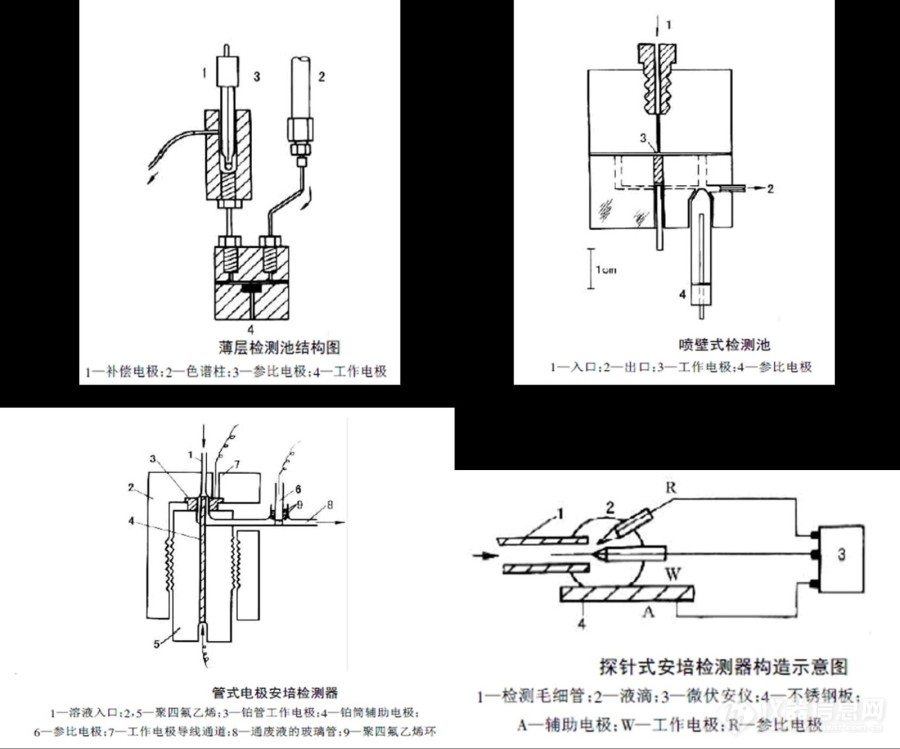
[font='times new roman'][size=16px]5.[/size][/font][font='times new roman'][size=16px]3.4 [/size][/font][font='times new roman'][size=16px]安培检测器[/size][/font][font='times new roman'][size=16px]各组成的[/size][/font][font='times new roman'][size=16px]结构[/size][/font][font='times new roman'][size=16px]常用的安培检测器分为[/size][/font][font='times new roman'][size=16px]恒[/size][/font][font='times new roman'][size=16px]电位器和电化学池两个部分。[/size][/font][font='times new roman'][size=16px]恒[/size][/font][font='times new roman'][size=16px]电位器的[/size][/font][font='times new roman'][size=16px]作用是[/size][/font][font='times new roman'][size=16px]在工作电极和参比电极之间提供一个不受[/size][/font][font='times new roman'][size=16px]电流变化影响[/size][/font][font='times new roman'][size=16px]的电位,该电位[/size][/font][font='times new roman'][size=16px]可根据检测需求进行[/size][/font][font='times new roman'][size=16px]选择,能够稳定参比电位从而提高检测器的稳定性。[/size][/font][font='times new roman'][size=16px]电化学池多为[/size][/font][font='times new roman'][size=16px]三电极伏安池,其结构图如图[/size][/font][font='times new roman'][size=16px]1.4[/size][/font][font='times new roman'][size=16px]所示,主要由对电极[/size][/font][font='times new roman'][size=16px]/[/size][/font][font='times new roman'][size=16px]辅助电极([/size][/font][font='times new roman'][size=16px]即池体[/size][/font][font='times new roman'][size=16px])、工作电极和参比电极组成,此外还有膜片(垫片)等配件。[/size][/font][img]https://ng1.17img.cn/bbsfiles/images/2021/11/202111231052212985_1657_1617661_3.png[/img][align=center][font='times new roman']图[/font][font='times new roman']1[/font][font='times new roman'].[/font][font='times new roman']4 [/font][font='times new roman']三电极电化学池结构图[/font][/align][font='times new roman'][size=16px]5.3.4.1 [/size][/font][font='times new roman'][size=16px]安培池[/size][/font][font='times new roman'][size=16px]的结构[/size][/font][img]" style="max-width: 100% max-height: 100% [/img][img=,690,574]https://ng1.17img.cn/bbsfiles/images/2021/11/202111231234293718_1035_1617661_3.jpg!w690x574.jpg[/img][align=center][font='times new roman'][/font][font='times new roman']1[/font][font='times new roman'].[/font][font='times new roman']5 [/font][font='times new roman']不同安培检测池结构图[/font][/align][font='times new roman'][size=16px]安培池可大致[/size][/font][font='times new roman'][size=16px]分为薄层式、喷壁式、开放管外式、[/size][/font][font='times new roman'][size=16px] [/size][/font][font='times new roman'][size=16px]探针式[/size][/font][font='times new roman'][size=16px]、和[/size][/font][font='times new roman'][size=16px]微电极簇式五种[/size][/font][font='times new roman'][size=16px][[/size][/font][font='times new roman'][size=16px]37-40][/size][/font][font='times new roman'][size=16px],[/size][/font][font='times new roman'][size=16px]此外还研制出了[/size][/font][font='times new roman'][size=16px]如喷壁[/size][/font][font='times new roman'][size=16px]-[/size][/font][font='times new roman'][size=16px]薄层安培检测器的复合式安培池[/size][/font][font='times new roman'][size=16px][[/size][/font][font='times new roman'][size=16px]41][/size][/font][font='times new roman'][size=16px]。图[/size][/font][font='times new roman'][size=16px]1.5[/size][/font][font='times new roman'][size=16px]为不同安培池的结构图。其中最早、最常用的是[/size][/font][font='times new roman'][size=16px]薄层式[/size][/font][font='times new roman'][size=16px],简称薄层池,检测范围为[/size][/font][font='times new roman'][size=16px]10[/size][/font][font='times new roman'][size=16px]-9[/size][/font][font='times new roman'][size=16px]-10[/size][/font][font='times new roman'][size=16px]-12[/size][/font][font='times new roman'][size=16px]mol/L[/size][/font][font='times new roman'][size=16px],在检测限和重现性方面都表现优异。这种检测[/size][/font][font='times new roman'][size=16px]池一般[/size][/font][font='times new roman'][size=16px]是由两块平板(有机玻璃或特种塑料板)以及中间膜片(中空的一种薄膜垫片)组成。中间膜片的形状、大小和厚度不同时,薄层池的容积也不同,容积过小会影响检测的灵敏度,太大会影响分离效果。[/size][/font][font='times new roman'][size=16px]薄层池的结构如图[/size][/font][font='times new roman'][size=16px]1.5[/size][/font][font='times new roman'][size=16px]中所示,工作电极在中央,对电极靠近工作电极,在出口处,参比电极在下游由这三个电极构成电化学反应中的回路。戴安([/size][/font][font='times new roman'][size=16px]Dionex[/size][/font][font='times new roman'][size=16px])公司生产的[url=https://insevent.instrument.com.cn/t/3p][color=#3333ff]离子色谱仪[/color][/url]中的安培检测器采用的也是薄层式安培池,但也有厂家使用[/size][/font][font='times new roman'][size=16px]喷壁式流通池[/size][/font][font='times new roman'][size=16px],[/size][/font][font='times new roman'][size=16px]例如[/size][/font][font='times new roman'][size=16px]Metrohm[/size][/font][font='times new roman'][size=16px]和[/size][/font][font='times new roman'][size=16px]Antec[/size][/font][font='times new roman'][size=16px]。[/size][/font][font='宋体'][size=16px]喷壁式检测池是样品通过喷嘴喷射到工作电极上进行检测的喷嘴通常制成圆锥形,对准工作电极的中心部位。辅助电极、参比电极以及分离隔膜不能距工作电极太近,以便在喷嘴和电极的之间有较小间隔[/size][/font][font='宋体'][size=16px]。[/size][/font][font='宋体'][size=16px]喷壁式检测池中流动相的流速很大,扩散层极薄,灵敏度[/size][/font][font='宋体'][size=16px]高[/size][/font][font='宋体'][size=16px],[/size][/font][font='宋体'][size=16px]但喷壁式[/size][/font][font='宋体'][size=16px]检测池的灵敏度和重现性比薄层池和管式池的要差一些。[/size][/font][font='times new roman'][size=16px] [/size][/font][font='times new roman'][size=16px]下面介绍不同厂家的安培检测池的结构[/size][/font][font='宋体'][size=16px]5.3.4.2[/size][/font][font='宋体'][size=16px] 热电(戴安)安培检测器[/size][/font][font='宋体'][size=16px]([/size][/font][font='宋体'][size=16px]池)[/size][/font][font='宋体'][size=16px]的结构[/size][/font][font='times new roman'][size=16px]1985[/size][/font][font='times new roman'][size=16px]年戴安公司首次推出安培检测器,[/size][/font][font='times new roman'][size=16px]当时[/size][/font][font='times new roman'][size=16px]仅仅[/size][/font][font='times new roman'][size=16px]只有[/size][/font][font='times new roman'][size=16px]直流安培,工作电极也只有[/size][/font][font='times new roman'][size=16px]Ag[/size][/font][font='times new roman'][size=16px]和[/size][/font][font='times new roman'][size=16px]Pt[/size][/font][font='times new roman'][size=16px]二种,参比电极为[/size][/font][font='times new roman'][size=16px]Ag/[/size][/font][font='times new roman'][size=16px]AgCl[/size][/font][font='times new roman'][size=16px]。其[/size][/font][font='times new roman'][size=16px]安培池的[/size][/font][font='times new roman'][size=16px]结构如下:[/size][/font][font='times new roman'][size=16px]流动相从工作电极到参比电极到对电极到出口。[/size][/font][align=center][img]https://ng1.17img.cn/bbsfiles/images/2021/11/202111231052218273_7507_1617661_3.jpeg[/img][/align][align=center]第一代安培池结构[/align][align=center][/align][size=16px]1986[/size][size=16px]年,戴安公司推出了脉冲安培,工作电极增加了[/size][size=16px]Au[/size][size=16px]和[/size][size=16px]GC[/size][size=16px],参比还是[/size][size=16px]Ag/[/size][size=16px]AgCl[/size][size=16px]。[/size][size=16px]其安培池的结构在原来的基础上有一些变化[/size][size=16px],尤其是工作电极。[/size][align=center][img]https://ng1.17img.cn/bbsfiles/images/2021/11/202111231052218864_5041_1617661_3.jpeg[/img][/align]第二代安培池的结构[size=16px]1990[/size][size=16px]年代末,[/size][size=16px]戴安推出[/size][size=16px]DX[/size][size=16px]系列[url=https://insevent.instrument.com.cn/t/3p][color=#3333ff]离子色谱仪[/color][/url],安培检测池的结构有了较大的变化,[/size][size=16px]参比电极变为[/size][size=16px]pH-[/size][size=16px]Ag/[/size][size=16px]AgCl[/size][size=16px]复合参比电极,工作电极变为平面电极,[/size][size=16px]可以使用一次性[/size][size=16px]工作[/size][size=16px]电极代替传统的工作电极。[/size][size=16px]但在实际应用中,仍存在一些缺点,参比电极的使用维护还是不够方便。[/size][size=16px]工作电极常用的为[/size][size=16px]1mm[/size][size=16px]。[/size][align=center][/align][img]https://ng1.17img.cn/bbsfiles/images/2021/11/202111231052222550_9107_1617661_3.jpeg[/img][img]https://ng1.17img.cn/bbsfiles/images/2021/11/202111231052223839_3169_1617661_3.png[/img]第三代安培池的实物示意图[font='times new roman'][size=16px]二十一世纪初,戴安推出[/size][/font][font='times new roman'][size=16px]新[/size][/font][font='times new roman'][size=16px]的[/size][/font][font='times new roman'][size=16px]ICS[/size][/font][font='times new roman'][size=16px]系列[/size][/font][font='times new roman'][size=16px][url=https://insevent.instrument.com.cn/t/3p][color=#3333ff]离子色谱[/color][/url][/size][/font][font='times new roman'][size=16px],推出了第四代安培池,从外观上看,整体结构有了较大的变化,[/size][/font][font='times new roman'][size=16px]使用[/size][/font][font='times new roman'][size=16px]操作维护更为简单,尤其参比电极在使用上比原来方便[/size][/font][font='times new roman'][size=16px]安全[/size][/font][font='times new roman'][size=16px]多了,[/size][/font][font='times new roman'][size=16px]但[/size][/font][font='times new roman'][size=16px]与第三代安培池的结构比较,其实际的仪器参数结构并没有[/size][/font][font='times new roman'][size=16px]本质[/size][/font][font='times new roman'][size=16px]改变,本质上二者并没有差异。[/size][/font][font='times new roman'][size=16px]因此在仪器结构上[/size][/font][font='times new roman'][size=16px]仍[/size][/font][font='times new roman'][size=16px]存在一些不足。[/size][/font][font='times new roman'][size=16px]与第三代相比仅有膜片可以通用,参比电极和工作电极接口和外观尺寸都有一定的变化。[/size][/font][font='times new roman'][size=16px]安培[/size][/font][font='times new roman'][size=16px]池独立[/size][/font][font='times new roman'][size=16px]出来,三电极采用二根连接线与安培检测器相连,整个结构适合新仪器的设计。[/size][/font][font='times new roman'][size=16px][/size][/font][img=,532,278]https://ng1.17img.cn/bbsfiles/images/2021/11/202111231236456252_9292_1617661_3.jpg!w532x278.jpg[/img][align=center][img]" style="max-width: 100% max-height: 100% [/img][/align][align=center][font='times new roman'][size=16px]第四代安培池结构[/size][/font][/align][align=center][/align][font='times new roman'][size=16px]5.3.4.3 [/size][/font][font='times new roman'][size=16px]万通安培[/size][/font][font='times new roman'][size=16px]检测器[/size][/font][font='times new roman'][size=16px](池)[/size][/font][font='times new roman'][size=16px]的[/size][/font][font='times new roman'][size=16px]结构[/size][/font][font='times new roman'][size=16px] [/size][/font][font='times new roman'][size=16px]万通安培检测器有薄层式和[/size][/font][size=16px]壁射[/size][size=16px]式[/size][size=16px]二种,其结构如下:[/size][img]https://ng1.17img.cn/bbsfiles/images/2021/11/202111231052225558_3661_1617661_3.jpeg[/img][font='times new roman'][size=16px] [/size][/font][font='times new roman'][size=16px] [/size][/font][size=16px]薄层式([/size][size=16px]Thin–Layer Cell[/size][size=16px])安培池[/size][img]https://ng1.17img.cn/bbsfiles/images/2021/11/202111231052224001_9498_1617661_3.jpeg[/img][font='times new roman'][size=16px] [/size][/font][align=center][font='times new roman'][size=16px] [/size][/font][size=16px]壁射式([/size][size=16px]Wall-Jet Cell[/size][size=16px])安培池[/size][/align][align=center][/align][align=left][img]https://ng1.17img.cn/bbsfiles/images/2021/11/202111231052225456_787_1617661_3.png[/img][img]https://ng1.17img.cn/bbsfiles/images/2021/11/202111231052229650_1305_1617661_3.png[/img][/align][align=center][/align][align=center][img]https://ng1.17img.cn/bbsfiles/images/2021/11/202111231052228122_8645_1617661_3.png[/img][/align][align=center][size=16px]工作电极、安培池、参比电极[/size][/align][font='times new roman'][size=16px]万通安培检测器采用[/size][/font][font='times new roman'][size=16px]PEEK[/size][/font][font='times new roman'][size=16px]外[/size][/font][font='times new roman'][size=16px]体材[/size][/font][font='times new roman'][size=16px]料,[/size][/font][font='times new roman'][size=16px]RE [/size][/font][font='times new roman'][size=16px]参比电极,[/size][/font][font='times new roman'][size=16px]WE [/size][/font][font='times new roman'][size=16px]工作电极,[/size][/font][font='times new roman'][size=16px]AE [/size][/font][font='times new roman'][size=16px]对电极[/size][/font][font='times new roman'][size=16px](不锈钢)[/size][/font][font='times new roman'][size=16px],[/size][/font][font='times new roman'][size=16px]三种电极连接采用不同颜色来区分。[/size][/font][font='times new roman'][size=16px]工作电极为柱状电极,[/size][/font][font='times new roman'][size=16px]有五种,分别为[/size][/font][font='times new roman'][size=16px]Au[/size][/font][font='times new roman'][size=16px]、[/size][/font][font='times new roman'][size=16px]Ag[/size][/font][font='times new roman'][size=16px]、[/size][/font][font='times new roman'][size=16px]Pt[/size][/font][font='times new roman'][size=16px]、[/size][/font][font='times new roman'][size=16px]GC[/size][/font][font='times new roman'][size=16px]、[/size][/font][font='times new roman'][size=16px]Cu[/size][/font][font='times new roman'][size=16px],常规电极直径[/size][/font][font='times new roman'][size=16px]3[/size][/font][font='times new roman'][size=16px]mm[/size][/font][font='times new roman'][size=16px]([/size][/font][font='times new roman'][size=16px]Au[/size][/font][font='times new roman'][size=16px]、[/size][/font][font='times new roman'][size=16px]Ag[/size][/font][font='times new roman'][size=16px]、[/size][/font][font='times new roman'][size=16px]Pt[/size][/font][font='times new roman'][size=16px]、[/size][/font][font='times new roman'][size=16px]GC[/size][/font][font='times new roman'][size=16px]、)[/size][/font][font='times new roman'][size=16px]和[/size][/font][font='times new roman'][size=16px]2mm[/size][/font][font='times new roman'][size=16px]([/size][/font][font='times new roman'][size=16px]Au[/size][/font][font='times new roman'][size=16px]、[/size][/font][font='times new roman'][size=16px]Cu[/size][/font][font='times new roman'][size=16px])[/size][/font][font='times new roman'][size=16px],垫片厚度[/size][/font][font='times new roman'][size=16px]25[/size][/font][font='times new roman'][size=16px]和[/size][/font][font='times new roman'][size=16px]50um[/size][/font][font='times new roman'][size=16px],[/size][/font][font='times new roman'][size=16px]参比电极有二种,[/size][/font][font='times new roman'][size=16px]Pd[/size][/font][font='times new roman'][size=16px]H[/size][/font][font='times new roman'][size=16px]电极和[/size][/font][font='times new roman'][size=16px]Ag/[/size][/font][font='times new roman'][size=16px]AgCl[/size][/font][font='times new roman'][size=16px]参比电极。[/size][/font][font='times new roman'][size=16px]5.3.4.4 [/size][/font][font='times new roman'][size=16px]Antec[/size][/font][font='times new roman'][size=16px] [/size][/font][font='times new roman'][size=16px]安培[/size][/font][font='times new roman'][size=16px]检测器[/size][/font][font='times new roman'][size=16px]([/size][/font][font='times new roman'][size=16px]池)[/size][/font][font='times new roman'][size=16px]的[/size][/font][font='times new roman'][size=16px]结构[/size][/font][img]" style="max-width: 100% max-height: 100% [/img][img]" style="max-width: 100% max-height: 100% [/img][font='times new roman'][size=16px]FLex[/size][/font][font='times new roman'][size=16px] cell[/size][/font][font='times new roman'][size=16px]([/size][/font][font='times new roman'][size=16px]The most versatile flow cell for Electrochemical Detection[/size][/font][font='times new roman'][size=16px])[/size][/font][font='times new roman'][size=16px]-[/size][/font][font='times new roman'][size=16px]用于[url=https://insevent.instrument.com.cn/t/3p][color=#3333ff]离子色谱[/color][/url][/size][/font][img]" style="max-width: 100% max-height: 100% [/img][font='times new roman'][size=16px]5.3.4.5 [/size][/font][font='times new roman'][size=16px]工作电极[/size][/font][font='times new roman'][size=16px]安培检测器采用固体工作电极,主要有[/size][/font][font='times new roman'][size=16px]Ag[/size][/font][font='times new roman'][size=16px]电极、[/size][/font][font='times new roman'][size=16px]Pt[/size][/font][font='times new roman'][size=16px]电极[/size][/font][font='times new roman'][size=16px]A[/size][/font][font='times new roman'][size=16px]u[/size][/font][font='times new roman'][size=16px]电极[/size][/font][font='times new roman'][size=16px]、[/size][/font][font='times new roman'][size=16px]玻[/size][/font][font='times new roman'][size=16px]碳电极、[/size][/font][font='times new roman'][size=16px]Cu[/size][/font][font='times new roman'][size=16px]电极和钻石电极等,常见的为前面四种,[/size][/font][font='times new roman'][size=16px]主要[/size][/font][font='times new roman'][size=16px]工作电极的极限电位及其应用如表[/size][/font][font='times new roman'][size=16px]1.2[/size][/font][font='times new roman'][size=16px]。当电位超过表中的限制时,流动相分析物中的水发生电解,从而显著增加背景电流和噪音。[/size][/font][align=center][font='times new roman']表[/font][font='times new roman']1[/font][font='times new roman'].[/font][font='times new roman']2 [/font][font='times new roman']主要[/font][font='times new roman']工作电极的电位限制[/font][/align][align=center][/align][table][tr][td][align=center][font='times new roman']工作电极材料[/font][/align][/td][td][align=center][font='times new roman']碱性条件下的电位限制([/font][font='times new roman']V[/font][font='times new roman'])[/font][/align][/td][td][align=center][font='times new roman']酸性条件下的电位限制([/font][font='times new roman']V[/font][font='times new roman'])[/font][/align][/td][/tr][tr][td][align=center][font='times new roman']玻[/font][font='times new roman']碳([/font][font='times new roman']GC[/font][font='times new roman'])[/font][/align][/td][td][align=center][font='times new roman']-1.50[/font][font='times new roman']到[/font][font='times new roman']+0.60[/font][/align][/td][td][align=center][font='times new roman']-0.80[/font][font='times new roman']到[/font][font='times new roman']+1.30[/font][/align][/td][/tr][tr][td][align=center][font='times new roman']金([/font][font='times new roman']Au[/font][font='times new roman'])[/font][/align][/td][td][align=center][font='times new roman']-1.25[/font][font='times new roman']到[/font][font='times new roman']+0.75[/font][/align][/td][td][align=center][font='times new roman']-0.35[/font][font='times new roman']到[/font][font='times new roman']+1.10[/font][/align][/td][/tr][tr][td][align=center][font='times new roman']铂([/font][font='times new roman']Pt[/font][font='times new roman'])[/font][/align][/td][td][align=center][font='times new roman']-0.90[/font][font='times new roman']到[/font][font='times new roman']+0.65[/font][/align][/td][td][align=center][font='times new roman']-0.20[/font][font='times new roman']到[/font][font='times new roman']+1.30[/font][/align][/td][/tr][tr][td][align=center][font='times new roman']银([/font][font='times new roman']Ag[/font][font='times new roman'])[/font][/align][/td][td][align=center][font='times new roman']-1.20[/font][font='times new roman']到[/font][font='times new roman']+0.10[/font][/align][/td][td][align=center][font='times new roman']-0.55[/font][font='times new roman']到[/font][font='times new roman']+0.40[/font][/align][/td][/tr][tr][td][align=center][font='times new roman']铜([/font][font='times new roman']Cu[/font][font='times new roman'])[/font][/align][/td][td][align=center][font='times new roman']-1.2[/font][font='times new roman']0[/font][font='times new roman']到[/font][font='times new roman']-0.35[/font][/align][/td][td][align=center][font='times new roman']-0.50[/font][font='times new roman']到[/font][font='times new roman']-0.05[/font][/align][/td][/tr][/table][font='times new roman'][size=16px]主要[/size][/font][font='times new roman'][size=16px]工作电极的[/size][/font][font='times new roman'][size=16px]主要[/size][/font][font='times new roman'][size=16px]应用场景[/size][/font][table][tr][td][font='times new roman'][size=16px]工作电极[/size][/font][/td][td][font='times new roman'][size=16px]检测模式[/size][/font][/td][td][font='times new roman'][size=16px]色谱条件[/size][/font][/td][td][font='times new roman'][size=16px]主要应用类型[/size][/font][/td][/tr][tr][td][font='times new roman'][size=16px]Au[/size][/font][/td][td][font='times new roman'][size=16px]脉冲[/size][/font][font='times new roman'][size=16px]/[/size][/font][font='times new roman'][size=16px]积分[/size][/font][/td][td][font='times new roman'][size=16px]碱性,[/size][/font][font='times new roman'][size=16px]等度[/size][/font][font='times new roman'][size=16px]或[/size][/font][font='times new roman'][size=16px]梯度[/size][/font][font='times new roman'][size=16px]淋洗[/size][/font][/td][td][font='times new roman'][size=16px]糖类[/size][/font][/td][/tr][tr][td] [/td][td][font='times new roman'][size=16px]脉冲[/size][/font][font='times new roman'][size=16px]/[/size][/font][font='times new roman'][size=16px]积分[/size][/font][/td][td][font='times new roman'][size=16px]酸性[/size][/font][font='times new roman'][size=16px]或中性[/size][/font][font='times new roman'][size=16px]淋洗,柱后碱性补液[/size][/font][/td][td][font='times new roman'][size=16px]醇、[/size][/font][font='times new roman'][size=16px]有机[/size][/font][font='times new roman'][size=16px]胺类[/size][/font][/td][/tr][tr][td] [/td][td][font='times new roman'][size=16px]积分安培[/size][/font][/td][td][font='times new roman'][size=16px]梯度[/size][/font][font='times new roman'][size=16px]淋洗[/size][/font][font='times new roman'][size=16px],柱后[/size][/font][font='times new roman'][size=16px]碱性[/size][/font][font='times new roman'][size=16px]补液[/size][/font][font='times new roman'][size=16px],[/size][/font][font='times new roman'][size=16px] [/size][/font][/td][td][font='times new roman'][size=16px]抗生素[/size][/font][/td][/tr][tr][td] [/td][td][font='times new roman'][size=16px]脉冲[/size][/font][font='times new roman'][size=16px]/[/size][/font][font='times new roman'][size=16px]积分[/size][/font][/td][td][font='times new roman'][size=16px]碱性,梯度淋洗液[/size][/font][/td][td][font='times new roman'][size=16px]糖醇类[/size][/font][/td][/tr][tr][td] [/td][td][font='times new roman'][size=16px]积分[/size][/font][/td][td][font='times new roman'][size=16px]碱性,梯度淋洗液[/size][/font][/td][td][font='times new roman'][size=16px]唾液酸[/size][/font][/td][/tr][tr][td] [/td][td][font='times new roman'][size=16px]积分[/size][/font][/td][td][font='times new roman'][size=16px]碱性,梯度淋洗液[/size][/font][/td][td][font='times new roman'][size=16px]蛋白质[/size][/font][/td][/tr][tr][td] [/td][td][font='times new roman'][size=16px]积分[/size][/font][/td][td][font='times new roman'][size=16px]碱性,梯度淋洗液[/size][/font][/td][td][font='times new roman'][size=16px]氨基酸[/size][/font][/td][/tr][tr][td][font='times new roman'][size=16px]Pt[/size][/font][/td][td][font='times new roman'][size=16px]脉冲[/size][/font][/td][td][font='times new roman'][size=16px]离子排斥,酸性淋洗液[/size][/font][/td][td][font='times new roman'][size=16px]醇,[/size][/font][font='times new roman'][size=16px]碘、[/size][/font][font='times new roman'][size=16px]叠氮根,硫根,氰根,亚硫酸根等[/size][/font][/td][/tr][tr][td][font='times new roman'][size=16px]Ag[/size][/font][/td][td][font='times new roman'][size=16px]直流[/size][/font][/td][td][font='times new roman'][size=16px]碱性[/size][/font][font='times new roman'][size=16px]/[/size][/font][font='times new roman'][size=16px]酸性淋洗液[/size][/font][/td][td][font='times new roman'][size=16px]溴根、硫代硫酸根,亚硫酸根,硫氰酸根,氰根,[/size][/font][font='times new roman'][size=16px]碘、[/size][/font][font='times new roman'][size=16px]硫根等[/size][/font][/td][/tr][tr][td] [/td][td][font='times new roman'][size=16px]脉冲[/size][/font][/td][td][font='times new roman'][size=16px]碱性[/size][/font][/td][td][font='times new roman'][size=16px]基本同上[/size][/font][/td][/tr][tr][td][font='times new roman'][size=16px]GC[/size][/font][/td][td][font='times new roman'][size=16px]脉冲[/size][/font][/td][td][font='times new roman'][size=16px]碱性[/size][/font][/td][td][font='times new roman'][size=16px]儿茶酚胺,酚类[/size][/font][/td][/tr][tr][td] [/td][td][font='times new roman'][size=16px]直流[/size][/font][/td][td][font='times new roman'][size=16px]缓冲液[/size][/font][/td][td][font='times new roman'][color=#000000]I[/color][/font][font='times new roman'][size=13px][color=#000000]-[/color][/size][/font][font='times new roman'][color=#000000], Br[/color][/font][font='times new roman'][size=13px][color=#000000]-[/color][/size][/font][font='times new roman'][color=#000000], S[/color][/font][font='times new roman'][size=13px][color=#000000]2[/color][/size][/font][font='times new roman'][size=13px][color=#000000]-[/color][/size][/font][font='times new roman'][color=#000000] [/color][/font][font='times new roman'][color=#000000],[/color][/font][font='times new roman'][color=#000000]SO[/color][/font][font='times new roman'][size=13px][color=#000000]3[/color][/size][/font][font='times new roman'][size=13px][color=#000000]2[/color][/size][/font][font='times new roman'][size=13px][color=#000000]-[/color][/size][/font][font='times new roman'][color=#000000] , S[/color][/font][font='times new roman'][size=13px][color=#000000]2[/color][/size][/font][font='times new roman'][color=#000000]O[/color][/font][font='times new roman'][size=13px][color=#000000]3[/color][/size][/font][font='times new roman'][size=13px][color=#000000]2[/color][/size][/font][font='times new roman'][size=13px][color=#000000]-[/color][/size][/font][font='times new roman'][color=#000000] , SCN[/color][/font][font='times new roman'][size=13px][color=#000000]-[/color][/size][/font][font='times new roman'][size=13px][color=#000000] [/color][/size][/font][font='times new roman'][color=#000000], NO[/color][/font][font='times new roman'][size=13px][color=#000000]2[/color][/size][/font][font='times new roman'][size=13px][color=#000000]-[/color][/size][/font][font='times new roman'][color=#000000]等[/color][/font][/td][/tr][tr][td][font='times new roman'][size=16px]Cu[/size][/font][/td][td][font='times new roman'][size=16px]脉冲[/size][/font][/td][td][font='times new roman'][size=16px]碱性淋洗液[/size][/font][/td][td][font='times new roman'][size=16px]单双糖等[/size][/font][/td][/tr][tr][td][font='times new roman'][size=16px]Cu[/size][/font][/td][td][font='times new roman'][size=16px]直流[/size][/font][/td][td][font='times new roman'][size=16px]液相流动相[/size][/font][/td][td][font='times new roman'][size=16px]草甘[/size][/font][font='times new roman'][size=16px]膦[/size][/font][/td][/tr][tr][td][font='times new roman'][size=16px]钻石[/size][/font][/td][td][font='times new roman'][size=16px]直流[/size][/font][/td][td][font='times new roman'][size=16px]液相流动相[/size][/font][/td][td][font='times new roman'][size=16px]谷[/size][/font][font='times new roman'][size=16px]胱[/size][/font][font='times new roman'][size=16px]肝肽[/size][/font][/td][/tr][/table][font='宋体'][size=16px]工作电极表面反应的原理并不是简单的金属与被测样品发生氧化还原反应,[/size][/font][font='times new roman'][size=16px]Googenough[/size][/font][font='宋体'][size=16px]等[/size][/font][font='times new roman'][size=16px][[/size][/font][font='times new roman'][size=16px]91[/size][/font][font='times new roman'][size=16px]][/size][/font][font='宋体'][size=16px]发现,在比较[/size][/font][font='times new roman'][size=16px] [/size][/font][font='times new roman'][size=16px]Pt[/size][/font][font='times new roman'][size=16px]/C[/size][/font][font='宋体'][size=16px] 电极[/size][/font][font='宋体'][size=16px]和铂黑电极[/size][/font][font='宋体'][size=16px]时,[/size][/font][font='times new roman'][size=16px] [/size][/font][font='times new roman'][size=16px]Pt[/size][/font][font='times new roman'][size=16px]/C [/size][/font][font='宋体'][size=16px]电极具有更低的过电位,相对低的[/size][/font][font='times new roman'][size=16px]Pt[/size][/font][font='times new roman'][size=16px] [/size][/font][font='宋体'][size=16px]载量时得到了很高的电流密度值。[/size][/font][font='times new roman'][size=16px]Attwood[/size][/font][font='times new roman'][size=16px][92[/size][/font][font='times new roman'][size=16px]][/size][/font][font='宋体'][size=16px]等人的实验证实了电极表面的电化学反应是在金属和载体炭的相互作用的基础上进行。[/size][/font][font='宋体'][size=16px]Ag工作电极的反应机理:[/size][/font][font='宋体'][size=16px]王维宇[/size][/font][font='times new roman'][size=16px][90[/size][/font][font='times new roman'][size=16px]][/size][/font][font='宋体'][size=16px]等研究银氧电极的高比能电池的进展,银电极的工作原理[/size][/font][font='宋体'][size=16px]是银氧混合物[/size][/font][font='宋体'][size=16px]作为银电极表面的活性物质,活性物质发生氧化还原的反应。而非简单的银金属发生反应。银工作电极反应的稳定性和灵敏度直接[/size][/font][font='宋体'][size=16px]受到银氧混合物[/size][/font][font='宋体'][size=16px]氧化层的致密性和比例的影响。[/size][/font][font='宋体'][size=16px]银工作电极表面的活性物质主要[/size][/font][font='宋体'][size=16px]是银氧混合物[/size][/font][font='times new roman'][size=16px]Ag[/size][/font][font='times new roman'][size=16px]O[/size][/font][font='times new roman'][size=16px]、[/size][/font][font='times new roman'][size=16px]Ag[/size][/font][font='times new roman'][size=16px]2[/size][/font][font='times new roman'][size=16px]O[/size][/font][font='times new roman'][size=16px]、[/size][/font][font='times new roman'][size=16px]Ag[/size][/font][font='times new roman'][size=16px]2[/size][/font][font='times new roman'][size=16px]O[/size][/font][font='times new roman'][size=16px]3[/size][/font][font='times new roman'][size=16px][93][/size][/font][font='times new roman'][size=16px],[/size][/font][font='times new roman'][size=16px]AgO[/size][/font][font='times new roman'][size=16px] [/size][/font][font='宋体'][size=16px]的分解活化能比较小,[/size][/font][font='宋体'][size=16px]较低的活化能可使[/size][/font][font='times new roman'][size=16px]AgO[/size][/font][font='宋体'][size=16px]容易分解。长时间使用或者放置空气较长时间的工作电极[/size][/font][font='宋体'][size=16px],[/size][/font][font='times new roman'][size=16px]Ag[/size][/font][font='times new roman'][size=16px]2[/size][/font][font='times new roman'][size=16px]O[/size][/font][font='times new roman'][size=16px]和[/size][/font][font='times new roman'][size=16px]Ag[/size][/font][font='times new roman'][size=16px]2[/size][/font][font='times new roman'][size=16px]O[/size][/font][font='times new roman'][size=16px]3[/size][/font][font='times new roman'][size=16px]在[/size][/font][font='宋体'][size=16px]银氧混合物[/size][/font][font='宋体'][size=16px]中[/size][/font][font='宋体'][size=16px]占比较[/size][/font][font='宋体'][size=16px]多,[/size][/font][font='times new roman'][size=16px]Ag[/size][/font][font='times new roman'][size=16px]O[/size][/font][font='times new roman'][size=16px]在[/size][/font][font='宋体'][size=16px]银氧混合物[/size][/font][font='宋体'][size=16px]中[/size][/font][font='宋体'][size=16px]占比较[/size][/font][font='宋体'][size=16px]少时,银工作电极表面的活性较小。银工作电极表面[/size][/font][font='宋体'][size=16px]的银氧混合物[/size][/font][font='times new roman'][size=16px]Ag[/size][/font][font='times new roman'][size=16px]O[/size][/font][font='times new roman'][size=16px]、[/size][/font][font='times new roman'][size=16px]Ag[/size][/font][font='times new roman'][size=16px]2[/size][/font][font='times new roman'][size=16px]O[/size][/font][font='times new roman'][size=16px]、[/size][/font][font='times new roman'][size=16px]Ag[/size][/font][font='times new roman'][size=16px]2[/size][/font][font='times new roman'][size=16px]O[/size][/font][font='times new roman'][size=16px]3[/size][/font][font='times new roman'][size=16px]占比合适,[/size][/font][font='宋体'][size=16px]银工作电极表面发生的电化学反应总电位为正。[/size][/font][font='宋体'][size=16px]打磨之后将长期形成较多[/size][/font][font='times new roman'][size=16px]Ag[/size][/font][font='times new roman'][size=16px]2[/size][/font][font='times new roman'][size=16px]O[/size][/font][font='times new roman'][size=16px]、[/size][/font][font='times new roman'][size=16px]Ag[/size][/font][font='times new roman'][size=16px]2[/size][/font][font='times new roman'][size=16px]O[/size][/font][font='times new roman'][size=16px]3[/size][/font][font='宋体'][size=16px]氧化层刨除,将银[/size][/font][font='times new roman'][size=16px]工作电极的[/size][/font][font='times new roman'][size=16px]Ag[/size][/font][font='times new roman'][size=16px]裸露出来,方便安培检测器给予[/size][/font][font='宋体'][size=16px]银[/size][/font][font='times new roman'][size=16px]工作电极施加电位[/size][/font][font='times new roman'][size=16px]E[/size][/font][font='times new roman'][size=16px]app[/size][/font][font='times new roman'][size=16px],在施加电位[/size][/font][font='times new roman'][size=16px]E[/size][/font][font='times new roman'][size=16px]app[/size][/font][font='times new roman'][size=16px]的作用下发生电化学反应:[/size][/font][align=center][font='times new roman'][size=16px]Ag[/size][/font][font='times new roman'][size=16px]O+[/size][/font][font='times new roman'][size=16px]Ag[/size][/font][font='times new roman'][size=16px]=[/size][/font][font='times new roman'][size=16px]Ag[/size][/font][font='times new roman'][size=16px]2[/size][/font][font='times new roman'][size=16px]O[/size][/font][font='times new roman'][size=16px]([/size][/font][font='times new roman'][size=16px]1-1[/size][/font][font='times new roman'][size=16px])[/size][/font][font='times new roman'][size=16px][93][/size][/font][/align][font='times new roman'][size=16px]Ag[/size][/font][font='times new roman'][size=16px]工作电极的打磨,抛除[/size][/font][font='times new roman'][size=16px]Ag[/size][/font][font='times new roman'][size=16px]2[/size][/font][font='times new roman'][size=16px]O[/size][/font][font='times new roman'][size=16px]、[/size][/font][font='times new roman'][size=16px]Ag[/size][/font][font='times new roman'][size=16px]2[/size][/font][font='times new roman'][size=16px]O[/size][/font][font='times new roman'][size=16px]3[/size][/font][font='times new roman'][size=16px]占比较[/size][/font][font='times new roman'][size=16px]多,[/size][/font][font='times new roman'][size=16px]Ag[/size][/font][font='times new roman'][size=16px]O[/size][/font][font='times new roman'][size=16px]占比较少的[/size][/font][font='宋体'][size=16px]氧化层[/size][/font][font='宋体'][size=16px]。[/size][/font][font='times new roman'][size=16px]工作电极抛光方式及抛光材料影响工作电极表面的光滑度和打磨程度。刚打磨结束的工作电极需要形成氧化层,合适[/size][/font][font='times new roman'][size=16px]Ag[/size][/font][font='times new roman'][size=16px]O[/size][/font][font='times new roman'][size=16px]、[/size][/font][font='times new roman'][size=16px]Ag[/size][/font][font='times new roman'][size=16px]2[/size][/font][font='times new roman'][size=16px]O[/size][/font][font='times new roman'][size=16px]、[/size][/font][font='times new roman'][size=16px]Ag[/size][/font][font='times new roman'][size=16px]2[/size][/font][font='times new roman'][size=16px]O[/size][/font][font='times new roman'][size=16px]3[/size][/font][font='times new roman'][size=16px]占比的致密氧化层会增加测定结果的灵敏度、基线背景稳定性。[/size][/font][font='times new roman'][size=16px]按照形状[/size][/font][font='times new roman'][size=16px]来分,工作电极[/size][/font][font='times new roman'][size=16px]有柱状、板状、线状、[/size][/font][font='times new roman'][size=16px]平面[/size][/font][font='times new roman'][size=16px]和圆盘电极等,最常用的是[/size][/font][font='times new roman'][size=16px]平面和圆盘电极,且具有几种不同的直径可供选用,常见的[/size][/font][font='times new roman'][size=16px]电极[/size][/font][font='times new roman'][size=16px]直径规格为[/size][/font][font='times new roman'][size=16px]1 mm[/size][/font][font='times new roman'][size=16px]、[/size][/font][font='times new roman'][size=16px]2mm[/size][/font][font='times new roman'][size=16px]和[/size][/font][font='times new roman'][size=16px]3mm[/size][/font][font='times new roman'][size=16px],此外还有[/size][/font][font='times new roman'][size=16px]0.7 mm[/size][/font][font='times new roman'][size=16px]和[/size][/font][font='times new roman'][size=16px]6 mm[/size][/font][font='times new roman'][size=16px]等[/size][/font][font='times new roman'][size=16px]。[/size][/font][font='times new roman'][size=16px]热电公司,还有一种一次性的工作电极,电极直径采用[/size][/font][font='times new roman'][size=16px]2mm[/size][/font][font='times new roman'][size=16px]而不是[/size][/font][font='times new roman'][size=16px]1mm[/size][/font][font='times new roman'][size=16px]。[/size][/font][font='times new roman'][size=16px]在实际使用中,热电基本采用[/size][/font][font='times new roman'][size=16px]1mm[/size][/font][font='times new roman'][size=16px]的电极,[/size][/font][font='times new roman'][size=16px]3mm[/size][/font][font='times new roman'][size=16px]电极用于特定领域,万通基本采用[/size][/font][font='times new roman'][size=16px]3[/size][/font][font='times new roman'][size=16px]mm[/size][/font][font='times new roman'][size=16px]的电极,[/size][/font][font='times new roman'][size=16px]也有用[/size][/font][font='times new roman'][size=16px]2mm[/size][/font][font='times new roman'][size=16px]的[/size][/font][font='times new roman'][size=16px]。[/size][/font][font='times new roman'][size=16px]安培检测器工作时,电解的电流与工作电极面积成正比,但电极面积的增加会引起电容电流的增大,测量时需要选择较大的电流量程,系统的信号和噪音会随着工作电极的直径线性增加[/size][/font][font='times new roman'][size=16px][[/size][/font][font='times new roman'][size=16px]41][/size][/font][font='times new roman'][size=16px]。此外可以通过对电极表面进行修饰,提高其选择性和灵敏度。例如多组氨酸化学修饰电极被证明可以极大地改善伏安波,并增加酚类化合物的电流响应,电极具有良好的稳定性[/size][/font][font='times new roman'][size=16px][[/size][/font][font='times new roman'][size=16px]42][/size][/font][font='times new roman'][size=16px]。[/size][/font][font='times new roman'][size=16px]工作电极都是表面经过严格抛光制成的,工作电极的材质和其表面处理情况对检测器性能影响非常大,所以当电极使用一段时间后,需使用专用工具对其进行抛光,除去表面残留的污染物。[/size][/font][font='times new roman'][size=16px]5[/size][/font][font='times new roman'][size=16px].[/size][/font][font='times new roman'][size=16px]3[/size][/font][font='times new roman'][size=16px].[/size][/font][font='times new roman'][size=16px]4.6[/size][/font][font='times new roman'][size=16px] [/size][/font][font='times new roman'][size=16px]参比电极[/size][/font][font='times new roman'][size=16px]参比电极是在检测时提供一个基准电位。[/size][/font][font='宋体'][size=16px]参比电极主要有钯氢电极([/size][/font][font='times new roman'][size=16px]Pd[/size][/font][font='times new roman'][size=16px]/H[/size][/font][font='宋体'][size=16px])[/size][/font][font='times new roman'][size=16px][57,58][/size][/font][font='宋体'][size=16px]、[/size][/font][font='times new roman'][size=16px]Ag/[/size][/font][font='times new roman'][size=16px]AgCl[/size][/font][font='times new roman'][size=16px]参比电极[/size][/font][font='times new roman'][size=16px][59[/size][/font][font='宋体'][size=16px]~[/size][/font][font='times new roman'][size=16px]64][/size][/font][font='times new roman'][size=16px]、[/size][/font][font='times new roman'][size=16px]pH-Ag/[/size][/font][font='times new roman'][size=16px]AgCl[/size][/font][font='times new roman'][size=16px]复合参比电极[/size][/font][font='times new roman'][size=16px][65[/size][/font][font='times new roman'][size=16px]~[/size][/font][font='times new roman'][size=16px]67[/size][/font][font='times new roman'][size=16px]][/size][/font][font='times new roman'][size=16px]。[/size][/font][font='times new roman'][size=16px]氢参比电极在基线稳定和信噪比方面与[/size][/font][font='times new roman'][size=16px]A[/size][/font][font='times new roman'][size=16px]g/[/size][/font][font='times new roman'][size=16px]AgCl[/size][/font][font='times new roman'][size=16px]电极差别不大,并且不需要维护,[/size][/font][font='times new roman'][size=16px]不会聚集起泡,[/size][/font][font='times new roman'][size=16px]但氢电极只是一个理想但不易于实现的电极。[/size][/font][font='times new roman'][size=16px]在实际中采用[/size][/font][font='宋体'][size=16px]钯[/size][/font][font='宋体'][size=16px]氢电极([/size][/font][font='times new roman'][size=16px]Pd[/size][/font][font='times new roman'][size=16px]/H[/size][/font][font='宋体'][size=16px]),[/size][/font][font='times new roman'][size=16px]钯[/size][/font][font='times new roman'][size=16px]氢电极[/size][/font][font='宋体'][size=16px]([/size][/font][font='times new roman'][size=16px]Pd[/size][/font][font='times new roman'][size=16px]/H[/size][/font][font='宋体'][size=16px])对淋洗液的[/size][/font][font='times new roman'][size=16px]p[/size][/font][font='times new roman'][size=16px]H[/size][/font][font='times new roman'][size=16px]值响应灵敏且对[/size][/font][font='times new roman'][size=16px]p[/size][/font][font='times new roman'][size=16px]H[/size][/font][font='times new roman'][size=16px]值响应稳定,[/size][/font][font='times new roman'][size=16px]Pd[/size][/font][font='times new roman'][size=16px]作为催化剂。[/size][/font][font='times new roman'][size=16px]甘汞电极由汞、甘汞和氯化钾溶液等组成,其电极电势与氯化钾浓度和所处温度有关,性能在较高温时会大打折扣。[/size][/font][font='times new roman'][size=16px]Ag/AgC1[/size][/font][font='宋体'][size=16px]参比电极均为银丝经阴极氯化而制成[/size][/font][font='宋体'][size=16px]。[/size][/font][font='times new roman'][size=16px]pH-Ag/[/size][/font][font='times new roman'][size=16px]AgCl[/size][/font][font='times new roman'][size=16px]复合参比电极,[/size][/font][font='times new roman'][size=16px]属于参比半电极,[/size][/font][font='times new roman'][size=16px]是[/size][/font][font='times new roman'][size=16px]由[/size][/font][font='times new roman'][size=16px]pH[/size][/font][font='times new roman'][size=16px]玻璃电极[/size][/font][font='times new roman'][size=16px]和[/size][/font][font='times new roman'][size=16px]Ag/AgC1[/size][/font][font='times new roman'][size=16px]电极组成的复合电极。目前采用[/size][/font][font='times new roman'][size=16px]离子选择电极[/size][/font][font='times new roman'][size=16px][70[/size][/font][font='宋体'][size=16px]~[/size][/font][font='times new roman'][size=16px]72][/size][/font][font='times new roman'][size=16px]作为参比电极[/size][/font][font='times new roman'][size=16px],[/size][/font][font='times new roman'][size=16px]pH[/size][/font][font='times new roman'][size=16px]玻璃电极[/size][/font][font='times new roman'][size=16px]是应用最普遍的一种[/size][/font][font='times new roman'][size=16px]H +[/size][/font][font='times new roman'][size=16px]离子选择性电极。[/size][/font][font='times new roman'][size=16px]pH[/size][/font][font='times new roman'][size=16px]玻璃电极[/size][/font][font='times new roman'][size=16px]的内参比电极[/size][/font][font='times new roman'][size=16px]Ag/[/size][/font][font='times new roman'][size=16px]AgCl[/size][/font][font='times new roman'][size=16px]参比电极也是指示电极。[/size][/font][font='times new roman'][size=16px]指示电极[/size][/font][font='times new roman'][size=16px]是[/size][/font][font='times new roman'][size=16px]对溶液中参与[/size][/font][font='times new roman'][size=16px]半反应[/size][/font][font='times new roman'][size=16px]的离子的活度或不同[/size][/font][font='times new roman'][size=16px]氧化态的[/size][/font][font='times new roman'][size=16px]离子的活度能产生能斯[/size][/font][font='times new roman'][size=16px]特[/size][/font][font='times new roman'][size=16px]效应的电极[/size][/font][font='times new roman'][size=16px]。[/size][/font][align=center][font='times new roman'][size=16px]Nemst[/size][/font][font='times new roman'][size=16px] [/size][/font][font='times new roman'][size=16px]公式[/size][/font][font='times new roman'][size=16px]:[/size][/font][font='times new roman'][size=16px]E=E[/size][/font][font='times new roman'][size=16px]0[/size][/font][font='times new roman'][size=16px]-RT/[/size][/font][font='times new roman'][size=16px]n[/size][/font][font='times new roman'][size=16px]F[/size][/font][font='times new roman'][size=16px]*[/size][/font][font='times new roman'][size=16px]ln[/size][/font][font='times new roman'][size=16px]a[/size][/font][font='times new roman'][size=16px]X[/size][/font][font='times new roman'][size=16px]-[/size][/font][font='times new roman'][size=16px][71][/size][/font][/align][font='times new roman'][size=16px]E[/size][/font][font='宋体'][size=16px]-[/size][/font][font='times new roman'][size=16px]电极电势,[/size][/font][font='times new roman'][size=16px] E[/size][/font][font='times new roman'][size=16px]0 [/size][/font][font='宋体'][size=16px]-标准[/size][/font][font='times new roman'][size=16px]电极电势,[/size][/font][font='times new roman'][size=16px]R[/size][/font][font='宋体'][size=16px]-气体常数,[/size][/font][font='times new roman'][size=16px]T[/size][/font][font='宋体'][size=16px]-绝对温度,[/size][/font][font='times new roman'][size=16px]F[/size][/font][font='宋体'][size=16px]-法拉[/size][/font][font='宋体'][size=16px]弟[/size][/font][font='宋体'][size=16px]常数,[/size][/font][font='times new roman'][size=16px]n[/size][/font][font='宋体'][size=16px]-反应的电子数,[/size][/font][font='times new roman'][size=16px]a[/size][/font][font='times new roman'][size=16px]X[/size][/font][font='times new roman'][size=16px]-[/size][/font][font='宋体'][size=16px]-[/size][/font][font='times new roman'][size=16px]X[/size][/font][font='times new roman'][size=16px]-[/size][/font][font='times new roman'][size=16px]离子活度。[/size][/font][font='times new roman'][size=16px]从[/size][/font][font='times new roman'][size=16px]pH[/size][/font][font='times new roman'][size=16px]玻璃电极[/size][/font][font='times new roman'][size=16px]的结构图[/size][/font][font='times new roman'][size=16px]1.9[/size][/font][font='times new roman'][size=16px]知,[/size][/font][font='times new roman'][size=16px]pH[/size][/font][font='times new roman'][size=16px]玻璃电极[/size][/font][font='times new roman'][size=16px]内[/size][/font][font='times new roman'][size=16px]参比电极[/size][/font][font='times new roman'][size=16px]为[/size][/font][font='times new roman'][size=16px]Ag/[/size][/font][font='times new roman'][size=16px]AgCl[/size][/font][font='times new roman'][size=16px]电极[/size][/font][font='times new roman'][size=16px],玻璃电极管内为[/size][/font][font='times new roman'][size=16px]Cl[/size][/font][font='times new roman'][size=16px]-[/size][/font][font='times new roman'][size=16px]活度固定的[/size][/font][font='times new roman'][size=16px]pH[/size][/font][font='times new roman'][size=16px]缓冲溶液。[/size][/font][font='times new roman'][size=16px]采用固定的[/size][/font][font='times new roman'][size=16px]饱和[/size][/font][font='times new roman'][size=16px]KCl[/size][/font][font='times new roman'][size=16px]的缓冲[/size][/font][font='times new roman'][size=16px]溶液作为内充液[/size][/font][font='times new roman'][size=16px],[/size][/font][font='times new roman'][size=16px]测量过程中[/size][/font][font='times new roman'][size=16px]盐桥[/size][/font][font='times new roman'][size=16px]实现[/size][/font][font='times new roman'][size=16px]测量样品能[/size][/font][font='times new roman'][size=16px]接触内充液,[/size][/font][font='times new roman'][size=16px]减少[/size][/font][font='times new roman'][size=16px]渗入样品溶液造成污染[/size][/font][font='times new roman'][size=16px]。[/size][/font][img]https://ng1.17img.cn/bbsfiles/images/2021/11/202111231052231530_369_1617661_3.png[/img][font='times new roman'][size=16px]在[/size][/font][font='times new roman'][size=16px] pH [/size][/font][font='times new roman'][size=16px]的实际测量中,根据测量精度要求不同而采用[/size][/font][font='times new roman'][size=16px] [/size][/font][font='times new roman'][size=16px]“一点校正法”或“两点校正法[/size][/font][font='times new roman'][size=16px] [/size][/font][font='times new roman'][size=16px](斜率补偿法)[/size][/font][font='times new roman'][size=16px][[/size][/font][font='times new roman'][size=16px]74][/size][/font][font='times new roman'][size=16px]。[/size][/font][font='times new roman'][size=16px]pH-Ag/[/size][/font][font='times new roman'][size=16px]AgCl[/size][/font][font='times new roman'][size=16px]复合参比电极采用“两点校正法[/size][/font][font='times new roman'][size=16px] [/size][/font][font='times new roman'][size=16px](斜率补偿法)确定高精度。[/size][/font][font='times new roman'][size=16px][url=https://insevent.instrument.com.cn/t/3p][color=#3333ff]离子色谱[/color][/url]中使用安培检测器检测糖类物质时采用盐桥[/size][/font][font='times new roman'][size=16px]Ag/[/size][/font][font='times new roman'][size=16px]AgCl[/size][/font][font='times new roman'][size=16px]电极,是由涂有固体[/size][/font][font='times new roman'][size=16px]AgCl[/size][/font][font='times new roman'][size=16px]层的银棒组成,浸入含有[/size][/font][font='times new roman'][size=16px]KCl[/size][/font][font='times new roman'][size=16px]晶体的饱和[/size][/font][font='times new roman'][size=16px]KCl[/size][/font][font='times new roman'][size=16px]溶液中,通过盐桥在流动池中与其[/size][/font][font='times new roman'][size=16px]它电极形成电接触,其电极反应方程式为:[/size][/font][font='times new roman'][size=16px],[/size][/font][font='times new roman'][size=16px]Ag/[/size][/font][font='times new roman'][size=16px]AgCl[/size][/font][font='times new roman'][size=16px] [/size][/font][font='times new roman'][size=16px]参比电极的电极电位由温度[/size][/font][font='times new roman'][size=16px]T[/size][/font][font='times new roman'][size=16px]与[/size][/font][font='times new roman'][size=16px]C[/size][/font][font='times new roman'][size=16px]l[/size][/font][font='times new roman'][size=16px]-[/size][/font][font='times new roman'][size=16px]的活度决定。可采用[/size][/font][font='times new roman'][size=16px]电解氯化法、热浸涂法、烧结法等方法制备[/size][/font][font='times new roman'][size=16px]Ag/[/size][/font][font='times new roman'][size=16px]AgCl[/size][/font][font='times new roman'][size=16px] [/size][/font][font='times new roman'][size=16px]参比电极,它具有温度系数低、可逆性和稳定性良好等优点,其应用范围广[/size][/font][font='times new roman'][size=16px][43-44][/size][/font][font='times new roman'][size=16px]。[/size][/font][font='times new roman'][size=16px]目前热电采用的是[/size][/font][font='times new roman'][size=16px]pH-[/size][/font][font='times new roman'][size=16px]Ag/[/size][/font][font='times new roman'][size=16px]AgCl[/size][/font][font='times new roman'][size=16px]复合参比电极,万通采用的是[/size][/font][font='times new roman'][size=16px]Ag/[/size][/font][font='times new roman'][size=16px]AgCl[/size][/font][font='times new roman'][size=16px]参比电极,[/size][/font][font='times new roman'][size=16px]另外还有一种[/size][/font][font='times new roman'][size=16px]PdH[/size][/font][font='times new roman'][size=16px]电极[/size][/font][font='times new roman'][size=16px],热电在[url=https://insevent.instrument.com.cn/t/3p][color=#3333ff]离子色谱[/color][/url]中并没用到,在液相的电化学检测器中涉及。万通和[/size][/font][font='times new roman'][size=16px]Antec[/size][/font][font='times new roman'][size=16px]有现成的[url=https://insevent.instrument.com.cn/t/3p][color=#3333ff]离子色谱[/color][/url]用[/size][/font][font='times new roman'][size=16px]PdH[/size][/font][font='times new roman'][size=16px]电极[/size][/font][font='times new roman'][size=16px],[/size][/font][font='times new roman'][size=16px]其优点是电极稳定,基本无需及校正,而[/size][/font][font='times new roman'][size=16px]pH-[/size][/font][font='times new roman'][size=16px]Ag/[/size][/font][font='times new roman'][size=16px]AgCl[/size][/font][font='times new roman'][size=16px]复合参比电极对[/size][/font][font='times new roman'][size=16px]pH[/size][/font][font='times new roman'][size=16px]需要时常校正。[/size][/font][font='times new roman'][size=16px]参比电极当使用完时,需将参比电极保存在饱和[/size][/font][font='times new roman'][size=16px]KCl[/size][/font][font='times new roman'][size=16px]溶液中,并且要定期更换[/size][/font][font='times new roman'][size=16px]KCl[/size][/font][font='times new roman'][size=16px]溶液。[/size][/font][font='times new roman'][size=16px]5.3[/size][/font][font='times new roman'][size=16px].4[/size][/font][font='times new roman'][size=16px].7[/size][/font][font='times new roman'][size=16px] [/size][/font][font='times new roman'][size=16px]膜片[/size][/font][size=16px] [/size][size=16px]膜片的作用是将工作电极和对电极隔离,中间形成流动相通道,因此良好的膜片,具有良好的[/size][size=16px]电[/size][size=16px]绝缘性,[/size][size=16px]柔性,可多次拆卸不变形,密封后无渗漏。[/size][size=16px]通常采用[/size][size=16px]高分子聚合材料,不同厚度的膜片采用不同的类型材料。[/size][size=16px]常规采用的厚度是[/size][size=16px]25[/size][size=16px]([/size][size=16px]1mil[/size][size=16px])和[/size][size=16px]50um[/size][size=16px]规格,[/size][size=16px]例如戴安通用的是[/size][size=16px]25um[/size][size=16px],一次性电极用[/size][size=16px]50um[/size][size=16px],而抗生素[/size][size=16px]3mm[/size][size=16px]金电极用[/size][size=16px]7[/size][size=16px]5[/size][size=16px]或[/size][size=16px]125[/size][size=16px]um[/size][size=16px]膜片[/size][size=16px],最厚可达到[/size][size=16px]375um[/size][size=16px](见下图)[/size][size=16px]。[/size][size=16px]较薄[/size][size=16px]膜片材质[/size][size=16px]多采用[/size][size=16px]PEI[/size][size=16px]或者[/size][size=16px]ULTEM[/size][size=16px],[/size][size=16px]也可使用类似材质,[/size][size=16px]更厚的采用[/size][size=16px]聚四氟乙烯、[/size][size=16px]高密度[/size][size=16px]聚乙烯材质[/size][size=16px]等[/size][size=16px]。[/size][font='times new roman'][size=16px]膜片的厚度会影响流通池中的线性流速[/size][/font][font='times new roman'][size=16px]。[/size][/font][font='times new roman'][size=16px]膜片越[/size][/font][font='times new roman'][size=16px]薄[/size][/font][font='times new roman'][size=16px],[/size][/font][font='times new roman'][size=16px]池的体积越小[/size][/font][font='times new roman'][size=16px],[/size][/font][font='times new roman'][size=16px]线性流速越高[/size][/font][font='times new roman'][size=16px],膜片[/size][/font][font='times new roman'][size=16px]厚度与池体积[/size][/font][font='times new roman'][size=16px]关系见表[/size][/font][font='times new roman'][size=16px]1.3[/size][/font][font='times new roman'][size=16px]。[/size][/font][align=center][font='times new roman']表[/font][font='times new roman']1[/font][font='times new roman'].[/font][font='times new roman']3 [/font][font='times new roman']不同厚度的膜片对应的池体积[/font][/align][align=center][font='times new roman']Table [/font][font='times new roman']1.3 Flow[/font][font='times new roman'] cell volume of different membrane thickness[/font][/align][table][tr][td][align=center][font='times new roman']膜片[/font][font='times new roman']([/font][font='times new roman']μm[/font][font='times new roman'])[/font][/align][/td][td][align=center][font='times new roman']3-mmWE[/font][font='times new roman']的池体积([/font][font='times new roman']μ[/font][font='times new roman']L[/font][font='times new roman'])[/font][/align][/td][td][align=center][font='times new roman']7-mmWE[/font][font='times new roman']的池体积([/font][font='times new roman']μ[/font][font='times new roman']L[/font][font='times new roman'])[/font][/align][/td][td][align=center][font='times new roman']0.7-mmWE[/font][font='times new roman']的池体积([/font][font='times new roman']μ[/font][font='times new roman']L[/font][font='times new roman'])[/font][/align][/td][/tr][tr][td][align=center][font='times new roman']25[/font][/align][/td][td][align=center][font='times new roman']0.15[/font][/align][/td][td][align=center][font='times new roman']0.08[/font][/align][/td][td][align=center][font='times new roman']0.011[/font][/align][/td][/tr][tr][td][align=center][font='times new roman']50[/font][/align][/td][td][align=center][font='times new roman']0.29[/font][/align][/td][td][align=center][font='times new roman']0.16[/font][/align][/td][td][align=center][font='times new roman']0.022[/font][/align][/td][/tr][tr][td][align=center][font='times new roman']120[/font][/align][/td][td][align=center][font='times new roman']0.71[/font][/align][/td][td][align=center][font='times new roman']0.38[/font][/align][/td][td][align=center][font='times new roman']0.053[/font][/align][/td][/tr][/table][align=center][img]https://ng1.17img.cn/bbsfiles/images/2021/11/202111231052235343_446_1617661_3.jpeg[/img][/align][font='times new roman'][size=16px] [/size][/font][font='times new roman'][size=16px]热电使用的不同厚度的电极膜片[/size][/font]
分析者对待测离子应有一些一般信息,首先应了解待测化合物的分子结构和性质以及样品的基体情况,如无机还是有机离子,离子的电荷数,是酸还是碱,亲水还是疏水,是否为表面活性化合物等。待测离子的疏水性和水合能是决定选用何种分离方式的主要因素。水合能高和疏水性弱的离子,如Cl-或K+,最好用HPIC分离。水合能低和疏水性强的离子,如高氯酸(ClO4-)或四丁基铵,最好用亲水性强的离子交换分离柱或MPIC分离。有一定疏水性也有明显水合能的pKa值在1与7之间的离子,如乙酸盐或丙酸盐,最好用HPICE分离。有些离子,既可用阴离子交换分离,也可用阳离子交换分离,如氨基酸,生物碱和过渡金属等。 很多离子可用多种检测方式。例如测定过渡金属时,可用单柱法直接用电导或脉冲安培检测器,也可用柱后衍生反应,使金属离子与PAR或其它显色剂作用,再用UV/VIS检测。一般的规律是:对无紫外或可见吸收以及强离解的酸和碱,最好用电导检测器;具有电化学活性和弱离解的离子,最好用安培检测器;对离子本身或通过柱后反应后生成的络合物在紫外可见有吸收或能产生荧光的离子和化合物,最好用UV/VIS或荧光检测器。若对所要解决的问题有几种方案可选择,分析方案的确定主要由基体的类型、选择性、过程的复杂程度以及是否经济来决定。表1和2总结了对各种类型离子可选用的分离方式和检测方式。 [url=https://insevent.instrument.com.cn/t/3p][color=#3333ff]离子色谱[/color][/url]柱填料的发展推动了[url=https://insevent.instrument.com.cn/t/3p][color=#3333ff]离子色谱[/color][/url]应用的快速发展,对多种离子分析方法的开发提供了多种可能性。特别应提出的是在pH 0-14的水溶液和100%有机溶剂(反相高效液相色谱用有机溶剂)中稳定的亲水性高效高容量柱填料的商品化,使得离子交换分离的应用范围更加扩大。常见的在水溶液中以离子形态存在的离子,包括无机和有机离子,以弱酸的盐(Na2CO3/NaHCO3, KOH、NaOH)或强酸(H2SO4、甲基磺酸、HNO3、HCl)为流动相,阴离子交换或阳离子交换分离,电导检测,已是成熟的方法,有成熟的色谱条件可参照。对近中性的水可溶的有机“大”分子(相对常见的小分子而言),若待测化合物为弱酸,则由于弱酸在强碱性溶液中会以阴离子形态存在,因此选用较强的碱为流动相,阴离子交换分离;若待测化合物为弱碱,则由于在强酸性溶液中会以阳离子形态存在,选用较强的酸作流动相,阳离子交换分离;若待测离子的疏水性较强,由于与固定相之间的吸附作用而使保留时间较长或峰拖尾,则可在流动相中加入适量有机溶剂,减弱吸附,缩短保留时间、改善峰形和选择性。对该类化合物的分离也可选用离子对色谱分离,但流动相中一般含有较复杂的离子对试剂。此外,对弱保留离子可选用高容量柱和弱淋洗液以增强保留,对强保留离子则反之。表1,2列出了[url=https://insevent.instrument.com.cn/t/3p][color=#3333ff]离子色谱[/color][/url]中常用的两种主要检测器:电化学检测器(包括电导和安培)和光学检测器。在水溶液中以离子形态存在的离子,即较强的酸或碱,应选用电导检测。具有对紫外或可见光有吸收基团或经柱后衍生反应后(IC中较少用柱前衍生)生成有吸光基团的化合物,选用光学检测器。具有在外加电压下可发生氧化或还原反应基团的化合物,可选用直流安培或脉冲安培检测。对一些复杂样品,为了一次进样得到较多的信息,可将两种或三种检测器串联使用。
分析者对待测离子应有一些一般信息,首先应了解待测化合物的分子结构和性质以及样品的基体情况,如无机还是有机离子,离子的电荷数,是酸还是碱,亲水还是疏水,是否为表面活性化合物等。待测离子的疏水性和水合能是决定选用何种分离方式的主要因素。水合能高和疏水性弱的离子,如Cl-或K+,最好用HPIC分离。水合能低和疏水性强的离子,如高氯酸(ClO4-)或四丁基铵,最好用亲水性强的离子交换分离柱或MPIC分离。有一定疏水性也有明显水合能的pKa值在1与7之间的离子,如乙酸盐或丙酸盐,最好用HPICE分离。有些离子,既可用阴离子交换分离,也可用阳离子交换分离,如氨基酸,生物碱和过渡金属等。很多离子可用多种检测方式。例如测定过渡金属时,可用单柱法直接用电导或脉冲安培检测器,也可用柱后衍生反应,使金属离子与PAR或其它显色剂作用,再用UV/VIS检测。一般的规律是:对无紫外或可见吸收以及强离解的酸和碱,最好用电导检测器;具有电化学活性和弱离解的离子,最好用安培检测器;对离子本身或通过柱后反应后生成的络合物在紫外可见有吸收或能产生荧光的离子和化合物,最好用UV/VIS或荧光检测器。若对所要解决的问题有几种方案可选择,分析方案的确定主要由基体的类型、选择性、过程的复杂程度以及是否经济来决定。 [url=https://insevent.instrument.com.cn/t/3p][color=#3333ff]离子色谱[/color][/url]柱填料的发展推动了[url=https://insevent.instrument.com.cn/t/3p][color=#3333ff]离子色谱[/color][/url]应用的快速发展,对多种离子分析方法的开发提供了多种可能性。特别应提出的是在pH 0-14的水溶液和100%有机溶剂(反相高效液相色谱用有机溶剂)中稳定的亲水性高效高容量柱填料的商品化,使得离子交换分离的应用范围更加扩大。常见的在水溶液中以离子形态存在的离子,包括无机和有机离子,以弱酸的盐(Na2CO3/NaHCO3, KOH、NaOH)或强酸(H2SO4、甲基磺酸、HNO3、HCl)为流动相,阴离子交换或阳离子交换分离,电导检测,已是成熟的方法,有成熟的色谱条件可参照。对近中性的水可溶的有机“大”分子(相对常见的小分子而言),若待测化合物为弱酸,则由于弱酸在强碱性溶液中会以阴离子形态存在,因此选用较强的碱为流动相,阴离子交换分离;若待测化合物为弱碱,则由于在强酸性溶液中会以阳离子形态存在,选用较强的酸作流动相,阳离子交换分离;若待测离子的疏水性较强,由于与固定相之间的吸附作用而使保留时间较长或峰拖尾,则可在流动相中加入适量有机溶剂,减弱吸附,缩短保留时间、改善峰形和选择性。对该类化合物的分离也可选用离子对色谱分离,但流动相中一般含有较复杂的离子对试剂。此外,对弱保留离子可选用高容量柱和弱淋洗液以增强保留,对强保留离子则反之。[url=https://insevent.instrument.com.cn/t/3p][color=#3333ff]离子色谱[/color][/url]中常用的两种主要检测器:电化学检测器(包括电导和安培)和光学检测器。在水溶液中以离子形态存在的离子,即较强的酸或碱,应选用电导检测。具有对紫外或可见光有吸收基团或经柱后衍生反应后(IC中较少用柱前衍生)生成有吸光基团的化合物,选用光学检测器。具有在外加电压下可发生氧化或还原反应基团的化合物,可选用直流安培或脉冲安培检测。对一些复杂样品,为了一次进样得到较多的信息,可将两种或三种检测器串联使用。
[img]http://www.instrument.com.cn/bbs/images/affix.gif[/img][url=http://www.instrument.com.cn/bbs/download.asp?ID=103301]高效[url=https://insevent.instrument.com.cn/t/3p][color=#3333ff]离子色谱[/color][/url]-脉冲安培检测法测定食品中多聚葡萄糖[/url]
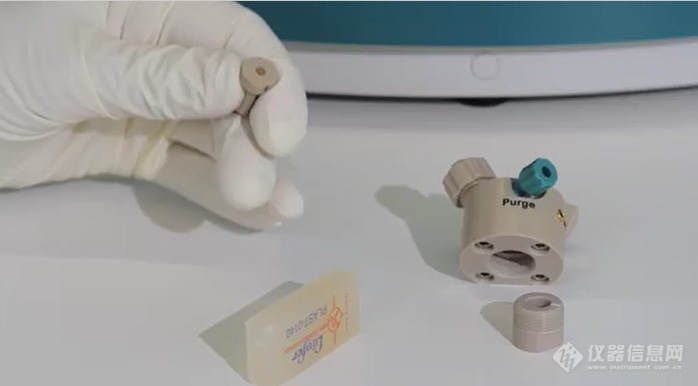
[font='times new roman'][size=16px]5.3.[/size][/font][font='times new roman'][size=16px]7[/size][/font][font='times new roman'][size=16px]安培检测器[/size][/font][font='times new roman'][size=16px]各部件[/size][/font][font='times new roman'][size=16px]的使用和维护[/size][/font][font='times new roman'][size=16px]安培检测器的应用非常广泛,[/size][/font][font='times new roman'][size=16px]灵敏度高,选择性好,结构简单,可以与多种色谱进行联用。但安培检测器,属于电化学检测器,稳定性和重复性相对较差,由于是三电极结构,任何一个发生变化,就会影响检测结果,尤其工作电极金属表面,易发生各种氧化还原反应,因此,要得到稳定可靠的结果,良好的使用习惯和保养非常重要。[/size][/font][font='times new roman'][size=16px]不同厂家[/size][/font][font='times new roman'][size=16px]的安培检测器原理并不完全一致,结构不一样,在具体的使用和维护上有所区别,下面介绍最常见的安培检测器的使用和维护。[/size][/font][font='times new roman'][size=16px]5.3.7.1[/size][/font][font='times new roman'][size=16px] [/size][/font][font='times new roman'][size=16px]热电安培检测器的使用和维护[/size][/font][font='times new roman'][size=16px]1 [/size][/font][font='times new roman'][size=16px]安培检测器[/size][/font][font='times new roman'][size=16px] [/size][/font][font='times new roman'][size=16px]在使用时注意,如果要插拔安培检测器,请先关闭电源,或者面板上关闭[/size][/font][font='times new roman'][size=16px]DC[/size][/font][font='times new roman'][size=16px]模块,[/size][/font][font='times new roman'][size=16px]再拔下;检测器[/size][/font][font='times new roman'][size=16px]插上后,再开电源,软件[/size][/font][font='times new roman'][size=16px]自动设别安培[/size][/font][font='times new roman'][size=16px]检测器模块。[/size][/font][font='times new roman'][size=16px]切忌在开电源情况下插拔[/size][/font][font='times new roman'][size=16px],[/size][/font][font='times new roman'][size=16px]否则,长期使用会损伤检测器。[/size][/font][font='times new roman'][size=16px]安培检测器的模块,在[/size][/font][font='times new roman'][size=16px]config[/size][/font][font='times new roman'][size=16px]中设置,[/size][/font][font='times new roman'][size=16px]一般插上后可以自动认出系列号,[/size][/font][font='times new roman'][size=16px]有个别情况无法识别系列号,[/size][/font][font='times new roman'][size=16px]有些可以继续使用,[/size][/font][font='times new roman'][size=16px]有些检测器就需要维修[/size][/font][font='times new roman'][size=16px]了[/size][/font][font='times new roman'][size=16px]。[/size][/font][font='times new roman'][size=16px]安培检测器[/size][/font][font='times new roman'][size=16px]运行[/size][/font][font='times new roman'][size=16px]必须绑定某个泵,其作用是[/size][/font][font='times new roman'][size=16px]一旦泵停了[/size][/font][font='times new roman'][size=16px],安培会自动关闭,保护工作电极和安培池。[/size][/font][font='times new roman'][size=16px]2[/size][/font][font='times new roman'][size=16px] [/size][/font][font='times new roman'][size=16px]安培池[/size][/font][font='times new roman'][size=16px]热电安培池与安培检测器有二根连接线,其中一[/size][/font][font='times new roman'][size=16px]个[/size][/font][font='times new roman'][size=16px]是连接参比电极,[/size][/font][font='times new roman'][size=16px]电极接头为[/size][/font][font='times new roman'][size=16px]M12 B[/size][/font][font='times new roman'][size=16px]型[/size][/font][font='times new roman'][size=16px](五孔)[/size][/font][font='times new roman'][size=16px],另一根为对电极和工作电极合用,[/size][/font][font='times new roman'][size=16px]接口为[/size][/font][font='times new roman'][size=16px]M12 A[/size][/font][font='times new roman'][size=16px]型[/size][/font][font='times new roman'][size=16px](四孔)[/size][/font][font='times new roman'][size=16px],对电极材料采用钛[/size][/font][font='times new roman'][size=16px]。[/size][/font][font='times new roman'][size=16px] [/size][/font][font='times new roman'][size=16px] [/size][/font][font='times new roman'][size=16px]安培池[/size][/font][font='times new roman'][size=16px]每次使用后,[/size][/font][font='times new roman'][size=16px]最好断开色谱柱,直接用超纯水冲洗数分钟,等于用超纯水保护工作电极和安培池表面处于无氧状态,[/size][/font][font='times new roman'][size=16px]不必拿下工作电极(如果无需打磨的话),[/size][/font][font='times new roman'][size=16px]这样,第二次可以继续使用,可以获得较低的背景[/size][/font][font='times new roman'][size=16px]、[/size][/font][font='times new roman'][size=16px]噪音、[/size][/font][font='times new roman'][size=16px]较快的平衡。[/size][/font][font='times new roman'][size=16px]如果需要[/size][/font][font='times new roman'][size=16px]取[/size][/font][font='times new roman'][size=16px]下工作电极,用超纯水清洗安培池表面,然后[/size][/font][font='times new roman'][size=16px]安装假体电极,拧上。[/size][/font][font='times new roman'][size=16px]长时间使用安培检测池后,表面可能会被污染,吸附污染物,肉眼可见,可以用干净的棉球沾水轻擦,也可以用合适溶剂清洗[/size][/font][font='times new roman'][size=16px]([/size][/font][font='times new roman'][size=16px]2molHNO[/size][/font][font='times new roman'][size=16px]3[/size][/font][font='times new roman'][size=16px])[/size][/font][font='times new roman'][size=16px]和超声等手段,再次使用往往需要稳定较长的时间。[/size][/font][font='times new roman'][size=16px]3[/size][/font][font='times new roman'][size=16px] [/size][/font][font='times new roman'][size=16px]工作电极[/size][/font][font='times new roman'][size=16px] [/size][/font][font='times new roman'][size=16px]最常用的工作电极为金电极和银电极,金电极稳定性好,相对维护保养较为容易,[/size][/font][font='times new roman'][size=16px]Ag[/size][/font][font='times new roman'][size=16px]电极活性强,维护保养的频率较高。[/size][/font][font='times new roman'][size=16px]工作电极抛光打磨需要专门的工具,热电有专门的打磨套装,其中包括粗粉和细[/size][/font][font='times new roman'][size=16px]粉[/size][/font][font='times new roman'][size=16px],粗粉为碳化硅,颗粒大小为[/size][/font][font='times new roman'][size=16px]2-3um[/size][/font][font='times new roman'][size=16px],细粉为[/size][/font][font='times new roman'][size=16px]α[/size][/font][font='times new roman'][size=16px]-[/size][/font][font='times new roman'][size=16px]氧化铝,颗粒大小直径为[/size][/font][font='times new roman'][size=16px]0.3-0.5um[/size][/font][font='times new roman'][size=16px],球形。[/size][/font][font='times new roman'][size=16px]需要注意的是,[/size][/font][font='times new roman'][size=16px]抛光粉有有效期,放置时间过长后,尤其细粉会聚合,影响抛光效果。[/size][/font][font='times new roman'][size=16px]抛光布的材料为人造丝是柔软、低绒毛的合成天鹅绒布。[/size][/font][font='times new roman'][size=16px]采用[/size][/font][font='times new roman'][size=16px]Buehler[/size][/font][font='times new roman'][size=16px] [/size][/font][font='times new roman'][size=16px]的[/size][/font][font='times new roman'][size=16px]MasterTex[/size][/font][font='times new roman'][size=16px],大小[/size][/font][font='times new roman'][size=16px]8[/size][/font][font='times new roman'][size=16px]英寸,背带胶。[/size][/font][img]https://ng1.17img.cn/bbsfiles/images/2021/11/202111231100028814_3829_1617661_3.jpeg[/img][img]https://ng1.17img.cn/bbsfiles/images/2021/11/202111231100033407_6292_1617661_3.jpeg[/img][font='times new roman'][size=16px]工作电极使用一定时间后需要抛光打磨,完整的抛光打磨步骤如下:[/size][/font][font='times new roman'][size=16px] [/size][/font][font='times new roman'][size=16px]先在抛光布上一角,滴上几滴超纯水,然后倒上少许[/size][/font][font='times new roman'][size=16px]粗粉(或者细[/size][/font][font='times new roman'][size=16px]粉[/size][/font][font='times new roman'][size=16px])[/size][/font][font='times new roman'][size=16px]抛光粉,弄成糊状。[/size][/font][font='times new roman'][size=16px]一、画“[/size][/font][font='times new roman'][size=16px]8[/size][/font][font='times new roman'][size=16px]”字[/size][/font][font='times new roman'][size=16px]7-8[/size][/font][font='times new roman'][size=16px]次;然后电极顺时针旋转[/size][/font][font='times new roman'][size=16px]90[/size][/font][font='times new roman'][size=16px]°,再画“[/size][/font][font='times new roman'][size=16px]8[/size][/font][font='times new roman'][size=16px]”字[/size][/font][font='times new roman'][size=16px]7-8[/size][/font][font='times new roman'][size=16px]次;然后顺时针旋转[/size][/font][font='times new roman'][size=16px]180[/size][/font][font='times new roman'][size=16px]°,再画“[/size][/font][font='times new roman'][size=16px]8[/size][/font][font='times new roman'][size=16px]”字[/size][/font][font='times new roman'][size=16px]7-8[/size][/font][font='times new roman'][size=16px]次。[/size][/font][font='times new roman'][size=16px]二、打磨之后用去离子水清洗干净[/size][/font][font='times new roman'][size=16px]如果电极污染比较严重,[/size][/font][font='times new roman'][size=16px]先粗粉[/size][/font][font='times new roman'][size=16px]后细[/size][/font][font='times new roman'][size=16px]粉[/size][/font][font='times new roman'][size=16px],当经常抛光的话,可直接用细粉。[/size][/font][font='times new roman'][size=16px]Ag[/size][/font][font='times new roman'][size=16px]电极抛光后的注意事项:[/size][/font][font='times new roman'][size=16px]工作电极经过“[/size][/font][font='times new roman'][size=16px]8[/size][/font][font='times new roman'][size=16px]”字打磨法后,表面活性较大,[url=https://insevent.instrument.com.cn/t/3p][color=#3333ff]离子色谱[/color][/url]基线背景值为负值,不建议马上直接使用,[/size][/font][font='times new roman'][size=16px]Ag[/size][/font][font='times new roman'][size=16px]工作电极的活性需要钝化。[/size][/font][font='times new roman'][size=16px]钝化方案:[/size][/font][font='times new roman'][size=16px]一、可直接空气中放置[/size][/font][font='times new roman'][size=16px]12h[/size][/font][font='times new roman'][size=16px]后使用。([/size][/font][font='times new roman'][size=16px]可提前打磨好工作电极,放置一晚上[/size][/font][font='times new roman'][size=16px])[/size][/font][font='times new roman'][size=16px]二、在超纯水中浸泡数分钟,装上安培池,不开电流,[/size][/font][font='times new roman'][size=16px]高浓度淋洗[/size][/font][font='times new roman'][size=16px]液[/size][/font][font='times new roman'][size=16px]平衡[/size][/font][font='times new roman'][size=16px]30[/size][/font][font='times new roman'][size=16px]分钟以上,开安培,用高浓度标样连续分析几次。[/size][/font][font='times new roman'][size=16px]Au[/size][/font][font='times new roman'][size=16px]电极抛光后的注意事项:[/size][/font][font='times new roman'][size=16px]Au[/size][/font][font='times new roman'][size=16px]比[/size][/font][font='times new roman'][size=16px]Ag[/size][/font][font='times new roman'][size=16px]稳定,[/size][/font][font='times new roman'][size=16px]但抛光后也不建议马上使用,先空开稳定一段时间。[/size][/font][font='times new roman'][size=16px]Au[/size][/font][font='times new roman'][size=16px]不像[/size][/font][font='times new roman'][size=16px]Ag[/size][/font][font='times new roman'][size=16px]稳定性差,[/size][/font][font='times new roman'][size=16px]不必每次抛光[/size][/font][font='times new roman'][size=16px],建议使用后,用超纯水清洗表面,真空封装。[/size][/font][font='times new roman'][size=16px]如果重复性[/size][/font][font='times new roman'][size=16px]RSD[/size][/font][font='times new roman'][size=16px]变差,需要再次抛光,可直接用[/size][/font][font='times new roman'][size=16px]细粉[/size][/font][font='times new roman'][size=16px]。[/size][/font][font='times new roman'][size=16px]如抛光后[/size][/font][font='times new roman'][size=16px]不[/size][/font][font='times new roman'][size=16px]马上使用,可真空封装,等用时[/size][/font][font='times new roman'][size=16px]再启封[/size][/font][font='times new roman'][size=16px],避免空气的干扰[/size][/font][font='times new roman'][size=16px]。[/size][/font][font='times new roman'][size=16px]4[/size][/font][font='times new roman'][size=16px] [/size][/font][font='times new roman'][size=16px]参比电极[/size][/font][font='times new roman'][size=16px]A [/size][/font][font='times new roman'][size=16px] [/size][/font][font='times new roman'][size=16px]pH[/size][/font][font='times new roman'][size=16px]的校正[/size][/font][font='times new roman'][size=16px] [/size][/font][font='times new roman'][size=16px]目前热电安培检测器的参比电极采用[/size][/font][font='times new roman'][size=16px]pH-Ag/[/size][/font][font='times new roman'][size=16px]AgCl[/size][/font][font='times new roman'][size=16px]复合参比电极,其中[/size][/font][font='times new roman'][size=16px]pH[/size][/font][font='times new roman'][size=16px]电极部分,在使用一段时间后需要校正。[/size][/font][font='times new roman'][size=16px]对于[/size][/font][font='times new roman'][size=16px]pH[/size][/font][font='times new roman'][size=16px]校正,采用二点校正的方式,其中[/size][/font][font='times new roman'][size=16px]第一[/size][/font][font='times new roman'][size=16px]点为[/size][/font][font='times new roman'][size=16px]pH=7.0[/size][/font][font='times new roman'][size=16px],再校正第二点([/size][/font][font='times new roman'][size=16px]一般为[/size][/font][font='times new roman'][size=16px]pH4[/size][/font][font='times new roman'][size=16px]或者[/size][/font][font='times new roman'][size=16px]10[/size][/font][font='times new roman'][size=16px]),国标中关于校正的[/size][/font][font='times new roman'][size=16px]pH[/size][/font][font='times new roman'][size=16px]缓冲溶液不适合安培检测器的校正,需要采用美国标准的[/size][/font][font='times new roman'][size=16px]pH[/size][/font][font='times new roman'][size=16px]缓冲溶液,可以在[/size][/font][font='times new roman'][size=16px]淘宝上[/size][/font][font='times new roman'][size=16px]购买到[/size][/font][font='times new roman'][size=16px]pH4[/size][/font][font='times new roman'][size=16px],[/size][/font][font='times new roman'][size=16px]7[/size][/font][font='times new roman'][size=16px],或者[/size][/font][font='times new roman'][size=16px]10[/size][/font][font='times new roman'][size=16px]的标准溶液。[/size][/font]? [font='times new roman'][size=16px]步骤:[/size][/font][font='times new roman'][size=16px]关掉安培电压,关闭泵停留,拧开参比电极与安培池的连接。[/size][/font][font='times new roman'][size=16px]用[/size][/font][font='times new roman'][size=16px]18.2M[/size][/font][font='times new roman'][size=16px]兆欧[/size][/font][font='times new roman'][size=16px]超纯[/size][/font][font='times new roman'][size=16px]水清洗电极,除去任何盐成分。[/size][/font][font='times new roman'][size=16px]将参比电极与安培检测器连接。[/size][/font][font='times new roman'][size=16px]用[/size][/font][font='times new roman'][size=16px]pH7.0 [/size][/font][font='times new roman'][size=16px]缓冲溶液浸泡,稳定一分钟以上,数字变化小于[/size][/font][font='times new roman'][size=16px]0.05[/size][/font][font='times new roman'][size=16px],然后按下[/size][/font][font='times new roman'][size=16px] [/size][/font][font='times new roman'][size=16px]Offset Cal.[/size][/font][font='times new roman'][size=16px]通过后,移走缓冲溶液,用水清洗,并用滤纸吸干电极,将电极浸泡到第二个溶液稳定一分钟以上,变化小于[/size][/font][font='times new roman'][size=16px]0.05[/size][/font][font='times new roman'][size=16px]。[/size][/font][font='times new roman'][size=16px]在[/size][/font][font='times new roman'][size=16px] pH Slope Buffer Value[/size][/font][font='times new roman'][size=16px]输入被校正[/size][/font][font='times new roman'][size=16px]pH[/size][/font][font='times new roman'][size=16px]值,然后按下[/size][/font][font='times new roman'][size=16px]Slope Cal[/size][/font][font='times new roman'][size=16px].[/size][/font][font='times new roman'][size=16px]校正通过后,[/size][/font][font='times new roman'][size=16px]Download [/size][/font][font='times new roman'][size=16px]到[/size][/font][font='times new roman'][size=16px] current[/size][/font][font='times new roman'][size=16px],并保存。[/size][/font][img]" style="max-width: 100% max-height: 100% [/img][img]" style="max-width: 100% max-height: 100% [/img][font='times new roman'][size=16px]由于[/size][/font][font='times new roman'][size=16px]糖分析[/size][/font][font='times new roman'][size=16px]的[/size][/font][font='times new roman'][size=16px]NaOH[/size][/font][font='times new roman'][size=16px] pH[/size][/font][font='times new roman'][size=16px]都高于[/size][/font][font='times new roman'][size=16px]10[/size][/font][font='times new roman'][size=16px],建议采用[/size][/font][font='times new roman'][size=16px]pH12.45 [/size][/font][font='times new roman'][size=16px]的标准缓冲液来校正。[/size][/font][font='times new roman'][size=16px]热电变色龙[/size][/font][font='times new roman'][size=16px]6.8[/size][/font][font='times new roman'][size=16px]和[/size][/font][font='times new roman'][size=16px]7[/size][/font][font='times new roman'][size=16px]系列的软件,在[/size][/font][font='times new roman'][size=16px]pH[/size][/font][font='times new roman'][size=16px]校正中软件有一个[/size][/font][font='times new roman'][size=16px]bug[/size][/font][font='times new roman'][size=16px],就是无法支持第三个安培检测器,也就是说,[/size][/font][font='times new roman'][size=16px]ICS3000/5000/5000+/6000[/size][/font][font='times new roman'][size=16px]系列,当[url=https://insevent.instrument.com.cn/t/3p][color=#3333ff]离子色谱[/color][/url]使用第三个安培检测器进行校正(已经用了二个),[/size][/font][font='times new roman'][size=16px]pH 7.0[/size][/font][font='times new roman'][size=16px]的校正无法通过,但可以使用默认值,唯一的解决方案是重新安装软件,或者换电脑,校正的记录直接写到安培检测器中。不过,这种情况在普通用户身上不会出现。[/size][/font][font='times new roman'][size=16px]严格上[/size][/font][font='times new roman'][size=16px]连续使用,[/size][/font][font='times new roman'][size=16px]每二周进行一次校正。[/size][/font][font='times new roman'][size=16px]B [/size][/font][font='times new roman'][size=16px]参比电极的维护和保存:[/size][/font]? [font='times new roman'][size=16px]每次使用后,[/size][/font][font='times new roman'][size=16px]从仪器上卸下来,[/size][/font][font='times new roman'][size=16px]先[/size][/font][font='times new roman'][size=16px]用水清洗后,[/size][/font][font='times new roman'][size=16px]后[/size][/font][font='times new roman'][size=16px]保存[/size][/font][font='times new roman'][size=16px]在饱和[/size][/font][font='times new roman'][size=16px]KCl[/size][/font][font='times new roman'][size=16px]溶液,体积不得少于三分之二,参比电极不得干涸。[/size][/font]? [font='times new roman'][size=16px]如果干涸,用[/size][/font][font='times new roman'][size=16px]1MKCl[/size][/font][font='times new roman'][size=16px]和[/size][/font][font='times new roman'][size=16px]1MHCl[/size][/font][font='times new roman'][size=16px]再生活化,但干涸将损伤膜。[/size][/font]? [font='times new roman'][size=16px]参比电极,接触面为玻璃,安装时注意反压,否则会压破电极。[/size][/font]? [font='times new roman'][size=16px]当参比电极不用时,最好一直保存在饱和[/size][/font][font='times new roman'][size=16px]KCl[/size][/font][font='times new roman'][size=16px]溶液中。[/size][/font]? [font='times new roman'][size=16px]饱和氯化钾溶液需要定期更换[/size][/font][font='times new roman'][size=16px],每使用一次参比电极更换一次[/size][/font][font='times new roman'][size=16px]。[/size][/font]? [font='times new roman'][size=16px]参比电极([/size][/font][font='times new roman'][size=16px]Ag/[/size][/font][font='times new roman'][size=16px]AgCl[/size][/font][font='times new roman'][size=16px])是有寿命的,建议备用一个。[/size][/font]? [font='times new roman'][size=16px]长时间使用后,基线平衡时间延长,[/size][/font][font='times new roman'][size=16px]pH[/size][/font][font='times new roman'][size=16px]显示不正确,需要重新校正,如果无法校正,则必须更换参比电极。[/size][/font]? [font='times new roman'][size=16px]pH[/size][/font][font='times new roman'][size=16px]电极变化,峰面积会变小,稳定时间延长,噪音变大,则需要重新校正。[/size][/font][font='times new roman'][size=16px]5 [/size][/font][font='times new roman'][size=16px]膜片[/size][/font][font='times new roman'][size=16px] [/size][/font][font='times new roman'][size=16px]膜片虽然不是一次性的,但也不能无限期使用,具体有效使用时间,并没有明确的规定。[/size][/font][font='times new roman'][size=16px]如果膜片使用不当,断裂破损的话需要更换,变[/size][/font][font='times new roman'][size=16px]绉[/size][/font][font='times new roman'][size=16px]可能引起漏液也需要更换。如果使用时间较长,噪音一直降不下来,可考虑更换膜片试试。虽然,大部分的情况下膜片对安培测试结果的影响较小。[/size][/font][font='times new roman'][size=16px]膜片有国产替代品,如果自己设计[/size][/font][font='times new roman'][size=16px]DIY[/size][/font][font='times new roman'][size=16px]也不难。[/size][/font][font='times new roman'][size=16px]5.3.7.[/size][/font][font='times new roman'][size=16px]2[/size][/font][font='times new roman'][size=16px] [/size][/font][font='times new roman'][size=16px]万通[/size][/font][font='times new roman'][size=16px]安培检测器的使用和维护[/size][/font][font='times new roman'][size=16px]1[/size][/font][font='times new roman'][size=16px]. [/size][/font][font='times new roman'][size=16px]工作电极的清洗[/size][/font][font='times new roman'][size=16px]电极属于消耗材料,在电极[/size][/font][font='times new roman'][size=16px]未严重[/size][/font][font='times new roman'][size=16px]腐蚀的情况下,通过抛光可以使其重新恢复原始电极活性。通过抛光可以除去金属表面的氧化物和污染物,使电极恢复活性。[/size][/font][font='times new roman'][size=16px]([/size][/font][font='times new roman'][size=16px]电极长期使用后,电极金属被消耗,将无法再使用。[/size][/font][font='times new roman'][size=16px])[/size][/font][font='times new roman'][size=16px]根据表面污染程度,按以下顺序选择相应的清洁方式:[/size][/font][font='times new roman'][size=16px]使用橡皮擦[/size][/font][font='times new roman'][size=16px]使用抛光套件[/size][/font][font='times new roman'][size=16px] 6.2802.000 [/size][/font][font='times new roman'][size=16px]的氧化铝粉末[/size][/font][font='times new roman'][size=16px]使用保养套件[/size][/font][font='times new roman'][size=16px] 6.2802.200 [/size][/font][font='times new roman'][size=16px]打磨平整[/size][/font][font='times new roman'][size=16px]针对新的[/size][/font][font='times new roman'][size=16px]玻[/size][/font][font='times new roman'][size=16px]碳和铂工作电极,建议首次使用时借助氧化铝粉末进行激活。[/size][/font][font='times new roman'][size=16px]1[/size][/font][font='times new roman'][size=16px])[/size][/font][font='times new roman'][size=16px] [/size][/font][font='times new roman'][size=16px]使用橡皮擦[/size][/font][img]https://ng1.17img.cn/bbsfiles/images/2021/11/202111231100035650_4292_1617661_3.png[/img][font='times new roman'][size=16px]2[/size][/font][font='times new roman'][size=16px])[/size][/font][font='times new roman'][size=16px]使用抛光套件[/size][/font][font='times new roman'][size=16px] 6.2802.000 [/size][/font][font='times new roman'][size=16px]的氧化铝粉末[/size][/font][font='times new roman'][size=16px]1[/size][/font][font='times new roman'][size=16px]将抛光套件[/size][/font][font='times new roman'][size=16px] 6.2802.000 [/size][/font][font='times new roman'][size=16px]的氧化铝粉末与蒸馏水混合,使其成为稠糊状。[/size][/font][img]https://ng1.17img.cn/bbsfiles/images/2021/11/202111231100039627_1147_1617661_3.png[/img][font='times new roman'][size=16px]2[/size][/font][font='times new roman'][size=16px])[/size][/font][font='times new roman'][size=16px]以八字形运动对电极头进行大约[/size][/font][font='times new roman'][size=16px] 10 [/size][/font][font='times new roman'][size=16px]秒的抛光操作。[/size][/font][img]https://ng1.17img.cn/bbsfiles/images/2021/11/202111231100038990_3297_1617661_3.png[/img][size=16px]3[/size][size=16px])[/size][size=16px]用蒸馏水冲洗。[/size][img]https://ng1.17img.cn/bbsfiles/images/2021/11/202111231100040211_9578_1617661_3.png[/img][align=left][size=16px]2[/size][size=16px]. [/size][size=16px]清洁[/size][size=16px]对([/size][size=16px]辅助[/size][size=16px])[/size][size=16px]电极[/size][/align][align=left][size=16px]1[/size][size=16px])[/size][size=16px]先将工作电极和[/size][size=16px]参比电极都[/size][size=16px]从[/size][size=16px]检测[/size][size=16px]池中取出[/size][size=16px]后[/size][size=16px],[/size][size=16px]可清洁辅助电极。[/size][size=16px]2[/size][size=16px])[/size][size=16px]将柔软纸巾或棉签浸渍在[/size][size=16px] 2 [/size][size=16px]mol[/size][size=16px]/L [/size][size=16px]的硝酸中[/size][size=16px],[/size][size=16px]小心地擦拭电极。[/size][size=16px]3[/size][size=16px])[/size][size=16px] [/size][size=16px]然后用超纯水彻底冲洗测量池,并用无绒毛的干燥布巾擦干。[/size][size=16px]注意:[/size][size=16px]如果硝酸不能[/size][size=16px]有效[/size][size=16px]地清洁,可用在铝浆中浸渍过的棉签擦拭辅助电极。[/size][size=16px]使用该清[/size][size=16px]洁方法时,[/size][size=16px]需要拆开[/size][size=16px]检测[/size][size=16px]池,取下工作电极和参比电极[/size][size=16px],[/size][size=16px]同时取下透明的间隔板。[/size][/align][img]https://ng1.17img.cn/bbsfiles/images/2021/11/202111231100041148_4704_1617661_3.png[/img][align=left][size=16px]3[/size][size=16px]. [/size][size=16px]参比电极使用注意事项[/size][/align][align=left]1) [size=16px]不能打磨或擦拭参比电极[/size][/align][align=left]2) [size=16px]不能接触强酸[/size][/align][align=left]3) [size=16px]不能接触强还原剂[/size][/align][align=left]4) [size=16px]不能超声[/size][/align][align=left]5) [size=16px]只能接在参比接口处[/size][/align][align=left]6) [size=16px]适用于碱性溶液([/size][size=16px]pH 8 - 14[/size][size=16px])[/size][/align][align=left]7) [size=16px]清洗[/size][size=16px]:纯水冲洗电极表面[/size][size=16px] [/size][/align][align=left]8) [size=16px]建议每天检测一次核查用的标品[/size][/align][font='times new roman'][size=16px]5.3.8 [/size][/font][font='times new roman'][size=16px]安培检测器的故障判断和注意事项[/size][/font][font='times new roman'][size=16px]A[/size][/font][font='times new roman'][size=16px])[/size][/font][font='times new roman'][size=16px]基线噪声[/size][/font][font='times new roman'][size=16px]变大[/size][/font][font='times new roman'][size=16px]1 [/size][/font][font='times new roman'][size=16px]泵压不稳,[/size][/font][font='times new roman'][size=16px]有脉动,[/size][/font][font='times new roman'][size=16px]即使压力显示波动只有[/size][/font][font='times new roman'][size=16px]0.1Mpa[/size][/font][font='times new roman'][size=16px],[/size][/font][font='times new roman'][size=16px] [/size][/font][font='times new roman'][size=16px]基线噪声[/size][/font][font='times new roman'][size=16px]也会[/size][/font][font='times new roman'][size=16px]变大,原因可能是压力混合器故障,额外增加阻尼器可能会降低噪声[/size][/font][font='times new roman'][size=16px],或者维修泵[/size][/font][font='times new roman'][size=16px]。[/size][/font]2 [font='times new roman'][size=16px]泵管路或检测池有气泡,会造成基线有规律波动,排气泡,或者增加背压[/size][/font]3 [font='times new roman'][size=16px]参比电极偏移,[/size][/font][font='times new roman'][size=16px]pH[/size][/font][font='times new roman'][size=16px]不对,校正[/size][/font][font='times new roman'][size=16px]pH[/size][/font][font='times new roman'][size=16px]值[/size][/font][font='times new roman'][size=16px]或更换参比电极[/size][/font][font='times new roman'][size=16px]。[/size][/font]4 [font='times new roman'][size=16px]安培池表面被污染,清洗安培池表面[/size][/font][font='times new roman'][size=16px]。[/size][/font]5 [font='times new roman'][size=16px]工作电极被污染或者没钝化,重新抛光电极或钝化电极[/size][/font]6 [font='times new roman'][size=16px]长期使用膜片污染,更换新的膜片。[/size][/font]7 [font='times new roman'][size=16px]流动相脱气不够,有氧存在,脱气或加氮气保护。[/size][/font][font='times new roman'][size=16px]B) [/size][/font][font='times new roman'][size=16px]基线漂移[/size][/font]1 [font='times new roman'][size=16px]工作电极[/size][/font][font='times new roman'][size=16px]或安培池[/size][/font][font='times new roman'][size=16px]未稳定,继续平衡[/size][/font]2 [font='times new roman'][size=16px] [/size][/font][font='times new roman'][size=16px]参比电极偏移,[/size][/font][font='times new roman'][size=16px]pH[/size][/font][font='times new roman'][size=16px]不对,校正[/size][/font][font='times new roman'][size=16px]pH[/size][/font][font='times new roman'][size=16px]值。[/size][/font]3 [font='times new roman'][size=16px]工作电极被污染或者没钝化,重新抛光电极或钝化电极[/size][/font]4 [font='times new roman'][size=16px]参比电极内溶液干涸,重新活化参比。[/size][/font]5 [font='times new roman'][size=16px]温度变化,控制温度波动。[/size][/font][font='times new roman'][size=16px] C[/size][/font][font='times new roman'][size=16px])[/size][/font][font='times new roman'][size=16px] [/size][/font][font='times new roman'][size=16px]灵敏度[/size][/font][font='times new roman'][size=16px]降低[/size][/font][font='times new roman'][size=16px]1 [/size][/font][font='times new roman'][size=16px]工作电位设置是否正确[/size][/font][font='times new roman'][size=16px]2 [/size][/font][font='times new roman'][size=16px]工作电极被污染,重新抛光[/size][/font][font='times new roman'][size=16px]3 [/size][/font][font='times new roman'][size=16px]检查工作电极表面,是否凹陷,如有更换电极[/size][/font][font='times new roman'][size=16px]4[/size][/font][font='times new roman'][size=16px]参比电极偏移,重新校正,如不行,更换参比电极[/size][/font][font='times new roman'][size=16px]5[/size][/font][font='times new roman'][size=16px]是否变换了膜片,注意厚度变化[/size][/font]6 [font='times new roman'][size=16px]样品分解,例如糖保存不好,浓度降低,峰面积变小[/size][/font]7 [font='times new roman'][size=16px]检查工作电极[/size][/font][font='times new roman'][size=16px]是否选择错误[/size][/font][font='times new roman'][size=16px]D[/size][/font][font='times new roman'][size=16px])[/size][/font][font='times new roman'][size=16px] [/size][/font][font='times new roman'][size=16px]检测背景高[/size][/font][font='times new roman'][size=16px]1 [/size][/font][font='times new roman'][size=16px]试剂纯度和浓度比例是否正确,例如[/size][/font][font='times new roman'][size=16px]CO[/size][/font][font='times new roman'][size=16px]2[/size][/font][font='times new roman'][size=16px]的干扰[/size][/font][font='times new roman'][size=16px]。[/size][/font][font='times new roman'][size=16px]2 [/size][/font][font='times new roman'][size=16px]长时间使用,工作电极污染[/size][/font][font='times new roman'][size=16px],重新抛光[/size][/font][font='times new roman'][size=16px]3 [/size][/font][font='times new roman'][size=16px]参比电极故障,电位变化或者[/size][/font][font='times new roman'][size=16px]pH[/size][/font][font='times new roman'][size=16px]改变,校正或者更换。[/size][/font][font='times new roman'][size=16px]4 [/size][/font][font='times new roman'][size=16px]安培池表面污染,电极表面处理[/size][/font][font='times new roman'][size=16px]E[/size][/font][font='times new roman'][size=16px])[/size][/font][font='times new roman'][size=16px] [/size][/font][font='times new roman'][size=16px]重复性差[/size][/font][font='times new roman'][size=16px]1 [/size][/font][font='times new roman'][size=16px]参比电极不稳,[/size][/font][font='times new roman'][size=16px]pH[/size][/font][font='times new roman'][size=16px]不对,重新校正或者更换。[/size][/font][font='times new roman'][size=16px]2 [/size][/font][font='times new roman'][size=16px]工作电极表面污染,重新抛光打磨或钝化[/size][/font][font='times new roman'][size=16px]3 [/size][/font][font='times new roman'][size=16px]样品分解,例如[/size][/font][font='times new roman'][size=16px],[/size][/font][font='times new roman'][size=16px]低浓度的糖[/size][/font][font='times new roman'][size=16px]4 [/size][/font][font='times new roman'][size=16px]自动或者手动进样不准,或者进样器有故障[/size][/font][font='times new roman'][size=16px]F[/size][/font][font='times new roman'][size=16px])[/size][/font][font='times new roman'][size=16px] pH[/size][/font][font='times new roman'][size=16px]偏高[/size][/font][font='times new roman'][size=16px]1[/size][/font][font='times new roman'][size=16px] [/size][/font][font='times new roman'][size=16px] [/size][/font][font='times new roman'][size=16px]pH[/size][/font][font='times new roman'][size=16px]重新校正[/size][/font][font='times new roman'][size=16px],如不行[/size][/font][font='times new roman'][size=16px]更换[/size][/font][font='times new roman'][size=16px]。[/size][/font][font='times new roman'][size=16px]2 [/size][/font][font='times new roman'][size=16px]参比电极内溶液干涸[/size][/font][font='times new roman'][size=16px],重新活化再生[/size][/font][font='times new roman'][size=16px]3 [/size][/font][font='times new roman'][size=16px]参比电极失效[/size][/font][font='times new roman'][size=16px],更换参比[/size][/font]
请问各位大侠,有没有哪个厂家的液相色谱带有脉冲安培检测器,除了戴安之外,戴安的有点贵。请提示,谢谢谢谢啦
要用[url=https://insevent.instrument.com.cn/t/3p][color=#3333ff]离子色谱[/color][/url]检测糖,原来测定其他项目用的电导池,现在要换成安培检测。但工作站的控制面板上检测器那块积分安培栏输不了电压数据,参比电极那块也不能操作,而检测器液晶面板上显示的也是电导池的数据,用LOCAL方式把界面改成积分安培模式了,一接工作站就变回了电导模式,请教各位老师怎么办?我刚接触[url=https://insevent.instrument.com.cn/t/3p][color=#3333ff]离子色谱[/color][/url],好多不懂的,急!
[size=3]分析者对待测离子应有一些一般信息,首先应了解待测化合物的分子结构和性质以及样品的基体情况,如无机还是有机离子,离子的电荷数,是酸还是碱,亲水还是疏水,是否为表面活性化合物等。待测离子的疏水性和水合能是决定选用何种分离方式的主要因素。水合能高和疏水性弱的离子,如Cl-或K+,最好用 HPIC分离。水合能低和疏水性强的离子,如高氯酸(ClO4-)或四丁基铵,最好用亲水性强的离子交换分离柱或MPIC分离。有一定疏水性也有明显水合能的pKa值在1与7之间的离子,如乙酸盐或丙酸盐,最好用HPICE分离。有些离子,既可用阴离子交换分离,也可用阳离子交换分离,如氨基酸,生物碱和过渡金属等。 很多离子可用多种检测方式。例如测定过渡金属时,可用单柱法直接用电导或脉冲安培检测器,也可用柱后衍生反应,使金属离子与 PAR或其它显色剂作用,再用UV/VIS检测。一般的规律是:对无紫外或可见吸收以及强离解的酸和碱,最好用电导检测器 具有电化学活性和弱离解的离子,最好用安培检测器 对离子本身或通过柱后反应后生成的络合物在紫外可见有吸收或能产生荧光的离子和化合物,最好用UV/VIS或荧光检测器。若对所要解决的问题有几种方案可选择,分析方案的确定主要由基体的类型、选择性、过程的复杂程度以及是否经济来决定。表1和2总结了对各种类型离子可选用的分离方式和检测方式。 [url=https://insevent.instrument.com.cn/t/3p][color=#3333ff]离子色谱[/color][/url]柱填料的发展推动了[url=https://insevent.instrument.com.cn/t/3p][color=#3333ff]离子色谱[/color][/url]应用的快速发展,对多种离子分析方法的开发提供了多种可能性。特别应提出的是在pH 0-14的水溶液和100%有机溶剂(反相高效液相色谱用有机溶剂)中稳定的亲水性高效高容量柱填料的商品化,使得离子交换分离的应用范围更加扩大。常见的在水溶液中以离子形态存在的离子,包括无机和有机离子,以弱酸的盐(Na2CO3/NaHCO3, KOH、NaOH)或强酸(H2SO4、甲基磺酸、HNO3、HCl)为流动相,阴离子交换或阳离子交换分离,电导检测,已是成熟的方法,有成熟的色谱条件可参照。对近中性的水可溶的有机“大”分子(相对常见的小分子而言),若待测化合物为弱酸,则由于弱酸在强碱性溶液中会以阴离子形态存在,因此选用较强的碱为流动相,阴离子交换分离 若待测化合物为弱碱,则由于在强酸性溶液中会以阳离子形态存在,选用较强的酸作流动相,阳离子交换分离 若待测离子的疏水性较强,由于与固定相之间的吸附作用而使保留时间较长或峰拖尾,则可在流动相中加入适量有机溶剂,减弱吸附,缩短保留时间、改善峰形和选择性。对该类化合物的分离也可选用离子对色谱分离,但流动相中一般含有较复杂的离子对试剂。此外,对弱保留离子可选用高容量柱和弱淋洗液以增强保留,对强保留离子则反之。在水溶液中以离子形态存在的离子,即较强的酸或碱,应选用电导检测。具有对紫外或可见光有吸收基团或经柱后衍生反应后(IC中较少用柱前衍生)生成有吸光基团的化合物,选用光学检测器。具有在外加电压下可发生氧化或还原反应基团的化合物,可选用直流安培或脉冲安培检测。对一些复杂样品,为了一次进样得到较多的信息,可将两种或三种检测器串联使用。[/size]
[b][url=https://insevent.instrument.com.cn/t/3p][color=#3333ff]离子色谱[/color][/url]分离方式和检测方式的选择[/b]分析者对待测离子应有一些一般信息,首先应了解待测化合物的分子结构和性质以及样品的基体情况,如无机还是有机离子,离子的电荷数,是酸还是碱,亲水还是疏水,是否为表面活性化合物等。待测离子的疏水性和水合能是决定选用何种分离方式的主要因素。水合能高和疏水性弱的离子,如Cl-或K+,最好用HPIC分离。水合能低和疏水性强的离子,如高氯酸(ClO4-)或四丁基铵,最好用亲水性强的离子交换分离柱或MPIC分离。有一定疏水性也有明显水合能的pKa值在1与7之间的离子,如乙酸盐或丙酸盐,最好用HPICE分离。有些离子,既可用阴离子交换分离,也可用阳离子交换分离,如氨基酸,生物碱和过渡金属等。 很多离子可用多种检测方式。例如测定过渡金属时,可用单柱法直接用电导或脉冲安培检测器,也可用柱后衍生反应,使金属离子与PAR或其它显色剂作用,再用UV/VIS检测。一般的规律是:对无紫外或可见吸收以及强离解的酸和碱,最好用电导检测器;具有电化学活性和弱离解的离子,最好用安培检测器;对离子本身或通过柱后反应后生成的络合物在紫外可见有吸收或能产生荧光的离子和化合物,最好用UV/VIS或荧光检测器。若对所要解决的问题有几种方案可选择,分析方案的确定主要由基体的类型、选择性、过程的复杂程度以及是否经济来决定。表1和2总结了对各种类型离子可选用的分离方式和检测方式。 [url=https://insevent.instrument.com.cn/t/3p][color=#3333ff]离子色谱[/color][/url]柱填料的发展推动了[url=https://insevent.instrument.com.cn/t/3p][color=#3333ff]离子色谱[/color][/url]应用的快速发展,对多种离子分析方法的开发提供了多种可能性。特别应提出的是在pH 0-14的水溶液和100%有机溶剂(反相高效液相色谱用有机溶剂)中稳定的亲水性高效高容量柱填料的商品化,使得离子交换分离的应用范围更加扩大。常见的在水溶液中以离子形态存在的离子,包括无机和有机离子,以弱酸的盐(Na2CO3/NaHCO3, KOH、NaOH)或强酸(H2SO4、甲基磺酸、HNO3、HCl)为流动相,阴离子交换或阳离子交换分离,电导检测,已是成熟的方法,有成熟的色谱条件可参照。对近中性的水可溶的有机“大”分子(相对常见的小分子而言),若待测化合物为弱酸,则由于弱酸在强碱性溶液中会以阴离子形态存在,因此选用较强的碱为流动相,阴离子交换分离;若待测化合物为弱碱,则由于在强酸性溶液中会以阳离子形态存在,选用较强的酸作流动相,阳离子交换分离;若待测离子的疏水性较强,由于与固定相之间的吸附作用而使保留时间较长或峰拖尾,则可在流动相中加入适量有机溶剂,减弱吸附,缩短保留时间、改善峰形和选择性。对该类化合物的分离也可选用离子对色谱分离,但流动相中一般含有较复杂的离子对试剂。此外,对弱保留离子可选用高容量柱和弱淋洗液以增强保留,对强保留离子则反之。在水溶液中以离子形态存在的离子,即较强的酸或碱,应选用电导检测。具有对紫外或可见光有吸收基团或经柱后衍生反应后(IC中较少用柱前衍生)生成有吸光基团的化合物,选用光学检测器。具有在外加电压下可发生氧化或还原反应基团的化合物,可选用直流安培或脉冲安培检测。对一些复杂样品,为了一次进样得到较多的信息,可将两种或三种检测器串联使用。资料来源:www.zyzwtp.com
分析者对待测离子应有一些一般信息,首先应了解待测化合物的分子结构和性质以及样品的基体情况,如无机还是有机离子,离子的电荷数,是酸还是碱,亲水还是疏水,是否为表面活性化合物等。待测离子的疏水性和水合能是决定选用何种分离方式的主要因素。水合能高和疏水性弱的离子,如Cl-或K+,最好用HPIC分离。水合能低和疏水性强的离子,如高氯酸(ClO4-)或四丁基铵,最好用亲水性强的离子交换分离柱或MPIC分离。有一定疏水性也有明显水合能的pKa值在1与7之间的离子,如乙酸盐或丙酸盐,最好用HPICE分离。有些离子,既可用阴离子交换分离,也可用阳离子交换分离,如氨基酸,生物碱和过渡金属等。 很多离子可用多种检测方式。例如测定过渡金属时,可用单柱法直接用电导或脉冲安培检测器,也可用柱后衍生反应,使金属离子与PAR或其它显色剂作用,再用UV/VIS检测。一般的规律是:对无紫外或可见吸收以及强离解的酸和碱,最好用电导检测器;具有电化学活性和弱离解的离子,最好用安培检测器;对离子本身或通过柱后反应后生成的络合物在紫外可见有吸收或能产生荧光的离子和化合物,最好用UV/VIS或荧光检测器。若对所要解决的问题有几种方案可选择,分析方案的确定主要由基体的类型、选择性、过程的复杂程度以及是否经济来决定。表1和2总结了对各种类型离子可选用的分离方式和检测方式。 [url=https://insevent.instrument.com.cn/t/3p][color=#3333ff]离子色谱[/color][/url]柱填料的发展推动了[url=https://insevent.instrument.com.cn/t/3p][color=#3333ff]离子色谱[/color][/url]应用的快速发展,对多种离子分析方法的开发提供了多种可能性。特别应提出的是在pH 0-14的水溶液和100%有机溶剂(反相高效液相色谱用有机溶剂)中稳定的亲水性高效高容量柱填料的商品化,使得离子交换分离的应用范围更加扩大。常见的在水溶液中以离子形态存在的离子,包括无机和有机离子,以弱酸的盐(Na2CO3/NaHCO3, KOH、NaOH)或强酸(H2SO4、甲基磺酸、HNO3、HCl)为流动相,阴离子交换或阳离子交换分离,电导检测,已是成熟的方法,有成熟的色谱条件可参照。对近中性的水可溶的有机“大”分子(相对常见的小分子而言),若待测化合物为弱酸,则由于弱酸在强碱性溶液中会以阴离子形态存在,因此选用较强的碱为流动相,阴离子交换分离;若待测化合物为弱碱,则由于在强酸性溶液中会以阳离子形态存在,选用较强的酸作流动相,阳离子交换分离;若待测离子的疏水性较强,由于与固定相之间的吸附作用而使保留时间较长或峰拖尾,则可在流动相中加入适量有机溶剂,减弱吸附,缩短保留时间、改善峰形和选择性。对该类化合物的分离也可选用离子对色谱分离,但流动相中一般含有较复杂的离子对试剂。此外,对弱保留离子可选用高容量柱和弱淋洗液以增强保留,对强保留离子则反之。在水溶液中以离子形态存在的离子,即较强的酸或碱,应选用电导检测。具有对紫外或可见光有吸收基团或经柱后衍生反应后(IC中较少用柱前衍生)生成有吸光基团的化合物,选用光学检测器。具有在外加电压下可发生氧化或还原反应基团的化合物,可选用直流安培或脉冲安培检测。对一些复杂样品,为了一次进样得到较多的信息,可将两种或三种检测器串联使用。
脉冲安培检测器一般被用来检测糖和氨基酸,那么它对一般的阳离子和阴离子,如Na离子Cl离子这些有没有响应?高手请指教。